OpenSCADA program description
Author: Roman Savochenko, Maxim Lysenko (2012)
Introduction
This document is a description of the "open source" project called "OpenSCADA". OpenSCADA is a SCADA system built on the principles of modularity, scalability and multiple OS/Hardware integration.
As a policy the development of the system utilized "open source" principles. This choice allowed for the creation of a reliable and publicly available SCADA system. At the same time bringing together a significant number of product developers, enthusiasts and other stake holders to develop, test, and disseminate the project, thus minimizing the financial and distribution costs.
OpenSCADA is designed for the collection and archiving of system data plus the visualization and controlling of process operations typical of SCADA systems. Due to the level of scalability and modularization the system can be used in a variety of applications.
OpenSCADA can be used:
- at industrial facilities as a full featured SCADA system;
- in embedded devices, as an execution environment, including within a PLC (programmable logic controller);
- to build technological, chemical, physical or electrical processes models;
- at data centers or other server facilities to collect, process, present and archive data regarding the PCs, servers and clusters and their network and environment.
The host operating system selected for development was Linux has it optimized the solutions of the following issues:
- reliability — a large proportion of servers and clusters running on GNU/Linux OS;
- flexibility/scalability — due to its openness and modularity Linux allows the designer to create solutions to fix any requirements
- availability — due to being GPL the software is provided at no cost (novice users may require some kind of paid support package however skilled user would not require this level of support);
- popularity and support — Linux is in active development by many enthusiasts, businesses and government agencies throughout the world, and is gaining wide spread support on the personal and the corporate marketplace, plus it is being promoted in the state structures of various countries.
While the system currently operates only on the Linux OS the project is being developed so that it can be installed on different operating systems. This ability to port to other OS will be added in future revisions.
At the heart of the system is a modular kernel, and depending on what modules are installed the system can configured to operate on a variety of networked servers and clients and in this way allow for the implementation of a client-server architecture saving machine memory, disk space, and programming time. However it is possible to configure the OpenSCADA on a single stand alone PC with the user choosing which modules to install, data acquisition, simple client, or both the client and server.
Differing server configuration can be designed for collecting data, processing data, issuing commands, archiving and logging information, and providing this information to clients (UI, GUI, TUI ...). The modular architecture allows for modification of a module’s functionality without the requirement of restarting the whole system.
Flexible system configuration allows the user to build solutions to meet specific requirements of reliability, functionality and complexity. Custom configurations can be based on different graphics libraries (GUI/TUI ToolKits), using the core program and selecting various modules (by adding it to the UI-user interface module), or the system can be used in a standalone application connecting the core of OpenSCADA to its libraries.
1. Functions of the system.
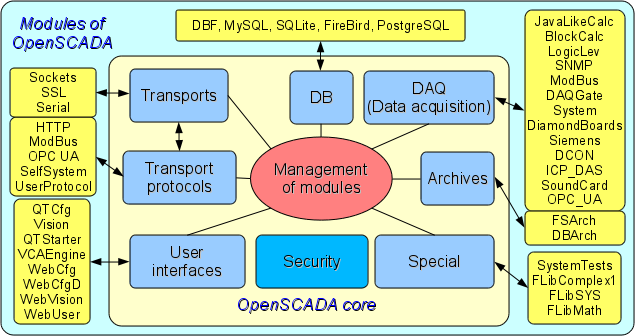
Fig. 1. The block scheme of OpenSCADA system
1.1. Modularity.
In order to achieve flexibility and a high degree of scalability OpenSCADA is constructed in a modular fashion. The process of developing our own modules imposed a great risk; possible errors could introduce an element of instability into the system, however tight integration of the modules with kernel lessened this issue and the ability to create a distributed configuration was seen as a greater benefit. In the end a more flexible and stable system was created.
OpenSCADA modules are stored within dynamic libraries and each shared library can contain modules of various types. The specific functional modules that are contained in a library is determined by the specifics of the modules connections. These dynamic libraries are hot swappable, which allows for the updating of a specific module without affecting the system as a whole. This method of storing code modules in dynamic libraries is essential for OpenSCADA, because it is supported by virtually all modern operating systems (OS). However, this does not exclude the possibility of developing other methods of storing code modules.
OpenSCADA has the following functional parts or modules:
- databases;
- communication transports interfaces;
- communication protocols;
- data sources and data acquisition;
- archives (messages and values);
- user interfaces(GUI, TUI, WebGUI, speech, signal...);
- additional and special (for Special subsystem) modules.
Management of the modules is carried out by the "Modules Management" subsystem, whose functions include connection, switching off, updating, and other operations concerned with the management of the modules and their libraries.
1.2. Subsystems.
Architecturally OpenSCADA is divided into subsystems or two types, regular and modular. Modular subsystem have the ability to expand through the addition of modules, with each modular subsystem containing sets of modular objects. For example the modular Database subsystem contains modular objects of the database type, thus the modular object is the root of the module.
The basic configuration of OpenSCADA consists of nine subsystems with seven being modular. These nine subsystems are present at every configuration. Additional subsystems can be created by adding additional modules. The following lists the basic subsystems of OpenSCADA:
- Security — non-modular.
- Modules Scheduler — non-modular.
- Data Bases — modular.
- Transports — modular.
- Transport Protocols — modular.
- Data Acquisition — modular.
- Archives (Histories) — modular.
- User Interfaces — modular.
- Specials (Speciality) — modular.
1.3. PLC and other sources of dynamic data. A subsystem "Data acquisition".
The Data Acquisition subsystem supports dynamic data sources whether PLC controllers, USO boards, virtual, or other sources. The functions of this subsystem are to provide data in a structured manner and the management of the data, i.e. data modification.
Since the Data Acquisition subsystem is modular it contains objects of the dynamic data source type. For example in October 2007 OpenSCADA supported the following data sources:
- "Diamond Systems" data acquisition cards.
- OS data acquisition.
- The Block calculator.
- Calculator in Java-like language.
- Data communicated from one OpenSCADA system to another.
- PLC data via the Modbus protocol.
- Network Device data via the SNMP protocol.
- OpenSCADA logic level system data.
- CIF50PB Profibus communications card, connecting to logic controllers via the MPI protocol.
Each data source requires a separate module that can be connected or disconnected, with a module communicating to one or more devices(controllers).
Each controller contains parameters with the types, defined by the module. The parameter provides the list of attributes which contain the data. Parameter's attributes can be one of four basic types, string(text), integer, float and boolean. For example an analog parameter can contain data in either integer or float format.
The structures of a controllers, parameters and their types are contained in the Data Acquisition subsystem so that the module objects can specifically fill in these structures.
A source of dynamic data can be on a remote OpenSCADA system. In this case the data source would be the OpenSCADA data transport. The function of this type of data source is to mirror of the data sources on the local system.
1.4. Databases. A subsystem of "Database"
For a data storage of system databases (DB) are everywhere used. With a view of systematization of access and management of databases in OpenSCADA system the subsystem "Database" is provided. For support of various DB/DBMS the subsystem is modular.
In a role of the modular objects, containing in a subsystem, type DB/DBMS acts, i.e. the module of a subsystem "Database", which practically contains realization of access to the certain type of a DB. For example modules: DBF, MySQL, SQLite.
The object of type DB/DBMS, in its turn, contains the list of objects of separated DB of the given type. And the object of a DB contains the list of objects of tables which are contained by data in the tabulated form.
Practically all the data of OpenSCADA system are stored in this or that DB. The toolkit of system allows to transfer easily the data from one type of a DB on another and as consequence provide an optimum selection of DB type under the concrete area of OpenSCADA system. Transfer of the information from one DB to another can be made by two ways. The first is a change of the address of a working DB and save of all system on it, the second is a direct copying the information between DB. Except for copying the function of direct editing of contents of tables of a DB is supported also.
For the organization of the centralized access of the allocated system to a uniform DB two ways are provided. The first is using of network DBMS, for example MySQL. The second way is using of transport type of a DB on local systems for access to one central DB (It is planned.). Function of a transport DB is transfer of queries to a DB on remote OpenSCADA system.
Data can be stored also in a configuration file of system. The mechanism of full reflection of structure of a DB on structure of a configuration file is realized. I.e. the standard configuration can be placed in a configuration file. An essence of such mechanism that by default for example at start without a DB, it is possible to describe the data of system in a configuration file. In the further, these data can be redefined in a DB. Besides for cases of impossibility of start of any DB generally, it is possible to store all data in a configuration file.
For access to databases the mechanism of registration of a DB is used. Registered DB in system are accessible to all subsystems of OpenSCADA system and can be used in their work. Owing to this mechanism it is possible to provide an allocation of data storage. For example, various libraries can be stored and extend independently, and connection of library will consist in simple registration of the necessary DB.
In the further, realization of duplication of a DB by linkage of the registered DB is planned. This mechanism will allow to increase considerably reliability of OpenSCADA system as a whole by reservation of the mechanism of a data storage. (It is planned.)
1.5. Archives. A subsystem "Archives".
Any SCADA system gives an opportunity of archiving the acquisition data, i.e. formation of history of change (dynamics) of processes. Archives, conditionally, it is possible to divide into two types: archives of messages and archives of values.
Feature of archives of messages is that the subject of archiving are, so-called, events. A characteristic attribute of event is time of occurrence of this event. Archives of messages, usually, are used for archiving messages in system, i.e. conducting logs and reports. Depending on a source, messages can be classified by various criteria. For example, it can be reports of emergencies, reports of actions of operators, reports of failures of connection, etc.
Feature of archives of values is their periodicity defined by the time interval between two adjacent values. Archives of values are applied for archiving of history of continuous processes. As far as process is continuous and it's archiving is possible only by introduction of conception of quantization of interrogation of values as differently we receive archives of the infinite sizes, in view of a continuity of the nature of process. Besides, practically, we can receive values with the period limited by sources of data. For example, qualitative enough sources of data, in the industry, data with frequency more 1kHz seldom allow to obtain. And it without taking into account sensors having even less qualitative characteristics.
For the decision of tasks of archiving data flows in OpenSCADA system the subsystem "Archives" is provided. The subsystem "Archives" allows to conduct both: archives of messages and archives of values. The subsystem "Archives" is modular. The modular object containing in a subsystem "Archives" the type of the archiver acts. The type of the archiver defines the way of a data storage, i.e. storehouse (file system, DBMS, a network, etc.). Each module of a subsystem "Archives" can realize both: archiving of messages, and archiving of values. The subsystem "Archives" can contain set of the archives served by various modules of a subsystem.
The message in OpenSCADA system is characterized: by date, by level of importance, by category and the text of the message. Date of the message specifies for the period of creation of the message. The level of importance specifies a degree of importance of the message. The category determines the address or the conditional identifier of a source of the message. Usually, the category contains a full way to a source of the message in system. The text of the message, actually, also carries meaning content of the message.
During archiving messages are passed through the filter. The filter works on a level of importance and a category of the message. The level of the message in the filter specifies that it is necessary to pass messages with specified or higher level of importance. To filtering on a category templates or regular expressions are used, which define what messages are applied to pass. Each archiver contains own options of the filter. Consequently it is possible to create easily various specialized archivers for archive of messages. For example archivers of messages it is possible to dedicate on:
- logs for storage of the debugging information and other working information of a server;
- various reports (the report of actions of clients, the report of infringements and exceptions, the report of events...).
In view of the similar nature of the messages and the alarms, the subsystem "Archives" contains a buffer of current alarms, which contains active at the time the alarms with using the message category as a key identifier of the alarm. Access to the list-buffer of current alarms specifying by a negative value level messages. Thus, the formation of negative message with level -2 cause place in this message to buffer active alarms with level 2, as well as duplication of directly to messages archive. At the subsequent formation of the message in the same category, but a positive level, say 1, will be carried deletion of the specified alarm from the buffer of alarms and also the message fall into messages archive. This mechanism allows you to simultaneously keep track of active alarms and log their passage into the messages archive. When requesting to archive messages, an set of a positive level makes a request to archive messages, and a negative to buffer-list of current alarms.
The archive of values in system OpenSCADA acts as an independent component which includes the buffer processable by archivers. Key parameter of archive of value is the source of data. In a role of a source of data attributes of parameters of OpenSCADA system and also other external sources of data (a passive mode) can act. Other sources of data can be: network archivers from remote OpenSCADA systems, the environment of programming of OpenSCADA system, etc.
Key component of archiving of values of continuous processes is the buffer of values. The buffer of values is intended for intermediate storage of a file of the values received with certain periodicity (quantum of time). The buffer of values is used as for direct storage of big arrays of values in archives of values, before direct "retire" on physical carriers, and for manipulations with the staff of values, i.e. in functions of frame-accurate query of values and their placement in buffers of archives.
For the organization of the dedicated archivers, in the allocated systems it is possible to use transport type of the archiver (It is planned.). Function of transport type of the archiver is reflection of the remote central archiver on local system. As consequence, archivers of transport type carry out data transmission between local system and the archiver of the remote system, hiding from subsystems of local system the real nature of the archiver.
1.6. Communications. Subsystems "Transports" and "Transport protocols".
As far as the OpenSCADA system is pawned as is high-scaled system that support of communications should be flexible enough. For satisfaction of a high degree of flexibility, communications in OpenSCADA system are realized in subsystems "Transports" and "Transport protocols" which are modular.
The subsystem "Transports" is intended for an exchange of the not structured data between OpenSCADA system and external systems. In a role of external systems can act even remote OpenSCADA systems. Not structured data are understood as a file of symbols of the certain length. The modular object containing in a subsystem "Transports", the type of transport acts. The type of transport defines the mechanism of transfer of not structured data. For example it can be:
- sockets (TCP/UDP/UNIX);
- channels;
- shared memory.
The subsystem "Transports" includes support of input and output transports. Input transport is intended for service of external queries and sending of answers. Output transport, on the contrary, is intended for sending messages and expectation of the answer. Consequently, input transport contains a configuration of the given station as server, and output transport contains a configuration of the remote server. The module of a subsystem "Transports" realizes support both: input and output transports.
The subsystem "Transport protocols" is intended for structuring of data received from a subsystem "Transports". As a matter of fact, the subsystem "Transport protocols" is continuation of a subsystem "Transports" and carries out functions of check of structure and integrity of the received data. So, for the indication of the protocol together with which transport should work, the special configuration field is provided. The modular object containing in a subsystem "Protocols" is the protocol. For example, transport protocols can be:
- HTTP (Hyper Text Transfer Protocol);
- SelfSystem (OpenSCADA the system protocol).
The full chain of connection can be written down as follows:
- the message is transferred in transport;
- transport transfers the message to the protocol, connected with it, by creation of new object of the protocol;
- the protocol checks integrity of data;
- if all data have come, transport must be informed about the termination of expectation of data and to transfer it the answer, differently to inform, that it is necessary to expect still;
- transport, having received {confirmation, sends the answer and delete object of the protocol;
- if confirmations are not present, the transport continues expectation of data, and in the case of their receipt transfers them to the saved object of the protocol.
Protocols for output transports are supported also. The output protocol incurs function of dialogue with transport and realization of features of the protocol. The internal side of access to the protocol is realized by data-flow way with own structure for each protocol module. Such mechanism allows to carry out transparent access to external system, by means of transport, simply specifying a name of the protocol by means of which to serve transfer.
Owing to standard API-access to transports of OpenSCADA system it is possible to change easily a way of data exchange not touching exchanging systems. For example, in the case of a local exchange it is possible to use faster transport on the basis of shared memory, and in the case of an exchange through the Internet and a local network to use TCP or UDP sockets.
1.7. Interfaces of the user. A subsystem "Interfaces of the user".
SCADA-systems as a class, assume presence of user interfaces. In OpenSCADA, for granting the user interfaces, the subsystem "The user interfaces" is provided. The user interface of OpenSCADA system is understood not only as the environment of visualization from which the end user should work, but also as everything, that concerns the user, for example:
- environments of visualization;
- configurators;
- alarming and signaling devices.
The subsystem "The user interfaces" is modular. As modular object of a subsystem the concrete interface of the user actually acts. Modularity of subsystem allows to create various interfaces of users on various GUI/TUI libraries and to use optimal of decisions in particularly taken case, for example, for environments of performance of programmed logic controllers it is possible to use configurators and visualizers on the basis of Web-technologies (WebCfg, WebUI), and in case of stationary workstations to use the same configurators and visualizers, but on the basis of libraries Qt, GTK.
1.8. Security of system. A subsystem "Security".
The OpenSCADA system is the branched out system which consists of ten subsystems and can include set of modules. Consequently, granting of unlimited access by all to these resources is at least unsafe. Therefore, for differentiation of access in OpenSCADA system, the subsystem of "Security" is provided. The basic functions of a subsystem "Security" are:
- storage of registration records of users and groups of users;
- authentication of users;
- check of access rights of the user to this or that resource.
1.9. Management of libraries of modules and modules. A subsystem "Management of modules".
The OpenSCADA system is constructed by a modular principle that means presence of set of modules with which it is necessary to operate. For performance of function of management by modules of OpenSCADA system the subsystem "Management of modules" is provided. All modules, for the present moment are delivered in system by means of shared libraries (containers). Each container can contain set of modules of various type.
The subsystem "Management of modules" realizes the control over the status of containers and allows to carry out hot addition, removal and updating of containers and modules containing in them.
1.10. Unforeseen opportunities. A subsystem "Special".
Certainly, to provide all probable functions it is impossible, therefore in OpenSCADA system the subsystem "Special" is provided. The subsystem "Special" is modular and is intended for addition in OpenSCADA system unforeseen functions by modular expansion. For example, by means of a subsystem "Special" can be realized:
- tests of OpenSCADA system and its modules;
- libraries of functions of the user programming.
1.11. The user functions. Objective model and the environment of programming of system.
Any modern SCADA system should contain the mechanisms giving an opportunity to program at the user level, i.e. to contain the environment of programming. The OpenSCADA system contains such environment. By means of the environment of programming of OpenSCADA system it is possible to realize:
- Algorithms of management of technological processes.
- Large dynamic models of real time of technological, chemical, physical and other processes.
- Adaptive mechanisms of management on models.
- The user procedures of management by internal functions of system, its subsystems and modules.
- Flexible formations of structures of parameters at a level of the user, with the purpose of creation of parameters of non-standard structure and its filling on algorithm of the user.
- Auxiliary calculations.
The environment of programming of OpenSCADA system represents a complex of assets organizing the computing environment of the user. Into structure of a complex of assets are included:
- objective model of OpenSCADA system;
- modules of libraries of functions;
- computing controllers of a subsystem "Data acquisition" and other calculators.
Modules of libraries of functions give set of functions of the certain orientation expanding objective model of system. Libraries can be realized both: by the set of functions of the fixed type, and functions supposing free updating and addition.
Libraries of functions of the fixed type can be given by standard modules of system, organically supplementing objective model. Functions of such libraries will represent the interface of access to assets of the module at a level of the user. For example, "The environment of visual data presentation" can give functions for delivery of various messages. Using these functions the user can realize interactive algorithms of communication with system.
Libraries of functions of free type give the environment of a writing of the user functions on one of programming languages. Within the limits of the module of libraries of functions mechanisms of creation of libraries of functions can be given. So, it is possible to create libraries of devices of technological processes, and in a consequence to use them by linkage. Various modules of libraries of functions can give realizations of various programming languages.
On the basis of the functions given by objective model, computing controllers are under construction. Computing controllers carry out linkage of functions with parameters of system and the mechanism of calculation.
2. SCADA systems and their structure.
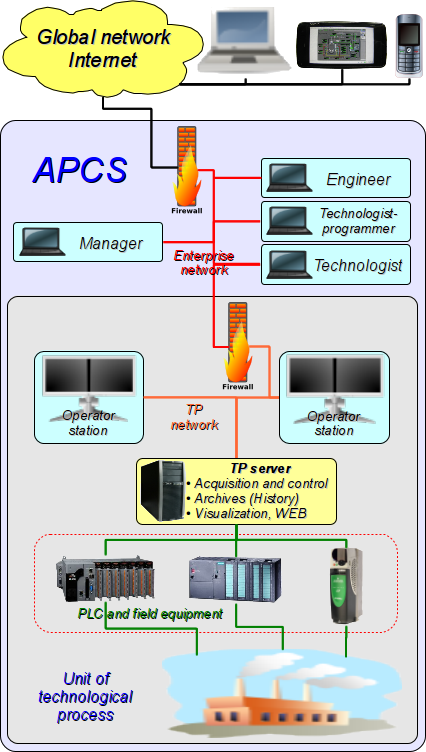
Fig. 2. SCADA-system.
SCADA (Supervisory Control And Data Acquisition), in a general view, have the allocated architecture like represented on fig. 2. Elements of SCADA systems, in sense of the software, carry out following functions:
The acquisition server: represents a task or group of tasks engaged in data acquisition from sources of data, or act in a role as a source of data. Into tasks of a server enters:
- reception and-or formation of data;
- data processing;
- service of queries about access to data;
- service of queries about updating of data.
The server of archiving: represents a task or group of tasks engaged in archiving of data. Into tasks of the server enters:
- archiving of data of SCADA-system;
- service of queries about access to contemporary records;
- import/export of archives.
The journaling server: represents a task or group of tasks engaged in archiving of messages. Into tasks of the server enters:
- archiving of messages of units of SCADA-system;
- service of queries about access to archival messages;
- import/export of archives.
The alarm server: represents a task or group of tasks carrying out functions of the server of recording concerning a narrow category of messages of the signal system.
The operator working place: represents constantly functioning GUI (Grafical User Interface) application executed in an one-monitor, multimonitor or panel mode and carrying out functions:
- granting of the user interface for the control over a condition of technological process;
- granting of an opportunity of formation of operating influences;
- granting of an opportunity of studying and the analysis of history of technological process;
- granting of toolkit for generation of the reporting documentation.
The engineer working place: represents GUI application used for configuration of SCADA system. Into tasks of the application enters:
- granting of toolkit for manipulation with system functions of system;
- granting of toolkit of a workplace of the operator;
- granting of toolkit for manipulation with architecture of SCADA system as a whole (distribution of functions between stations, creation, removal of stations...).
The chief working place: represents GUI application, as a rule, executed in an one-monitor mode and carrying out functions:
- granting of the user interface for the control over a condition of technological process;
- granting of toolkit for studying and the analysis of history of technological process as is direct from an active server, and on the basis of separate archives;
- granting of toolkit for generation of the reporting documentation.
The technologist working place: completely includes functions of a workplace of the operator plus model of technological process (without direct communication with technological process).
The work planner working place: completely includes functions of a workplace of the technologist plus toolkit for creation of models of technological processes.
3. Ways of configuration and using of OpenSCADA system.
3.1. Simple server connection.
In the elementary case the OpenSCADA system can be configured in a server mode (fig. 3.1) for acquisition and archiving of data. The given configuration allows to carry out following functions:
- interrogation of controllers;
- archiving of values of parameters;
- service of client queries about reception of various data of a server;
- granting of the configuration WEB-interface;
- the remote configuration from OpenSCADA system by means of the Qt-interface or other local interface.
- secondary regulation (regulation in computing controllers);
- modeling, adjusting and supplementing calculations in computing controllers.
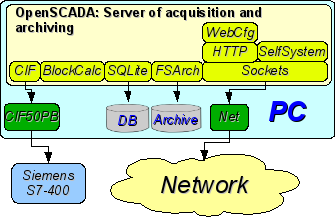
Fig. 3.1. Simple server connection.
3.2. The duplicated server connection.
For increasing of reliability and productivity the OpenSÑADA system supposes plural reservation (fig. 3.2) at which controllers of one copy are reflected in other. At use of a similar configuration distribution of loading of interrogation/calculation at various stations is possible. The given configuration allows to carry out functions:
- interrogation of controllers;
- archiving of values of parameters;
- service of client queries about reception of various data of a server;
- reservation of parameters;
- reservation of archives;
- distribution of loading of interrogation on servers;
- granting of the configuration WEB-interface;
- secondary regulation (regulation in computing controllers);
- modeling, adjusting and supplementing calculations in computing controllers with an opportunity of distribution of loading on servers.
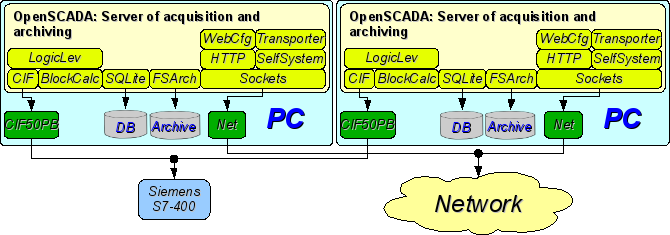
Ðèñ. 3.2. The duplicated server connection.
3.3. The duplicated server connection on one server.
Special case of the duplicated connection is the duplicated connection within the limits of one server (fig. 3.3), that is start of several stations by one machine with a crossing of parameters. The purpose of the given configuration is increase of reliability and fault tolerance of system by reservation of software.
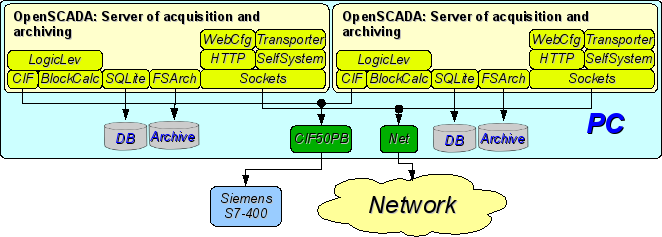
Fig. 3.3. The duplicated server connection on one server.
3.4. Client access by means of the Web-interface. A place of the manager.
For visualization of data containing on a server, the good decision is to use the user WEB-interface (fig. 3.4). The given decision allows to use a standard WEB-browser at the client side and therefore is the most flexible as it is not adhered to one platform, i.e. is multiplatform. However this decision has essential imperfections: low productivity and reliability. In this connection it is recommended to use the given method for visualization of noncritical data or data having a reserve highly reliable way of visualization. For example, the good decision will be using of this method at the heads of plants where always exists place(attendant position) with reliable way of visualization. The given configuration allows to carry out following functions:
- interrogation of a server for data acquisition of visualization and a configuration;
- visualization of data in a kind accessible to understanding;
- formation of protocols, reports;
- manipulation with parameters supposing change.
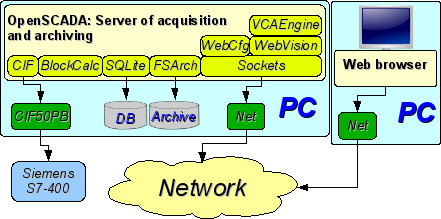
Fig. 3.4. Client access by means of the Web-interface. A place of the manager.
3.5. The automated workplace (place of the manager/operator).
For visualization of critical data, and also in case of if high quality and productivity is required, it is possible to use visualization on the basis of OpenSCADA system configured with the GUI module (fig. 3.5). The given configuration allows to carry out following functions:
- interrogation of a server for updating current values;
- visualization of the interrogated data in a kind accessible to understanding;
- formation of protocols and reports;
- manipulation with parameters supposing changes.
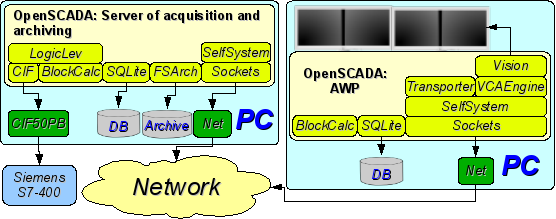
Fig. 3.5. The automated workplace (place of the manager/operator).
3.6. Automated workplace with a server of acquisition and archiving on the single machine (a place of the operator, model...).
The full-function client-server configuration on the single machine (fig. 3.6) can be used for increasing of reliability of system as a whole by start of the client and a server in different processes. The given configuration allows, without consequences for a server, to stop the client and to do with it various preventive works. It is recommended for use at stations of the operator by installation of two machines combining in itself the station of the operator and redundant server. The given configuration allows to carry out following functions:
- interrogation of controllers;
- service of client queries;
- visualization;
- delivery of operating influences;
- generation of protocols and reports;
- secondary regulation;
- modeling, adjusting and additional calculations in computing controllers;
- acquisition and visualization of the information on a personal computer, a server....
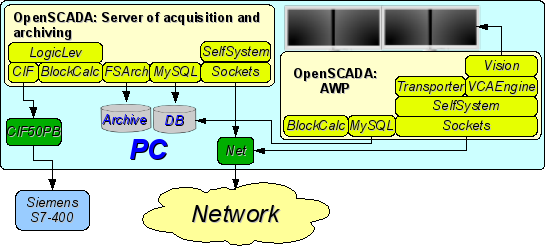
Fig. 3.6. Automated workplace with a server of acquisition and archiving on the single machine (a place of the operator, model...).
3.7. The elementary mixed connection (model, demonstration, configurator...).
The mixed connection combines functions of a server and the client (fig. 3.7). It can be used for test, demonstration functions, and also for granting models of technological processes as a unit. In this mode following functions can be carried out:
- interrogation of controllers;
- service of client inquiries;
- visualization;
- delivery of operating influences;
- generation of protocols and reports;
- secondary regulation;
- modeling, adjusting and supplementing calculations in computing controllers;
- acquisition and visualization of the current information on a personal computer, a server, model...;
- a configuration of databases, connections, etc.
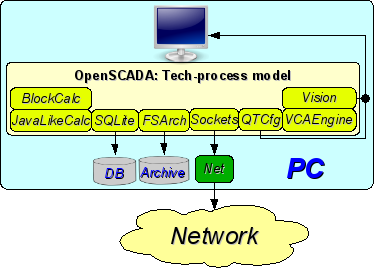
Fig. 3.7. The elementary mixed connection (model, demonstration, configurator...).
3.8. The steady, allocated configuration.
The given configuration is one of variants of steady/reliable connection (fig. 3.8). Stability is reached by distribution of functions on:
- to servers of interrogation;
- to the central server of archiving and service of client queries;
- to clients: automated workplaces and WEB-clients.
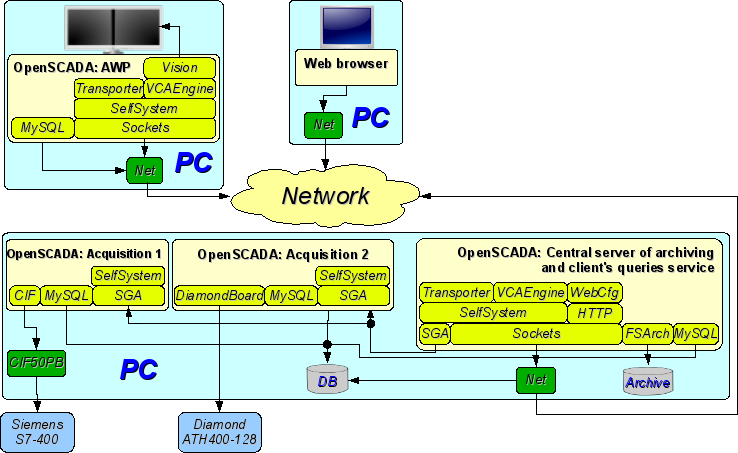
Fig. 3.8. The steady, allocated configuration.
The server of interrogation is configured on the basis of OpenSCADA system and represents the task (group of tasks) engaged with interrogation of the controller (group of controllers of the same type). The received values are accessible to the central server through any transport which support is added by connection of the corresponding module of transport. For decrease in frequency of interrogation and size of the network traffic the server of interrogation can be equipped with small archive of values. The configuration of a server of interrogation is stored in one of accessible DB.
The central server of archiving and service of client queries carries out function of the centralized acquisition and processing of parameters of servers of interrogation and their values. Access to servers of interrogation is carried out by means of one of accessible in OpenSCADA transports+protocols (for example it is SGA). For granting the uniform interface of access to parameters and controllers the module Transporter which reflects data of servers of interrogation on structure of local parameters is used.
For performance of internal calculations and the additional analysis of parameters computing controllers are used.
For versatile and deep archiving various modules of archives are used.
For access of clients to a server are used accessible for OpenSCADA network transports, for example it is Sockets, and transport protocols, for an example it is the protocol OpenSCADA "SelfSystem".
The configuration of the central server is stored in one of accessible DB (for example it is network DBMS MySQL).
For granting the user WEB-interface the module WebCfg by means of the transport protocol "HTTP" is used.
Various clients, among them automated workplaces and WEB-clients, are carried out on the separated machines in necessary quantity. The automated workplace is realized on the basis of OpenSCADA system. Its functions include interrogation of values of parameters from the central server and their visualization on the GUI interface(s). For reception of parameters in an automated workplace the module of reflection of the remote parameters Transporter, also, is used. For granting access to archives the module of archive of network type can be used. The configuration of an automated workplace can be stored in one of accessible DB (for example it is network DBMS MySQL, located on the machine of the central archiving server).
4. Configuration and adjustment of the system
As it can be seen in the section above, OpenSCADA allows configuration for execution in various roles. Support of this possibility is provided by the developed mechanisms for configuration and storage of configuration data. This section contains a description of these mechanisms, designed to demonstrate the flexibility and diversity, thereby allowing to use OpenSCADA to 100%.
In describing the configuration mechanisms and methods of its storage in this section it will be focused the description of system-wide mechanisms. Features of the configuration of modules of subsystems of OpenSCADA are provided in their own module's documentation.
In OpenSCADA it is used the formalized approach to describing the configuration interfaces based on XML. In fact, features of the component's configuration are provided by the component itself, thereby running through the whole system, as the nervous system of the organism. In terms of OpenSCADA it is called the interface of control of OpenSCADA (Control interface). On the basis of the control interface the graphical interfaces of the user configuration are generated by means of modules of OpenSCADA. This approach has the following important advantages:
- Scalability. You can connect only the required configuration modules or use only the remote mechanisms.
- Excluding the need to update the configurators with the addition of new modules/functions, as well as the exclusion of "swelling" of the configurator, providing the support for all of history of now unnecessary and obsolete modules/functions.
- Simplicity of the creation of the graphical interfaces of configuration on the different basis owing to the clear formality.
- The possibility of dynamic configuration is available, ie configuration can be performed directly while the running of the system both locally and remotely, directly controlling the result.
- The simple and special extensibility of the configuration interface by adding the configuration fields on the control interface's description language only in the required components.
In OpenSCADA the three configuration modules on the different basis of visualization are provided. Lets observe them and their configuration options:
- Configuration module on the GUI library Qt (
 http://en.wikipedia.org/wiki/Qt_(framework)) — UI.QTCfg. Provides an advanced configuration interface, allowing to operate as a local station and the remote ones in the local and global networks, including secure connection.
http://en.wikipedia.org/wiki/Qt_(framework)) — UI.QTCfg. Provides an advanced configuration interface, allowing to operate as a local station and the remote ones in the local and global networks, including secure connection.
- Configuration module based on the dynamic WEB-technologies (DHTML) — UI.WebCfgD. Provides an advanced configuration interface, allowing to operate as a local server's station, and the remote stations in the local and global networks, including work on the secure connection. Client connection is provided through the usual Web-browser.
- Configuration module based on the static WEB-technologies (XHTML) — UI.WebCfg. Provides an adequate configuration interface that allows to manage the local server's station via the usual Web-browser.
Configuration values, changed in the configurators, as well as most of the data are stored in databases (DB). Given the modularity of subsystems "DB", there can be different database. Moreover, there is the possibility of storing different OpenSCADA parts in different databases of the same type and in the database of different types as well.
In addition to the database configuration information may be contained in the OpenSCADA configuration file, and passed through the command line parameter's when you call OpenSCADA. Saving the configuration in the configuration file is carried out on an equal footing with the database. Standard name of the OpenSCADA configuration file is /etc/oscada.xml. The format of the configuration file and command line parameters we'll examine in the separate section.
Some node's configuration changing will set the modification flag for the node, and also will set active for buttons "Load from DB", for loading the first configuration, and "Save to DB" for the changes saving. The modification flag also rise to parrent node, which allow for restore-save from root node, but real into operations with DB will participate only modified nodes. ![]() A node removing causes to removing it from storage-DB and modification mechanism do not work for this operation.
A node removing causes to removing it from storage-DB and modification mechanism do not work for this operation.
Many of the settings and configuration objects OpenSCADA, which are executed or are already enabled, are not applied immediately, as for changes, because the configuration is read/apply usually only when turn on or start. Therefore to apply the changes, in such cases, it is enough to enable/disable enabled object or to restart the running — start/stop. Presently many configurations, which its are not provided applying for now, just are not allowed for editing.
Further examining of the OpenSCADA configuration will be based on the interface of the configurator UI.QTCfg, but the principles of work will be fully consistent with the rest of the configurators owing to the generality in the control interface of OpenSCADA.
We will start examining with the configuration of system parameters of OpenSCADA, which is located in the six tabs at the root page of the station:
- Tab "Station" contains basic information and configuration field of the station, Fig.4a. Here are the provided fields and comments on them:
- ID — contains information about the station's identifier. It is specified by the command line parameter "--station". When loading it is sought the section in the configuration file appropriate to the station identifier, and if not detected, it uses the first available one.
- Station name — indicates the localized station's name. It is specified by the command line parameter "--statName".
- Program — contains information on the program name. Usually it is OpenSCADA or name of solution based on OpenSCADA.
- Version — contains the information on the current version of the programme.
- Host name — contains the information on the name of the machine that runs the station.
- System user — contains the information about the user on whose behalf the program is executed in the system (OS).
- Operation system — contains the information about the name and version of operation system, operation system kernel on which the program is executed.
- CPU — contains the CPU operative information specifically that is accessible CPU/core number and frequency of the CPU, which runs the program. The value of frequency is checked every 10 seconds, for X86, and allows you to monitor its change, for example, by the power management mechanisms.
- Main CPUs set — indicates main list CPUs for use by OpenSCADA tasks. Into round brackets contains list of used CPUs currently.
- Tasks planning clock — contains information about the used tasks planning clock and it's resolution on the operation system. It allows you to orient with the minimum interval of time of periodic tasks, for example, for task of data acquisition.
- Internal charset — contains information about the charset in which text messages are stored within the program.
- Config file — contains information about the configuration file used by the program. Set by the command-line parameter "--config".
- Work directory — indicates the working directory of the station. It is used in relative addressing of the objects in the file system, for example, database files. It allows the user to save the modified system data to another database. The value of this field is not stored in the database, but can be changed only in the "WorkDB" section of the configuration file.
- Modules directory — indicates the directories of modules for OpenSCADA, separated by ';', they can include a files' template into the end (/my/modules/path/lib*.so). If the value of this field is incorrect, then at start you will not see any graphical interface, but the only information in the console on the correct running of the OpenSCADA kernel.
- Icons directory — indicates the directory containing the program icons. If the configuration navigation tree have no icons, then you have incorrectly entered the value of this field.
- Documents directory — indicates the directory containing the program documents. If you can not to call local documents then you have incorrectly entered the value of this field or no the documents installed.
- Work DB — indicates the working database (DB), namely, the database used to store basic data of the program. Changing of this field notes all objects as modified that allows you to save or to load station's data from the specified main database.
- Save the system at exit — points to the need to save the changed data at finishing of the program.
- Save the system period — indicates the frequency in seconds with which to save the changed station's data.
- Language — indicates the language of messages of the program. Changing of this field is acceptable, but leads to a change of messages' language only for the interface and dynamic messages!
- Messages — section of the parameters' group that are processing by the work and messages of the stations:
- Least level — indicates the level of messages beginning from which they are to be processed. Messages below this level will be ignored. The level "Debug (0)" have special sense, it set will enable debug messages generation by different parts of the system. For the parts debug messages generation control you can use tab "Debug" (fig.4d).
- To syslog — indicates the need of sending the message to the system logger, the mechanism of operation system for work with system messages and software. When this option is enabled the possibility appears to manage and control the OpenSCADA messages by the mechanisms of OS.
- To stdout — indicates the using as a standard mechanism to display the message the output to the console. Disabling of this feature will eliminate the entire output in the console, unless you specify the following parameter.
- To stderr — indicated the using as a standard mechanism to display the message the error output, it is also usually sent to the console.
- To archive — indicated the need for output of the messages in the messages' archive of OpenSCADA. This option is usually enabled and its disabling leads to the actual disabling of the archiving at the station.
- Tab "Subsystems" tab contains the list of subsystems (Fig. 4b) and allows you to jump directly to them using the context menu.
- Tab "Redundancy" (Fig. 4c) contains the configuration of redundancy of the station with the following settings:
- Status — contains information on redundancy scheme, at the moment this time spent on the execution of one cycle of the task of reserve processing.
- Station level — indicates the level of the station in an arrangement (0-255).
- Redundant task period (s) — indicates the period of execution of the redundancy task in seconds (1-255).
- Restore connection timeout (s) — indicates over the which period of time to attempt to reconnect with a lost redundant station in seconds (0-255).
- Local primary commands transfer — enables of local primary commands transfer to the redundant stations for the local changes automatic sync.
- Stations — contains the table with information about the redundant stations. Stations can be added and removed via contextual menu. Id of the added stations is to be chosen from the list of available OpenSCADA system stations. Presence into the table at last one enables the redundancy in whole and opens access to pages of the redundancy configuration at level of subsystems, in condition of the subsystem supports the redundancy. The table provides the following information about the station:
- ID — ID of the system OpenSCADA station, should be changed after the addition by choosing from the list of available ones;
- Name — name of the system OpenSCADA station;
- Live — sign of the connection with the redundant station;
- Level — level of the remote station in the redundancy scheme;
- Counter — requests' counter to the redundant station or waiting time, in the case of the absence of connection.
- Go to remote stations list configuration — command to go to the configuration page of the remote OpenSCADA stations in the subsystem "Transports".
- Tab "Tasks" contains the table with opened tasks by OpenSCADA components (Fig.4d). From table you can get several information about the tasks, and also set CPUs for tasks of multi-processors systems.
- Tab "Debug" contains elements for control to debug (Fig.4e) and activates at select the messages level "Debug (0)" or at the objects counters using.
- Tab "Translations" contains elements of the manager of central translations text messages of the system (Fig.4f) and activates at the multi-language mode enabling by base language of text variables set. Elements of the translations manager:
- Text variable's base language — is used to activate the support of multilingual text variables by specifying a non-empty basic language. The value of the basic language is selected from the list of bi-character language code, usually only the current and the base language is in the list. Further for the text variables in the non basic language in the tables of the database it will be created the separate columns. Under the text variables the all text fields of configurator, which can be translated into another language are meant. Numbers and other symbolic values are not in their number and are not translated.
- Dynamic translation — current state and plan the dynamic text messages translation. The dynamic text messages translation causes the text messages translation cache enabling and requests to the translations to the DB depends to the OpenSCADA system part's language, mostly for multi-language dynamic user interfaces when user has self-preferred language.
- Enable manager — enabling the translation manager. Cause the system reloading to forming an index of built translations, however this do not doing to forming full the messages index by deny to reloading some objects into an execution. For full the messages index loading you ought the manager save into enable mode and OpenSCADA restart. Ongoing the system next start will forming full the messages index.
- Languages — the translations languages list from base, controls the manager. The language column will contain a data if set language present into source or will not else.
- Source filter — the messages filter by substring into the source.
- Check for mismatch — toggle checking and indicating to mismatch messages' translation into different places, needs more time for that.
- Messages — same the messages table with columns: the base language, selected translation languages, the messages sources. To modify there are allowed the languages columns and at result the changes will set to the messages sources.
To modify the fields of this page it may be required the super user's rights. Get these rights you can by means of including your user into the superuser's group "root", or by entering the station from the superuser "root".
We must mention another one important point: the fields of the identifiers of all OpenSCADA objects are unacceptable for direct editing, because they are keys for storage of objects' data in the database. However, to change the object's identifier you can by the command of cutting and the further pasting of the object (Cut-> Paste) in the configurator.
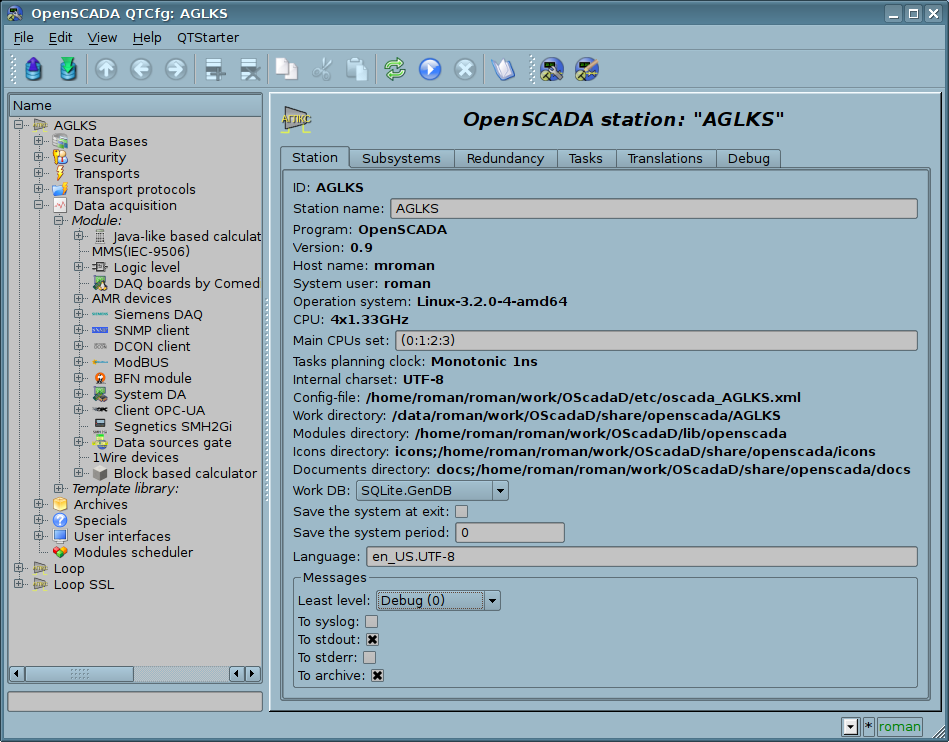
Fig. 4a. The "Station" tab of the main page of the configuration of the station.
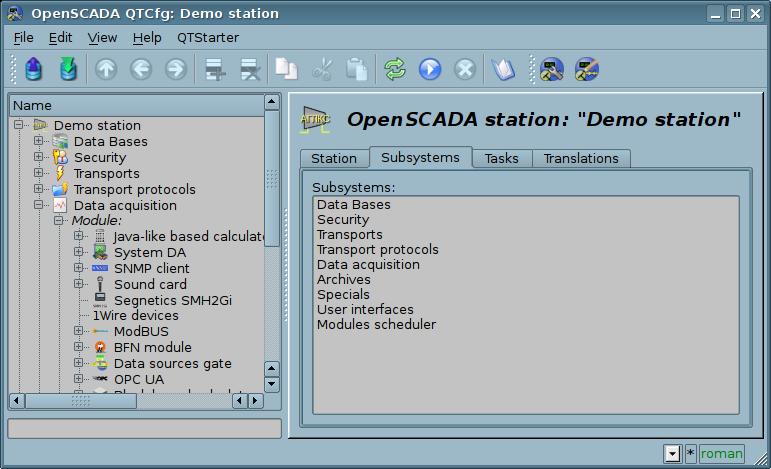
Fig 4b. The "Subsystems" tab of the main page of the configuration of the station.
The service task of the redundancy mechanism is always running and executed at intervals which are prescribed in the appropriate configuration field. The real work on implementing the redundancy is carried out in the presence of at least one redundant station in the list of stations, and implies:
- Monitoring of the connection with external stations. In the monitoring process the requests to remote stations are made to get the information about them updated and to check connection. In the case of loss of connection with the station the repeat of connection to it is made through interval specified in the configuration field "Restore connection timeout". In the "Live" field of the station the current state of communication is displayed. In the "Counter" field the number of requests carried to the remote station, or the time remaining for the next connection attempt to the lost station is displayed. In the "Run" field there is a list of active controllers at the remote station with a sign of the local execution.
- Local planning of the objects' execution in reserve. Planning is carried out in accordance with the station's level and preferences of execution of objects: controllers, messages archivators.
- Calling the data synchronization function for the local objects of the redundant subsystems working in the mode of synchronization of data from the external stations.
There is recommended the redundancy configure in way for DBs of the redundant stations save equal and that will allow you to copy its painlessly to each the station and then to backup only one the DBs set. And the configurations specified to the different stations will save into the configuration file and you can simply configure and change the needed station by the proper configuration file select.
The redundancy configuration start from the redundant stations appending to list of system stations OpenSCADA in tab "Subsystem" of the subsystem "Transports" (Fig.4.3b). And to add here needs not only the redundant stations to the current one but the same current one with its external IP, that is some loop. Further this configurations will have been stored into the generic DB of the redundant system, and from this time the DBs will be used for that all redundant station creation. Then there is important to make on that stage all needed changes into the generic DB and about this project in general!
Next for the concrete station, with copy of the generic DB, we configure its specific parameters into the tab "Redundancy" of the main page (Fig.4c), which will be stored into the configuration file.
After that all next configurations of redundancy perform into the tab "Redundancy" of proper subsystem, "Data acquisition" (Fig.4.5b) or "Archives" (Fig.4.6b). If you will set the parameter "Local primary commands transfer" (Fig.4c) then the configurations, like to any other generic configurations, can be performed at any one from the stations and all the performed changes will be transferred to all other ones, sure if its are available.
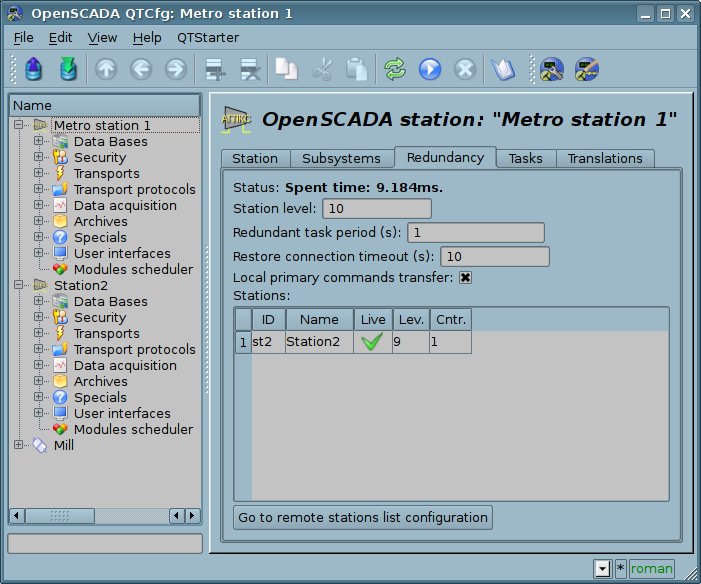
Fig 4c. The "Redundancy" tab of the main page of the configuration of the station.
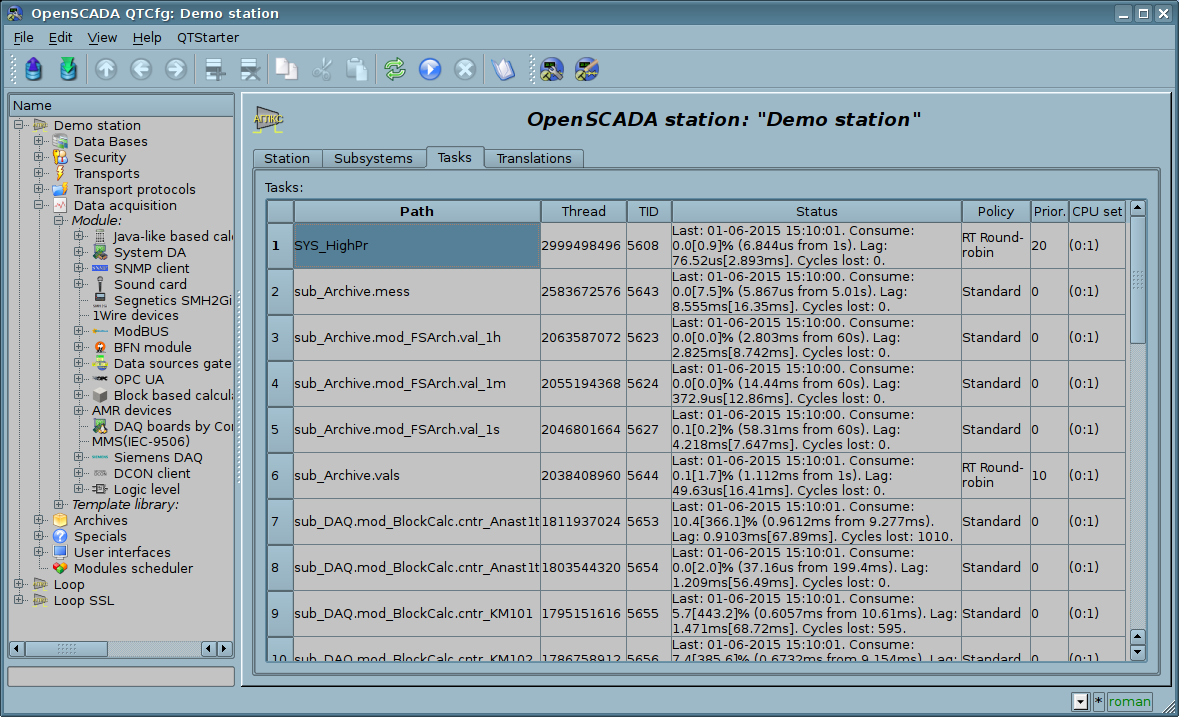
Fig 4d. "Tasks" tab of the main page of the configuration of the station.
For OpenSCADA different working specific debug you may be necessary to enable addition-debugging messages generation, which you can set by select minimal messages level, into tab "Station", to "Debug (0)". As a result of this will emerge tab "Debug" (fig.4e) where available the objects counters for control to leaks, and also the table with incoming debug messages' categories list. Into the table you can select only needed debug messages sources and omit to overload the archiving messages subsystem and overall the system performance decrease. You can also select higher categories, up to root system category, that will disable detailed selection and enable all messages generation by the level or by overall system. For the debug messages observing you need to go subsystem "Archives" (fig. 4.6c), and for this provided button "See to messages". Selected debug mode and debug categories list can be standard stored to configuration file and on next boot the debug mode will be activated, this important primarily for the objects counters.
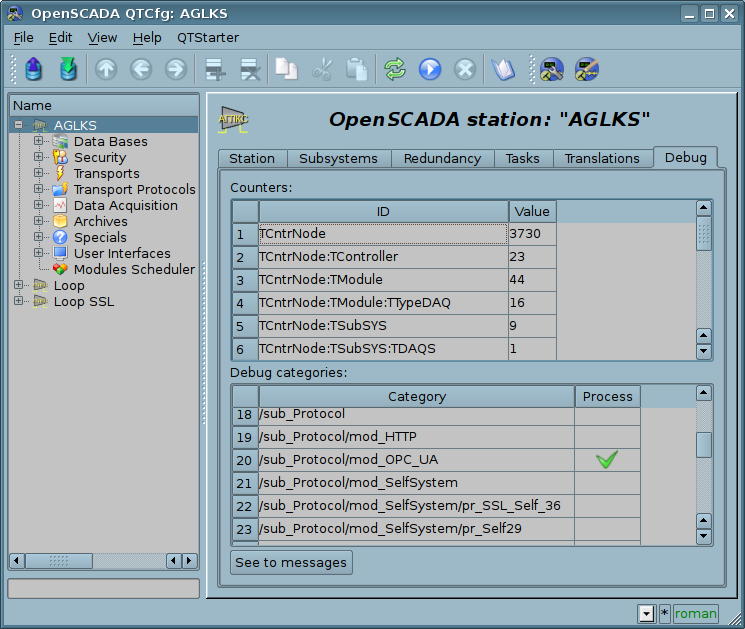
Fig. 4e. The "Debug" tab of the main page of the configuration of the station.
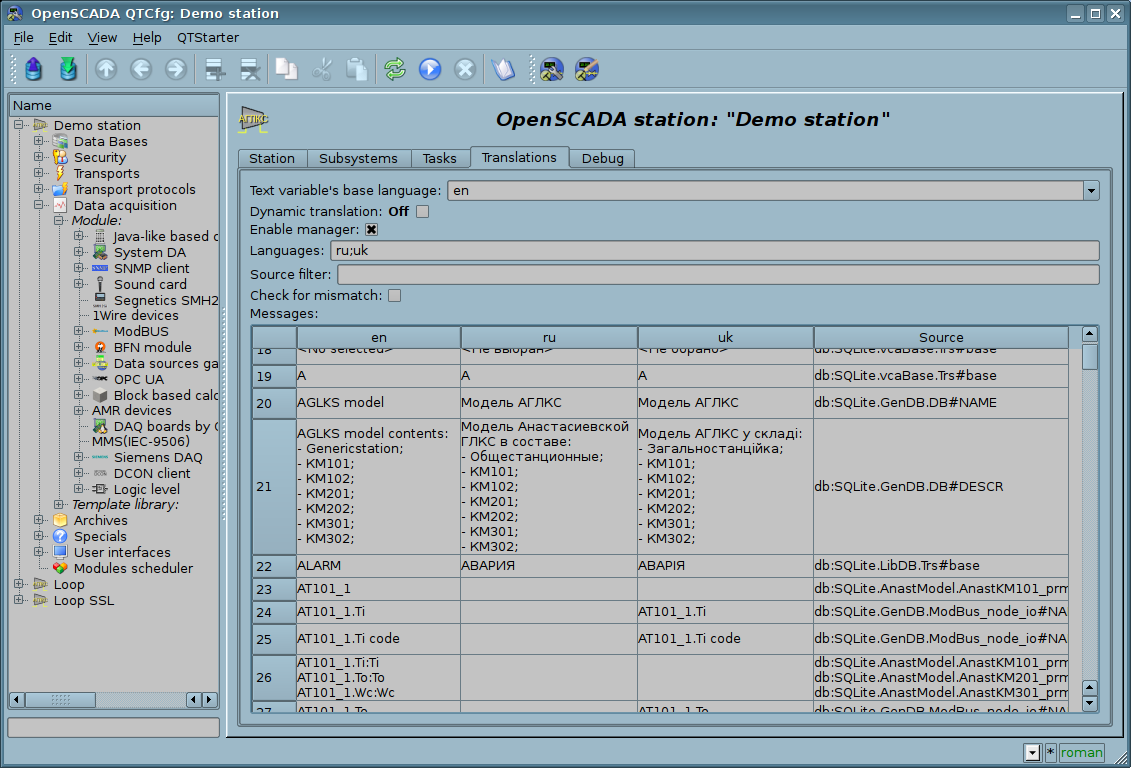
Ðèñ. 4f. The "Translations" tab of the main page of the configuration of the station.
While examining the configuration pages of modular subsystems there will be described the general for all modules properties. However, it should be noted that each module can provide both: the additional tabs, and separate fields for the configuration of their own functioning for the pages, objects of which are inherited by modules. Information on the features and additions of the modules can be found in separate documentation for each of them.
4.1. "DB" subsystem
The subsystem is the modular one and contains a hierarchy of objects depicted in Figure 4.1a. To configure the subsystem the root page of the subsystem "DB" containing the tab "Modules". Tab "Modules" (Fig. 4.1b) contains the list of modules in subsystem "DB", available at the station.
To modify the page's fields of this subsystem it may be required the super user's rights or the inclusion of your user to the "DB" group.
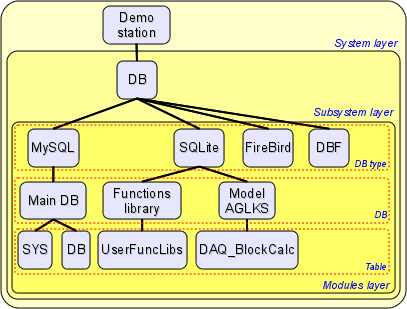
Fig. 4.1a. The hierarchical structure of "DB" subsystem.
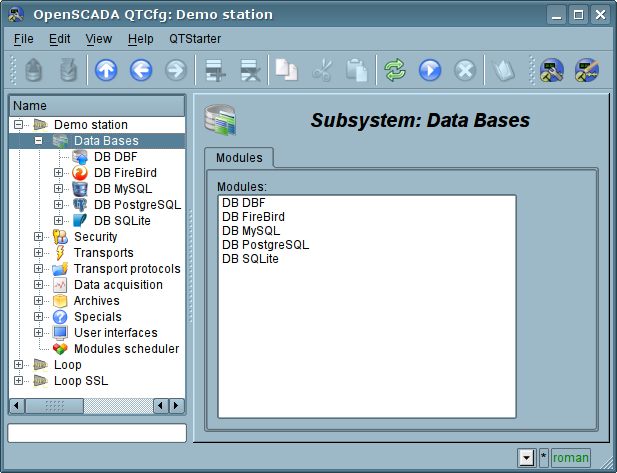
Fig. 4.1b. Tab "Modules" tab of the root page of "DB" subsystem.
Each module of the "DB" subsystem provides the configuration page with the following tabs: "DB" and "Module". "DB" tab (Fig. 4.1c) contains the list of databases registered in the module and the flag of the sign of full deleting of the database when making the delete command. In the context menu of the databases' list the user is provided with an opportunity to add, delete and move to the desired database. The "Module" tab contains information about the module of the "DB" subsystem (Fig.4.1d):
- Module — module's identifier.
- Name — module's name.
- Type — module's type, subsystem's identifier, which contains the module.
- Source — shared library — the source of the module.
- Version — module's version.
- Author — module's author.
- Description — module's short description.
- License — license agreement of module's distribution.
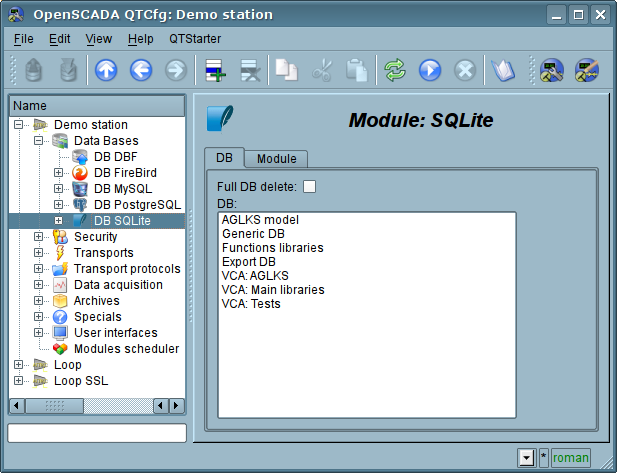
Fig. 4.1c. "DB" tab of the module of "DB" subsystem.
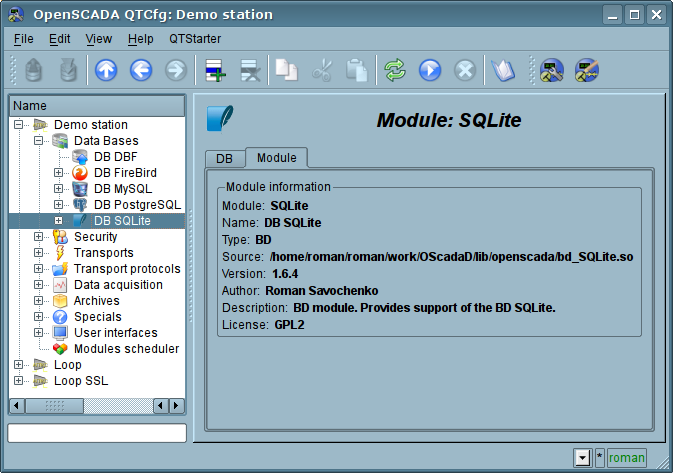
Fig. 4.1d. "Module" tab of the module of the "DB" subsystem.
Each database contains its own configuration page with the tabs "Data base", "Tables" and "SQL", in case SQL-requests support. Besides the basic operations you can copy the contents of the DB by means of the standard function for the copying the objects in the configurator. The copying operation the DB contents involves the copying of the original database to the destination database, and the contents of the destination database is not cleared before the copy operation. Copying the contents of database is made only when the both databases are enabled, otherwise it will run a simple copy of the object of the database.
Tab "Data base" (Fig.4.1e) contains the main configuration options of the DB as follows:
- Section "State" — contains the properties which characterize the DB status:
- Enable — DB status "Enable".
- Accessible tables — list of tables that are in the database. Context menu of the property gives the opportunity to physically remove the tables from the database.
- Load system from this DB — command to make load from this database. Can be used when transferring data in the database between stations. For example, you can save the section of one station in the export database, physically to move the DB to another station and connect it in this subsystem, and call this command.
- Section "Config" — contains the following configuration fields:
- ID — contains the information on the DB identifier.
- Name — specifies the DB name.
- Description — short description of the DB and it's appointment.
- Address — DB address in the specific for the database type (module) in the format. Format Description of the DB address recording format is usually available in the tooltip for this field.
- Code page — indicates the code page, in which the text values of database are stored and provided. The value of the code page of database in conjunction with the internal code page of the station is used for clear transcoding of the text message while exchange between the station and the database.
- To enable — indicates the state "Enable", in which to set the DB when start.
Tab "Tables" (Fig.4.1f) contains the list of the opened pages. In normal mode of the program operation this tab is empty, because after the completion of working with tables the program closes them. The presence of opened tables tells that the program is now working with tables or tables are opened by the user to examine their contents. In the context menu of list of opened tables you can open the table for study (the command "Add"), close the opened page (the command "Delete") and proceed to examination of the contents of the table.
Tab "SQL" (Fig.4.1g) allow only for data bases which support SQL-requests, and contains field to request enter, button to request send and table to result. To control the request transaction context provided by separate configuration field.
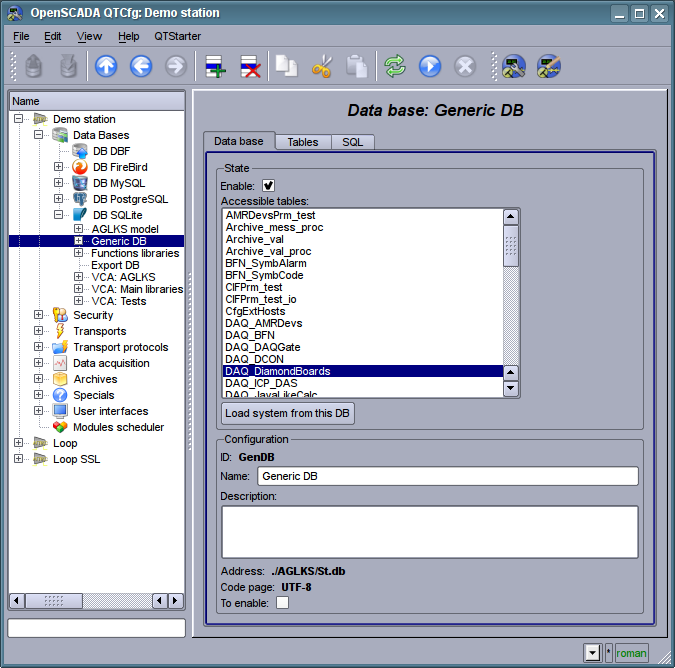
Fig. 4.1e. Tab "Data base" of the DB of module of subsystem "DB".
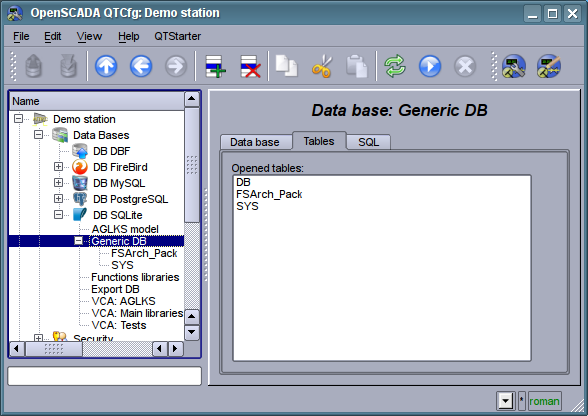
Fig. 4.1f. Tab "Tables" of the DB of module of subsystem "DB".
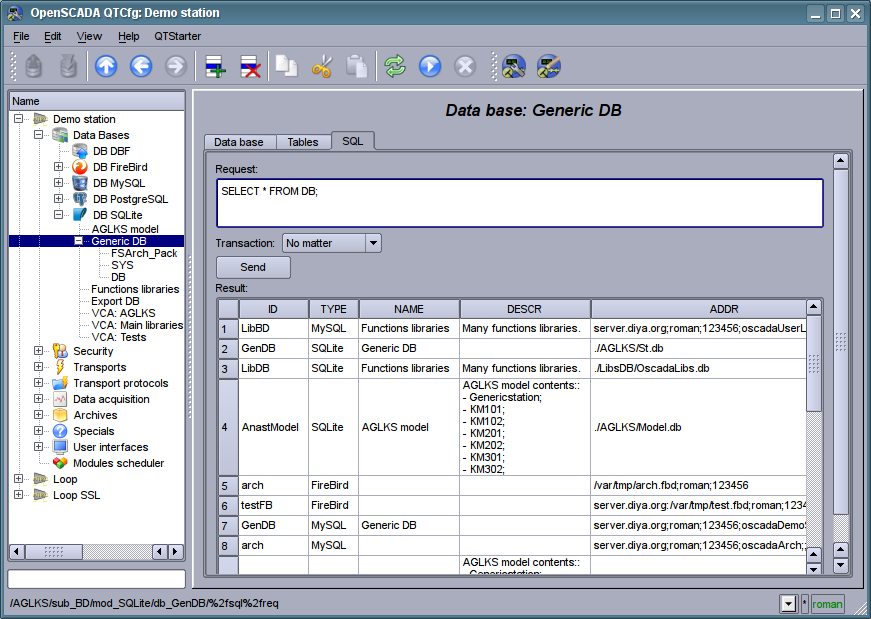
Fig. 4.1g. Tab "SQL" of the DB of module of subsystem "DB".
Page of the examination of the contents of the table contains only one tab, "Table". Tab "Table" (Figure 4.1h) contains the field of the name of the table and the table with the contents. Table of contents provides the following functions:
- table's cells content redaction;
- addition of the line;
- deleting of the line.
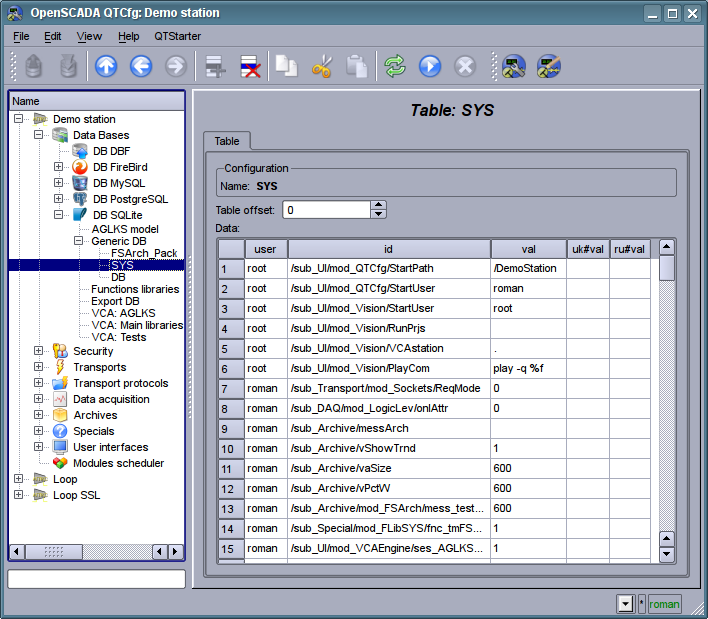
Fig. 4.1h. Tab "Table" of the DB table of the module of the subsystem "DB".
4.2. Subsystem "Security"
The subsystem is not modular one. To configure the subsystem the root page of the subsystem "Security" is provided, which contains the tab "Users and Groups". Tab "Users and Groups" (Figure 4.2a) contains the list of users and users' groups. Users in the group "Security" and with the rights of the privileged user can add, delete the user or group of users. All other users can go to the page the user or the users' group.
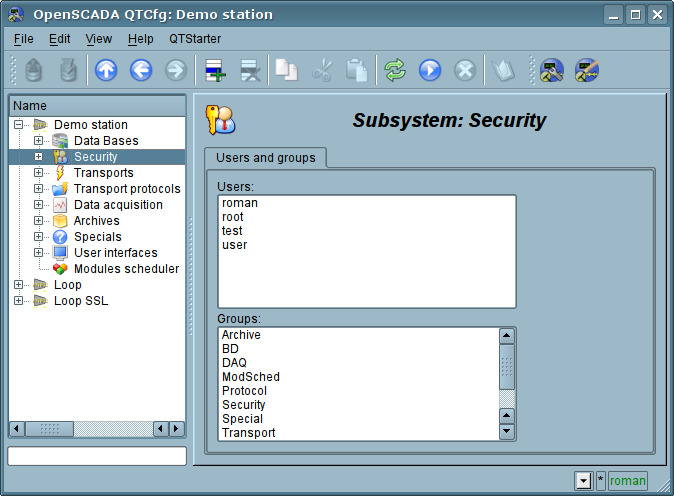
Fig. 4.2a. Tab "Users and Groups" of the root page of the subsystem "Security".
To configure the user it is provided the page containing only the tab "User" (Fig.4.2b). Tab contains the configuration data of the user's profile, which can be changed by the user itself, the user of the "Security" group or the privileged user:
- Name — information about the name (identifier) of the user.
- Full name — specifies the full name of the user.
- Description — description and random information about the user.
- Password — the field to change the user's password. It always displays "******".
- Language — user's language for the dynamic messages context and for text to speech of the user interface. Empty to the system language.
- User picture — specifies the user's picture. Picture can be loaded and saved.
- Groups — the table with a list of user groups of the station and with the sign of identity of the user to the groups.
- User DB — DB address for the user's data storage.
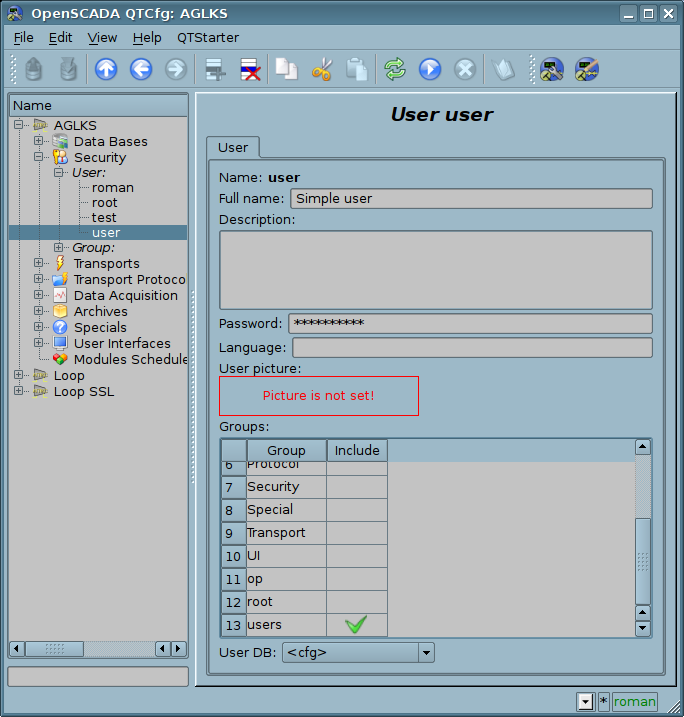
Fig. 4.2b. The tab "User" of the user's page of "Security" subsystem.
To configure the user's group it is provided the page containing only the tab "Group" (Fig.4.2c). Tab contains the configuration data of the group's profile, which can be changed only by the privileged use:
- Name — information about the name (identifier) of the user's group.
- Full name — specifies the full name of the user's group.
- Description — description and random information about the users group.
- Users — list of users included in this group. With the context menu of the list you can add or remove the user in the group.
- User group DB — DB address for the user group's data storage.
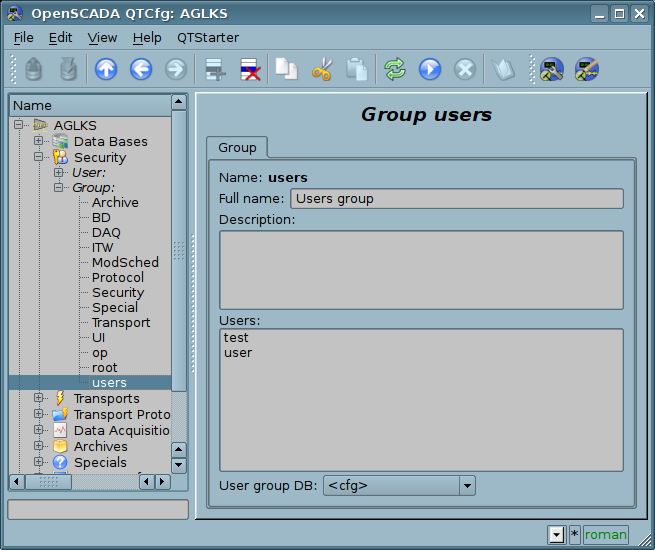
Fig. 4.2c. The tab "Group" of the user's group page of "Security" subsystem.
4.3. Subsystem "Transports"
The subsystem is the modular one and contains the hierarchy of objects shown in Figure 4.3a. To configure the subsystem it is provided the root page of the subsystem "Transports", containing the tabs "Subsystem" and "Modules".
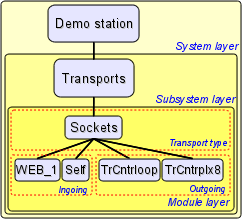
Fig. 4.3a. The hierarchical structure of subsystems "Transports".
The tab "Subsystem" (Figure 4.3b) contains the configuration table of the external stations for a given OpenSCADA. External stations can be the system, user and both ones that is selected by the appropriate column. System's external stations are available only to the super user and are used by the components of the system purpose, for example, the mechanism of the horizontal redundancy and module DAQ.DAQGate. User's external stations are tied to the user who created them, and thus the list of user's external stations is individual for each user. User's external stations are used by the components of graphical interface, for example, UI.QTCfg, UI.WebCfgD and UI.Vision. In the table of the external stations it is possible to add and delete records about the station, as well as their modification.
Each station contains the following fields:
- Id — identifier of the external station.
- Name — the name of the external host.
- Transport — the combobox of the subsystem's module "Transports" for the using of it when access to the external station.
- Address — address of the external station if the format, specific to the chosen in the previous field of the module of the subsystem "Transports".
- User — the name/identifier of the user of the external station on behalf of whom to perform the connection.
- Password — password of the user of the external station.
- Mode — The host mode: "User", "System", "User and System".
- Uprising level — Uprising hosts level of the pointed host for possibility of the requests re-transmission.
Tab "Moules" tab (fig. 4.1b) contains the list of modules in subsystem "Transports" and it is identical for all modular subsystems.
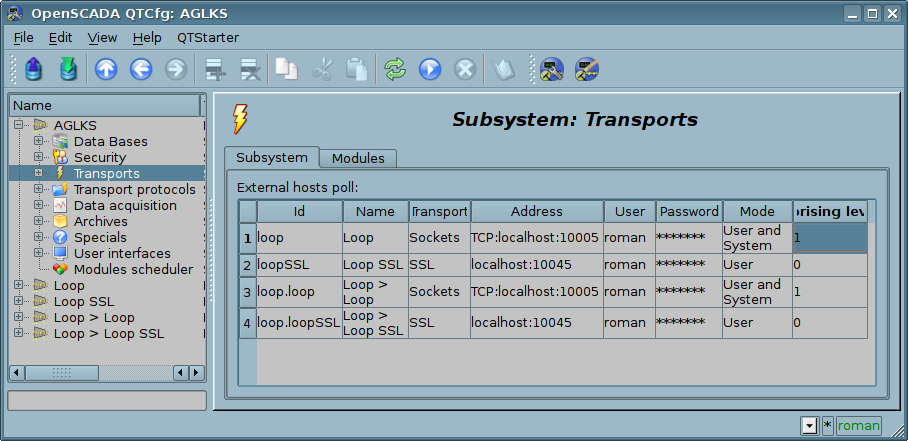
Fig. 4.3b. Tab "Subsystem" of the root page of subsystem "Transports".
Each module of the subsystem "Transports" provides the configuration page with the tabs "Transports" and "Module". The tab "Transports" (Fig.4.3c) contains the list of incoming and outgoing transports registered in the module. The context menu of lists of transports provides the user with the possibility to add, delete and move to the desired transport. On the "Module" tab it is provided the information about the module of subsystem "Transports" (Fig. 4.1d), whose structure is identical for all modules.
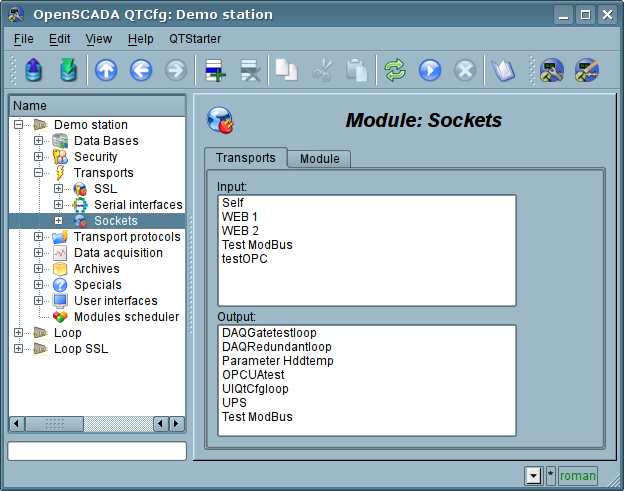
Fig. 4.3c. The tab "Transports" of the module of subsystem "Transports".
Each transport contains its own configuration page with one tab "Transport". This tab contains the basic settings of transport. Incoming transport (fig.4.3d) includes:
- Section "State" — contains the settings that characterize the state of the transport:
- Status — information on the current transport's status and statistics of its work.
- Running — state of the transport "Running".
- Transport DB — DB address to store the transport's data.
- Section "Config" — directly contains the configuration fields:
- ID — information on the transport's identifier.
- Name — specifies the transport's name.
- Description — brief description of the transport and its appointment.
- Address — transport's address in the specific for the type of transport (module) format. Description of the record format addresses transport, as a rule, is available in the tooltip for this field.
- Transport protocol — indicates the transport protocol module (subsystem "Transport protocols") that should work in conjunction with the input transport. Ie the received unstructured data this module will sent to the structuring and processing to the specified module of the transport protocol.
- To start — indicates the status of "Running", in which to transfer the transport at startup.
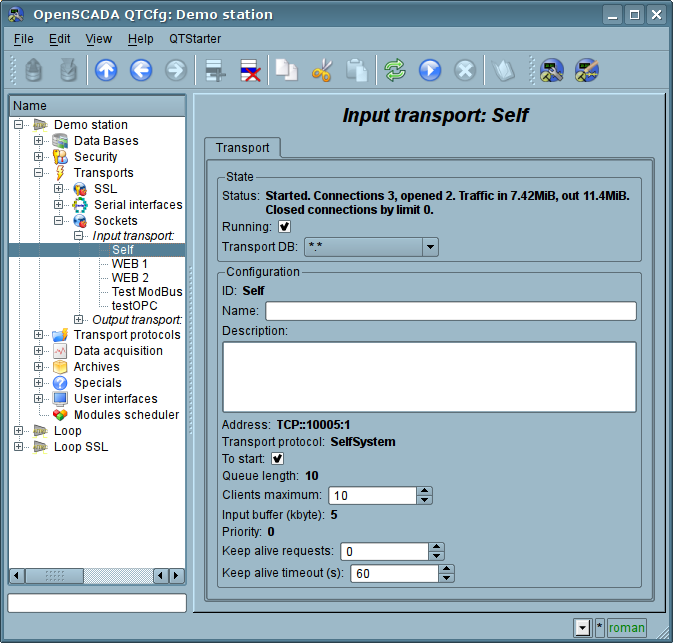
Fig. 4.3d. Tab "Transport" of the page of incoming transport of module of subsystem "Transports".
Outgoing transport (Fig. 4.3e) contains:
- Section "State" — contains the settings that characterize the state of the transport:
- Status — information on the current transport's status and statistics of its work.
- Running — state of the transport "Running".
- Transport DB — DB address to store the transport's data.
- Section "Config" — directly contains the configuration fields:
- ID — information on the transport's identifier.
- Name — specifies the transport's name.
- Description — brief description of the transport and its appointment.
- Address — transport's address in the specific for the type of transport (module) format. Description of the record format addresses transport, as a rule, is available in the tooltip for this field.
- To start — indicates the status of "Running", in which to transfer the transport at startup.
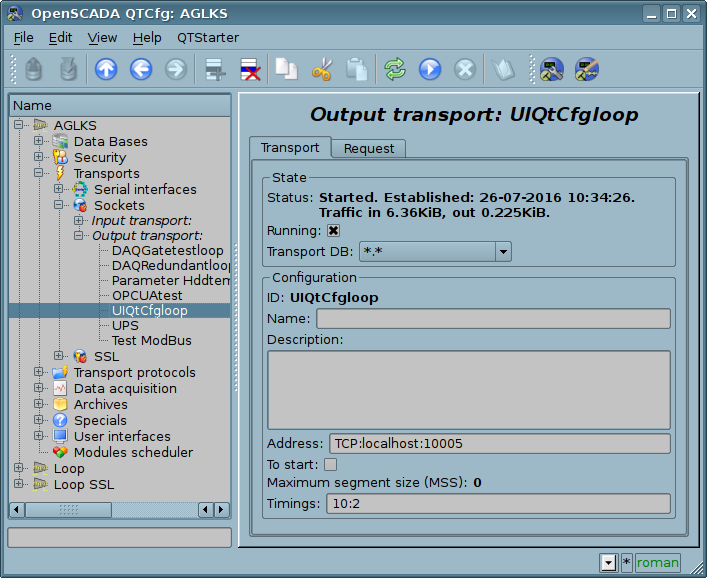
Fig. 4.3e. Tab "Transport" of the page of outgoing transport of module of subsystem "Transports".
Outgoing transport, in addition, provides the tab for forming the user request via this transport (Fig.4.3f). The tab is provided for setting communication, as well as for debugging the protocols and includes:
- Time (ms) — information about the time taken for request and receiving the answer.
- Mode — indicates the regime of data from the following list: "Binary", "Text(LF)", "Text(CR)", "Text(CR/LF)", in which the request will be formed and the answer will be provided. In binary mode data is recorded in pairs of numbers in hex, ie bytes, separated by spaces.
- Timeout wait — sign for expect by timeout when a response is received. Many systems in response to various protocols (HTTP) are send the response data in several pieces. Without this flag will be received and displayed only the first piece. When this flag will be set all the pieces awaiting an answer, until the lack of data during the timeout the transport elapsed .
- Input buffer size, bytes — control of the input buffer size and the reading disabling (0) at all, only writing.
- Send — command to send a request.
- Request — contains the request in the selected mode of data representing.
- Answer — provides the answer in the selected mode of data representing.
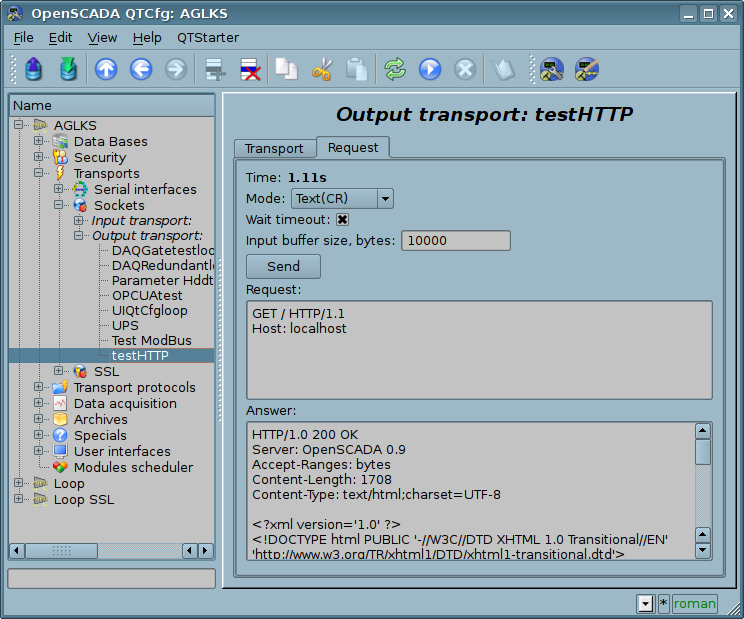
Fig. 4.3f. The tab "Request" of the page of outgoing transport of module of subsystem "Transports".
4.4. Subsystem "Transport protocols"
The subsystem is modular. To configure the subsystem the root page of the subsystem "Transport Protocols" is provided, it contains tab "Modules". The tab "Modules" (Fig. 4.1b) contains the list of modules in subsystem "Transport Protocols" and is identical for all modular subsystems.
Each module of subsystem "Transport Protocols" provides configuration page with the only one tab — "Module". On the tab "Module" there is the information on the module of subsystem "Transport Protocols" (Fig. 4.1d), which structure is identical for all modules.
4.5. Subsystem "Data acquisition"
The subsystem is modular and contains the hierarchy of objects depicted in Fig.4.5a. To configure the subsystem the root page of subsystem "Data acquisition" is provided, which contains the tabs "Redundancy", "Template libraries" and "Modules".
To obtain access to modify the objects of this subsystem the user of the group "DAQ" or the rights of the privileged user are required.
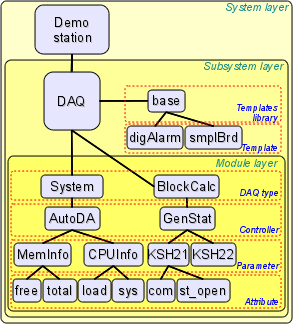
Fig. 4.5a. The hierarchical structure of subsystem "Data acquisition".
As a redundancy object of the subsystem "Data Acquisition" there used the object of controller for which the redundancy process performs that functions:
- Redundancy of the data acquisition mechanism. Typically, this function is realized without special arrangements by simply running of the parallel redundancy stations with the same configuration and working independently. However, in the case at the station, which works as PLC, such approach is unacceptable because of the simultaneous making of control actions and the absence of synchronization of calculators' data.
- Compensation of the data loss on the time of the node stop with the redundant node archive. There are two mechanisms of compensation. The first and the main mechanism implements the loading of the sections of the archive from the redundant station at the time of the station startup in general or of individual controller's objects. The section of the archive is requested from the moment of the last record in the local archive and till the current time. The depth of the request is limited by the indicating of the limit time in the configuration of the redundancy. The second, complementary mechanism, performs the filling of the "holes" in the archive at the time of the actual user's request to the data. Such an approach on the one hand allows to make the predictable in time synchronization at startup and on the other hand it's actually eliminates the data loss in the case of working at least one station during the entire time.
- Load distribution of data acquisition between the nodes. When creating complex allocated systems there can be an important question of predicting and optimizing of the overall system performance. Taking into account these problems the redundancy mechanism provides the execution of tasks of data acquisition of individual sources (OpenSCADA controllers) only at one station. The other stations' tasks would go to data synchronization mode with the executive station. In the case of loss of the connection with the executive station the task of the local data acquisition is started. It's also provided the possibility of optimal the load distribution of the execution of data acquisition task's of the controllers' group between the stations.
- Optimization of the load on the external data sources through the data request from an external source by the only one node. In practice, we often meet highly loaded data sources or interfaces of access to the data sources, for which even the data acquisition by one station can be a problem and would require reducing the acquisition periodicity, i.e. data quality. The mechanism of redundancy, besides the load distribution between the stations as described above allows you to remove an additional load form the data source and its interfaces, thereby improving the quality of data. Writing to attributes of the controller's object under redundancy causes to the modification request sending to the master one, that is through it.
- Prevention of some differences of data on different nodes associated with the mismatch of moments of time at the independent acquisition of data by individual nodes by means of receiving the data from the station with an active controller. In systems of high accountability under the redundancy there should be excluded or minimized the differences in the data at different stations, that means the real acquisition of data by one station and synchronization with these data of other ones.
Tab "Redundancy" (Fig. 4.5b) presented only if at last one station pointed into the redundancy and contains the configuration of redundancy of data sources of subsystem "Data acquisition" with the following settings:
- Restore data depth time (hours) — indicates the maximum depth of archival data to restore from the archive of the remote station when start up in hours (0-12).
- Controllers — contains the table with the list of controllers, available for redundancy, and their current status:
- Controller — full controller's ID;
- Name — controller's name;
- Started — the sign of the controller's execution on the local station;
- Redundant — redundancy mode of the controller, you can select it from the list:
- "Off" — absolutely independent working of the controller's object.
- "Asymmetric" — full redundancy with the allowed controller's object configuration of the remote station and without tries to generalize its.
- "Only alarms" — in fact it is working without a redundancy, but with alarms oppressing from the reserve controller's object to exclude a duple messages into the alarms.
- Preferable run — configuration of the preferred execution at the specified station can be changed; reserved values:
- <High Level> — execution at the station with the highest level.
- <Low Level> — execution at the station with the lowest level.
- <Optimal> — the choice for the execution of the least loaded station.
- Remoted — sign indicating the execution of the controller on the remote station and work the local station in mode with a remote data synchronization.
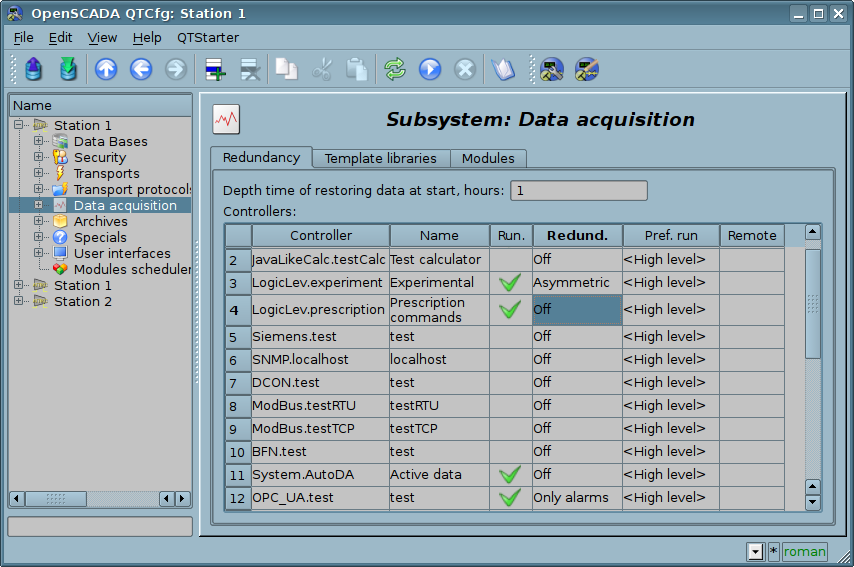
Fig. 4.5b. Tab "Redundancy" tab of subsystem "Data acquisition".
The tab "Template libraries" (Fig.4.5c) contains the list of libraries of templates for the parameters of this subsystem. In the context menu of the list of template libraries the user can add, delete and move to the desired library. The tab "Modules" (Fig. 4.1b) contains the list of modules in the subsystem "Transports" and is identical for all modular subsystems.
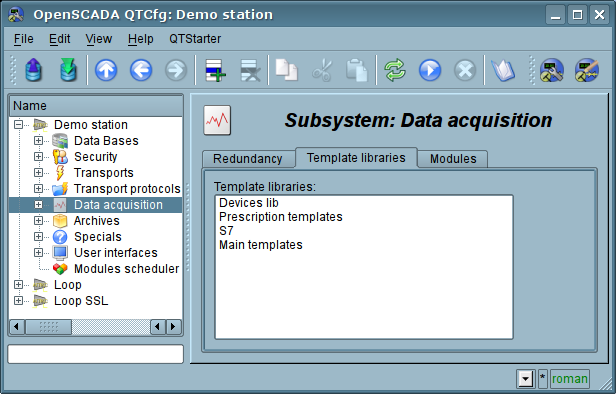
Fig. 4.5c. The tab "Template libraries" of the subsystem "Data acquisition".
Each template library of subsystem "Data acquisition" provides the configuration page with the tabs "Library" and "Parameter templates". Tab "Library" (fig. 4.5d) contains the basic settings of the library:
- Section "State" — contains properties that characterize the state of the library:
- Accessing — state of library "Accessing".
- Library DB — address of the database for data storage of the library and templates.
- Date of modification — date and time for the object last modification.
- Section "Config" — directly contains the configuration fields:
- ID — information on the ID of the library.
- Name — specifies the name of the library.
- Description — short description of the library and its purpose.
Tab "Parameter templates" (Fig.4.5e) contains the list of templates in the library. In the context menu of the list the user can add, delete and move to the desired template.
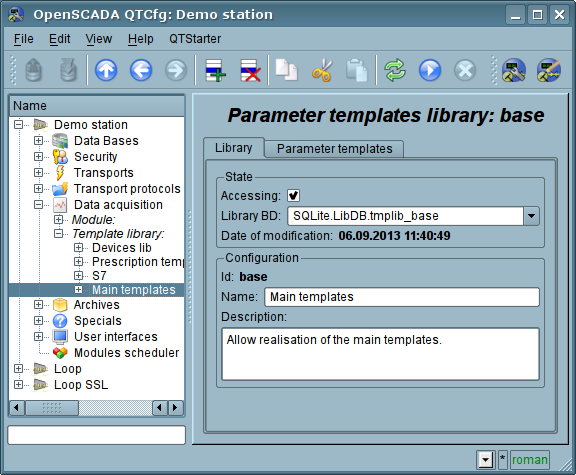
Fig. 4.5d. The main tab of configuration of template library of subsystem "Data acquisition".
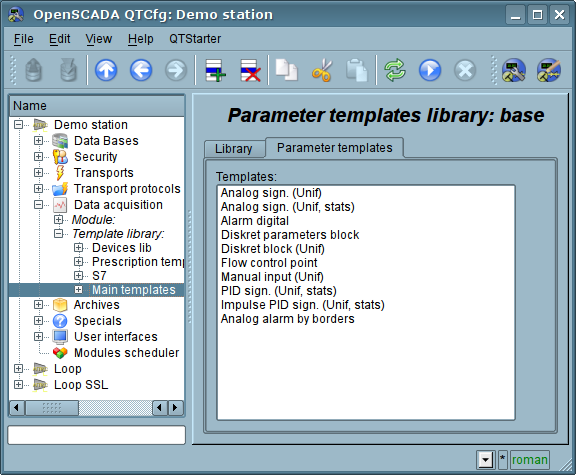
Fig. 4.5e. The tab of the list of templates in the template library of subsystem "Data acquisition".
Each template of the template library provides the configuration page with the tabs "Template" and "IO". The tab "Template" (Figure 4.5f) contains the basic settings of the template:
- Section "State" — contains properties that characterize the state of the template:
- Accessing — state of template "Accessing".
- Used — counter of the template's using. Allows you to determine whether the template is used and, consequently, the ability to edit the template.
- Date of modification — date and time for the object last modification.
- Section "Config" — directly contains the configuration fields:
- ID — information on the ID of the template.
- Name — specifies the name of the template.
- Description — short description of the template and its purpose.
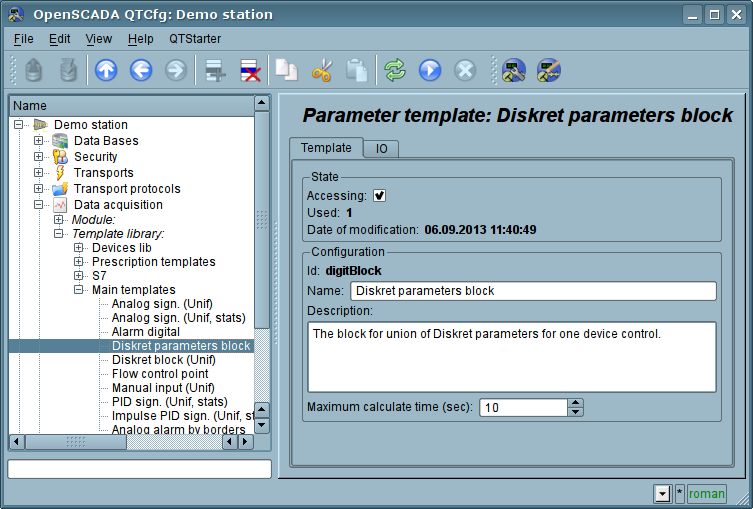
Fig. 4.5f. The main configuration tab of the parameters template of subsystem "Data acquisition".
The tab "IO" (Fig.4.5g) contains the configuration of attributes (IO) of templates and the program of template on the one of languages of the user programming of OpenSCADA, for example, DAQ.JavaLikeCalc.JavaScript. To the table of attributes of template user can, through the context menu, add, insert, delete, move up or down the record of attribute, as well as edit the attribute's fields:
- Id — ID of the attribute.
- Name — the name of the attribute.
- Type — select the value's type of the attribute from the following: "Real", "Integer", "Boolean", "String", "Text", "Object".
- Mode — select the mode from list: "Input", "Output". Typically used to indicate the direction of data transmission through link. Ie, values for "Input" data link will only be obtained, and for the "Output" will also be transferred, in the case of modification.
- Attribute — mode of the parameter's attribute, implemented based on a template from the list: "No attribute" ,"Read Only","Full access". For the attributes of a template, in which this field is set, it will be created an appropriate attribute in the controller's parameter of this subsystem.
- Configure — configuration mode of the attribute in the configuration tab of a template of the controller's parameter of this subsystem from the list: "Variable", "Constant", "Link". In "Constant" and "Link" modes tab in the configuration tab of the template will be added these attributes to set the constant or specify an external link of the parameter.
- Value — attribute's default value or template of the links to access by the link. The format of the link's template depends on the component that uses it. Usually for the module DAQ.LogicLev the link's template is written the following way: {Parameter}|{attribute}. Field {Parameter} — specifies the parameter's name as the attribute's container. Attributes with the equal value {Parameter} will be grouped and will be appointed only by the indication of attributes' container, and individual attributes will be associated with the attributes of the container in accordance with the field {attribute}.
The syntax of the language of the template's program you can see in the documentation of the module, providing an interpreter of the chosen language. For example, a typical user programming language of OpenSCADA — DAQ.JavaLikeCalc.
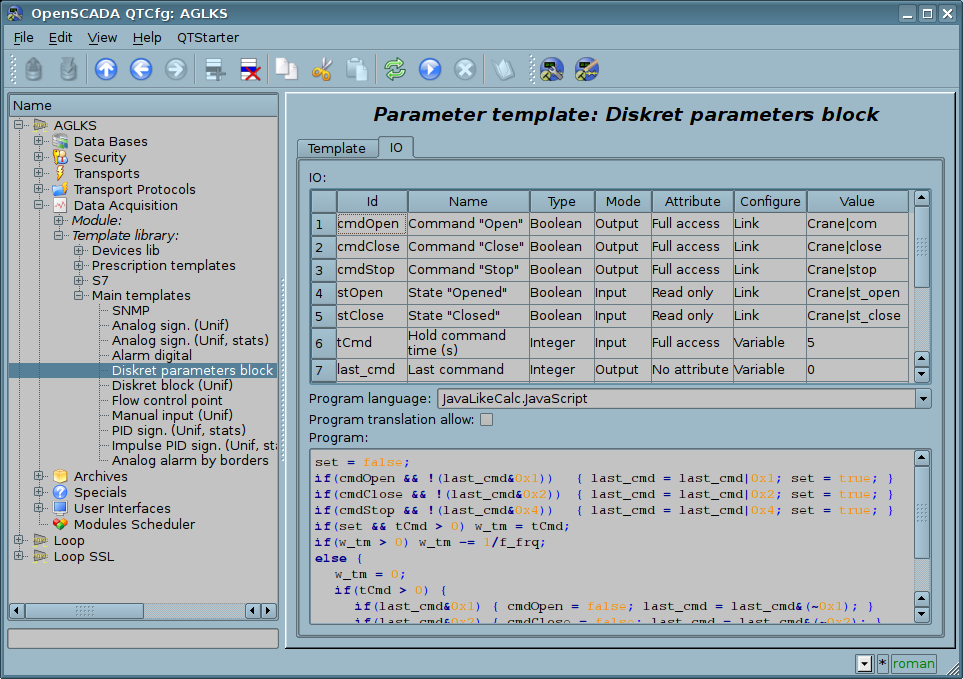
Fig. 4.5g. The configuration tab of the attributes and template's program of subsystem "Data acquisition".
Each module of the subsystem "Data acquisition" provides the configuration page with the tabs "Controllers" and "Module". The tab "Controllers" (Fig.4.5h) contains the list of controllers, registered in the module. In the context menu user can add, delete and move to the desired controller. The tab "Module" provides information about the module of the subsystem "Data acquisition" (Fig. 4.1d), which structure is identical for all modules.
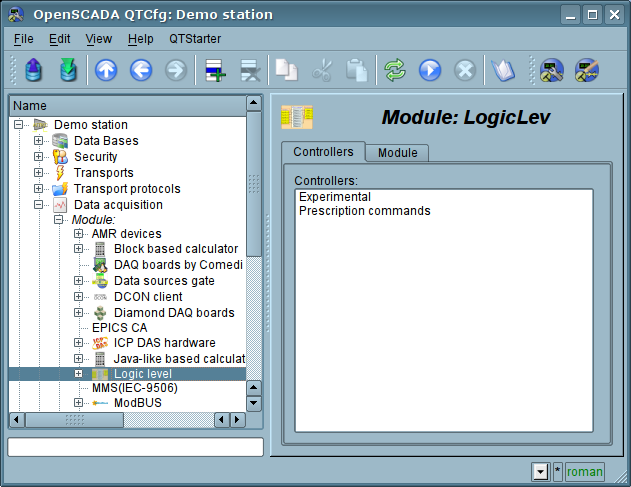
Fig. 4.5h. The tab "Controllers" of the module of the subsystem "Data acquisition".
Each controller contains its own configuration page with the tabs "Controller" and "Parameters".
The tab "Controller" (Fig.4.5i) contains the basic settings. The structure of these settings may differ slightly from one module of this subsystem to another, as you can find in the own documentation of modules. As an example, lets examine the settings of the controller in the module of the controller of logic DAQ.LogicLev:
- Section "State" — contains the properties, which characterize the state of the controller:
- Status — specifies the controller's status. In our case, the controller is running and the computation time is 425 microseconds.
- Enable — the state of the controller "Enable". When enabled, the controller provides the possibility of creating the parameters and their configuration.
- Run — the state of the controller "Run". The running controller performs the physical data acquisition and/or includes mechanisms for access to these data.
- Controller DB — the address of the database for data storage of the controller and its parameters.
- Section "Config" — directly contains the configuration fields:
- ID — information on the controller's identifier.
- Name — specifies the controller's name.
- Description — brief description of the controller and its purpose.
- To enable — indicates the status of "Enable" in which to transfer the controller at startup.
- To start — indicates the status of "Run" in which to transfer the controller at startup.
- Parameters tables — names of tables that store the parameters of different types (refers to parameter objects of data acquisition).
- Calc schedule — defines a periodic or scheduled character of calculations. In our example this one second of calculation template.
- Request task priority — sets the priority of data acquisition of this controller. It is used when scheduling the operating system tasks. In the case of proper access availability this field includes the planning of the controller's task in real time and with the specified priority otherwise it modifies parameter "nice" of the task.
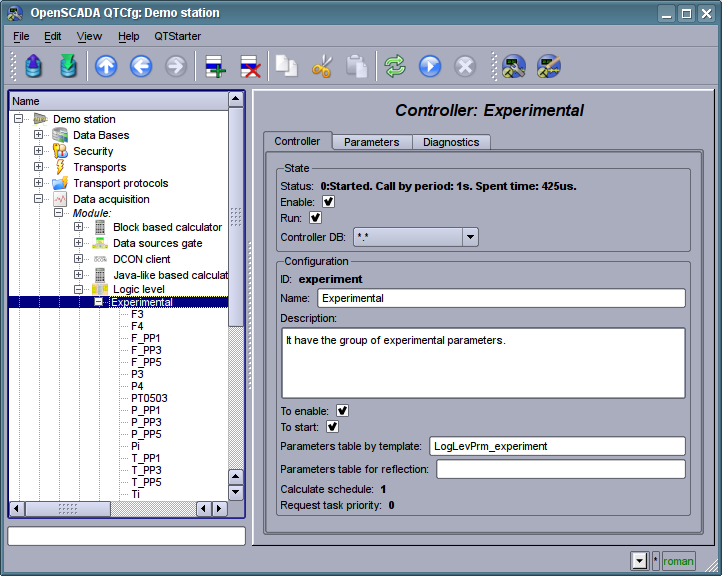
Fig. 4.5i. The main configuration tab of the controller of subsystem "Data acquisition".
"Parameters" tab (Fig.4.5j) contains a list of parameters in the controller, select the type of parameters that are created by default, as well as information on the total number and the number of enabled parameters. In the context menu user can add, delete and move to the desired parameter.
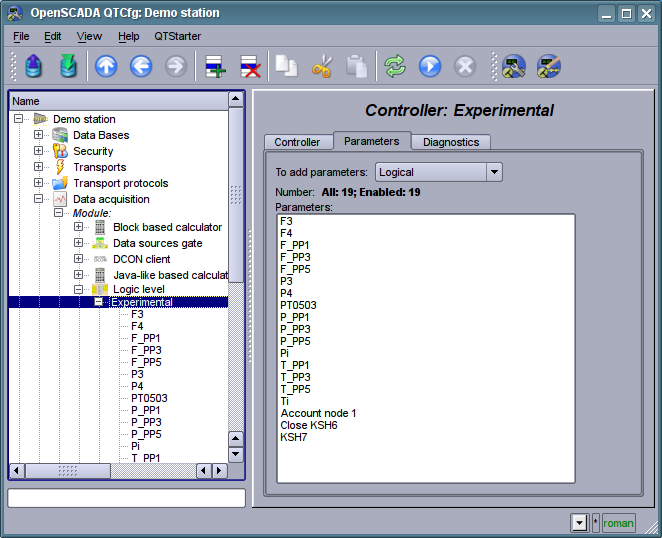
Fig. 4.5j. "Parameters" tab of the configuration page of the controller of subsystem "Data acquisition".
"Diagnostic" tab (Fig.4.5k) contains diagnostic messages form by the data source. More data sources is external devices with accessing to the data by a network connection or a system bus then there possible different emergency situation on access to the data. Print all its to field "State" of controller object impossible due it display only current access data state. Due the diagnostic you can trace all emergency situation at messages view, which forming by the controller object for specified period of time and by selected messages level. Besides to certain diagnostic information some modules of data sources can provide here debug exchange dumps, on messages level "Debug (0)".
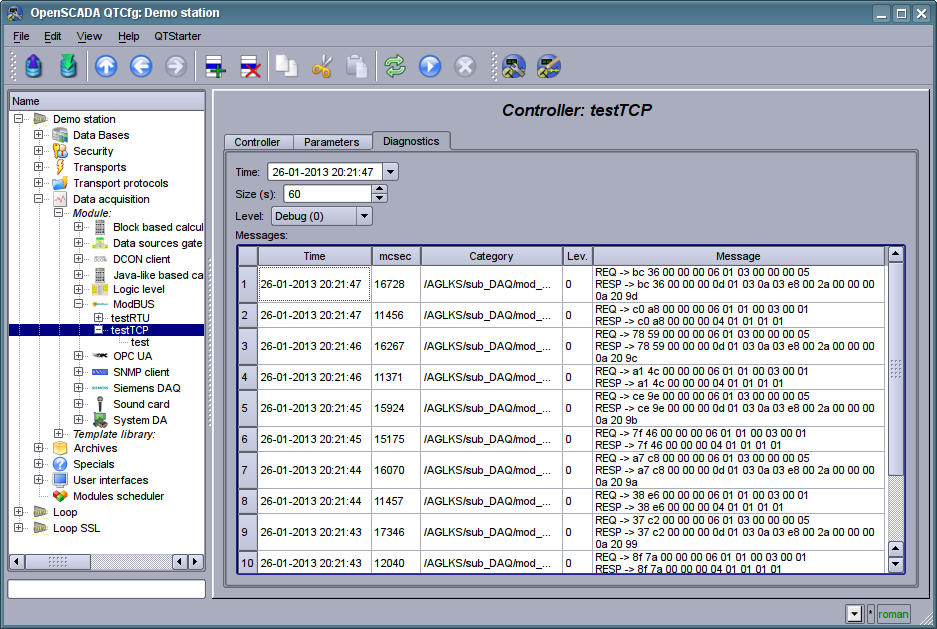
Fig. 4.5k. "Diagnostic" tab of configuration page of the controller of subsystem "Data acquisition".
Parameters of the controllers of subsystem "Data acquisition" provides the configuration page with the tabs "Parameters", "Attributes", "Archiving" and "Template config". The tab "Template config" is not standard, but it is present only in the parameters of modules of subsystem "Data acquisition", which implement the mechanisms of working under the template in the context of the data source, which they are served, for logical type. In this review this tab is included for logical completeness of the review of the configuration of templates of parameters of subsystem "Data acquisition" and as the final stage — using.
The tab "Parameter" (Fig.4.5l) contains the main settings:
- Section "State" — contains the properties, which characterize the state of the parameter:
- Type — specifies the type parameter. Type of disabled parameter can be changed if there are multiple types.
- Enable — the state of the parameter "Enable". Enabled parameter is used by the controller fro data acquisition.
- Section "Config" — directly contains the configuration fields:
- ID — information on the parameter's identifier.
- Name — specifies the parameter's name.
- Description — brief description of the parameter and its purpose.
- To enable — indicates the status of "Run" in which to transfer the parameter at startup.
- Parameter template — the address of the previously discussed template.
The tab "Attributes" (Fig.4.5m) contains the parametr's attributes and their values in accordance with the configuration of the used template and calculation of its program.
The "Archiving" tab (Fig.4.5n) contains the table with the attributes of a parameter in the columns and the archivers in rows. The user can set the archiving for the desired attribute with the required archiver simply by changing the cell at the intersection.
The "Template config" tab (Figure 4.5o) contains the configuration fields in accordance with the template. In this example it is the group link on the external parameter. This link can be set simply by pointing the way to the parameter if the flag "Only attributes are to be shown" is not set, or to set the addresses of the attributes separately in the case if the flag is set. Sign "(+)", at the end of the address signals about successful linking and presence of the target.
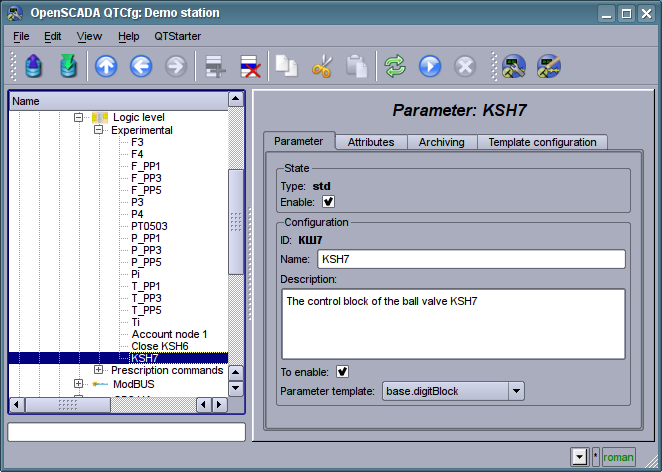
Fig. 4.5l. The main configuration tab of the parameter of the controller of subsystem "Data acquisition".
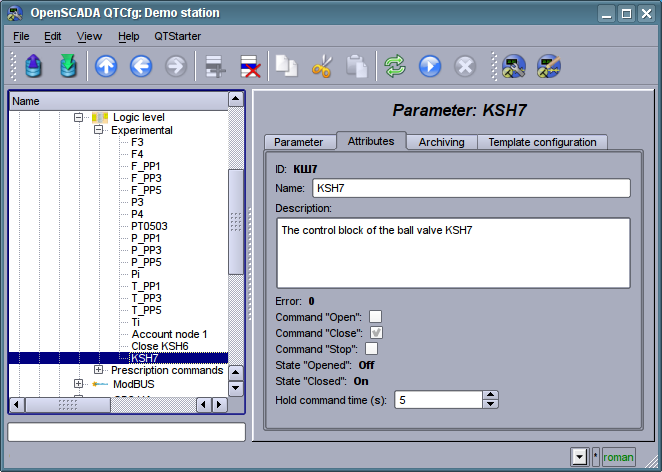
Fig. 4.5m. The "Attributes" tab of the parameter of the controller of subsystem "Data acquisition".
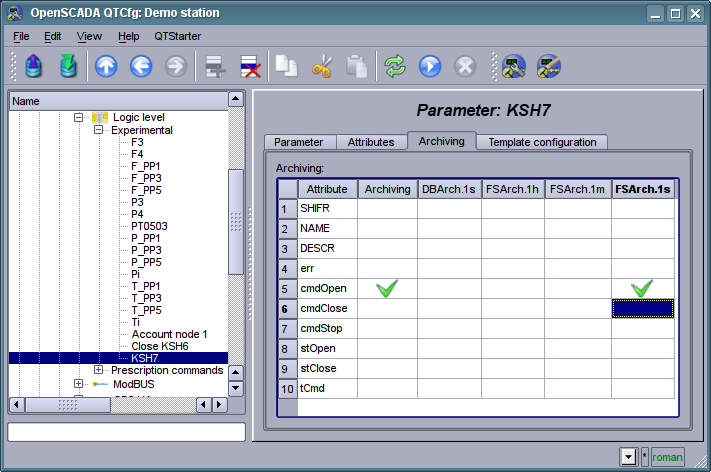
Fig. 4.5n. The "Archiving" tab of the parameter of the controller of subsystem "Data acquisition".
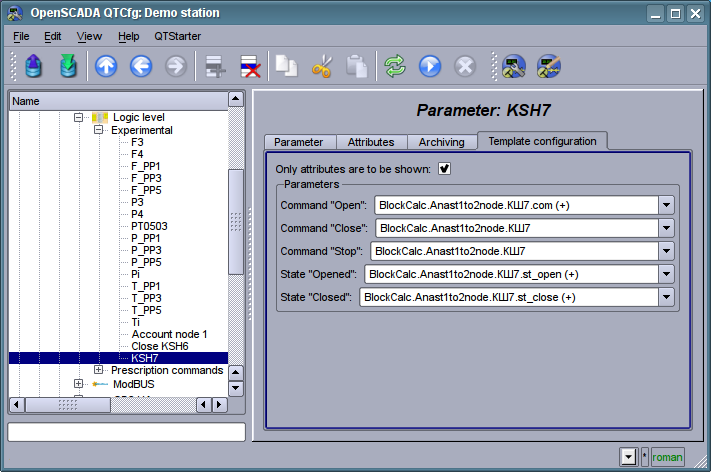
Fig. 4.5o. The "Template config" tab of the parameter of the controller of subsystem "Data acquisition".
4.6. Subsystem "Archives"
The subsystem is modular and contains the hierarchy of objects depicted in Fig.4.6a. To configure the subsystem the root page of the subsystem "Archives" is provided, it contains tabs: "Redundancy", "Messages archive", "Value archives" and "Modules".
To gain the access to modify the objects of this subsystem the user of the group "Archive" or the privileged user rights are required.
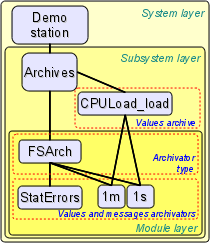
Fig. 4.6a. The hierarchical structure of subsystem "Archives"
As a redundancy object of the subsystem "Archives" there used the object of messages archivator for which the redundancy process performs that functions:
- Redundancy of the data acquisition mechanism. It's means of messages combination from the redundant stations by the three mechanisms:
- in the main cycle of redundancy there performs a request for new messages of the archivator on the master station from a last message time of the redundant object;
- writing messages to the redundant archivator causes to redirection of the writing request to to the master station both for new and rewriting messages (also the messages write locally);
- rewriting messages to the master archivator causes to the messages sending for all redundant stations.
- Compensation of the data loss on the time of the node stop with the redundant node archive. There provides only an initial synchronization by loading/reloading of parts of the archive from the redundant station, at the station starting in general. The archive's part requested from the moment of the last record into the local archive minus value of the parameter of the depth of the forced reloading and till the current time. Changed messages to more depth from the pointed should be lost on the started station!
- Load distribution of data acquisition between the nodes. When creating complex allocated systems there can be an important question of predicting and optimizing of the overall system performance. Taking into account these problems the redundancy mechanism provides the execution of tasks of archivation of individual archivators only at one station. The other stations' tasks would go to data synchronization mode with the executive station. In the case of loss of the connection with the executive station the task of the local archivation is started. It's also provided the possibility of optimal the load distribution of the execution of archivation task's of the archivators' group between the stations.
- Restoring of the alarms primacy. For alarming messages, negative level, at its writing performs an additional processing for the active alarms, that is only old — original ones allow for rewriting.
Redundancy of the value archivators doesn't provided directly but that process does through data sources and the subsystem of "Data acquisition".
Tab "Redundancy" (Fig. 4.6b) presented only if at last one station pointed into the redundancy and contains the configuration of redundancy of messages archvators with the following settings:
- Overtime of the reserve history reload at start, hours — points to the messages requesting depth from time of the last message into the local archive. Sometime that can be usable for reloading last messages if its can be potential changed-updated at the station down.
- Message archivators — contains the table with the list of message archivators, available for redundancy, and their current status:
- Archivator — full archivator's ID;
- Name — archivator's name;
- Started — the sign of the archivator's execution on the local station;
- Redundant — redundancy mode of the archivator, enabling;
- Preferable run — configuration of the preferred execution at the specified station can be changed; reserved values:
- <High Level> — execution at the station with the highest level.
- <Low Level> — execution at the station with the lowest level.
- <Optimal> — the choice for the execution of the least loaded station.
- Remoted — sign indicating the execution of the archivator on the remote station and work the local station in mode with a remote data synchronization.
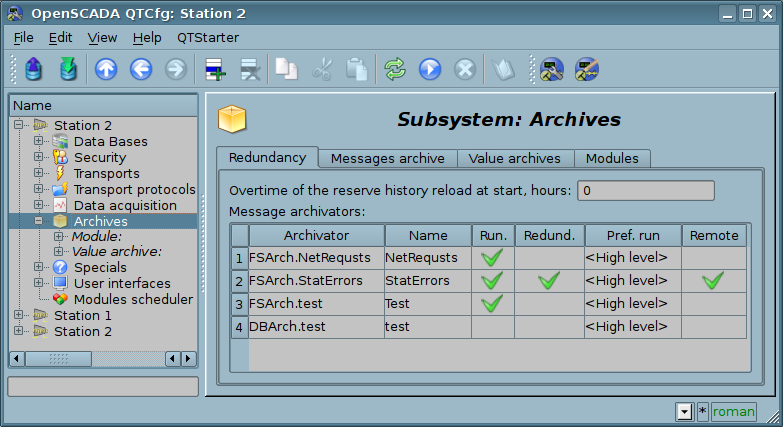
Fig. 4.6b. The "Redundancy" tab of subsystem "Archives".
The "Messages archive" tab (Fig.4.6c) contains the configuration of messages archive and the request form of messages from the archive.
Configuration of the messages archive is represented by the fields:
- Messages buffer size — indicates the dimension of the area of memory reserved for the interim buffer of messages. Messages from the buffer are requested for viewing and archived with the messages archivers.
- Archiving period (s) — the periodicity with which the archivers select messages from the buffer for their archiving.
The messages request form contains the configuration fields of the request and the table of results. Configuration fields of the request are:
- Time, size (s) and level — specifies the request time, the size or the depth (in seconds) and the minimum level of messages (more than or equal).
- Category pattern — specifies the category of the requested messages. In the category you can specify the elements of a sample of the template, namely, the characters '*' — for any string and '?' — for any character, as well as a regular expression enclosed between '/' (/mod_(System|LogicLev)/).
- Archivators — indicates the messages archivators (separated by symbol ';'), for which the request is to be processed. If the value is missing, the request will be processed for the buffer and all archivers. If "<buffer>" is specified, then the request will be processed for the messages buffer.
The result table contains rows of messages with the following columns:
- Time — message's time.
- Category — message's category.
- Level — message's level.
- Message — message's text.
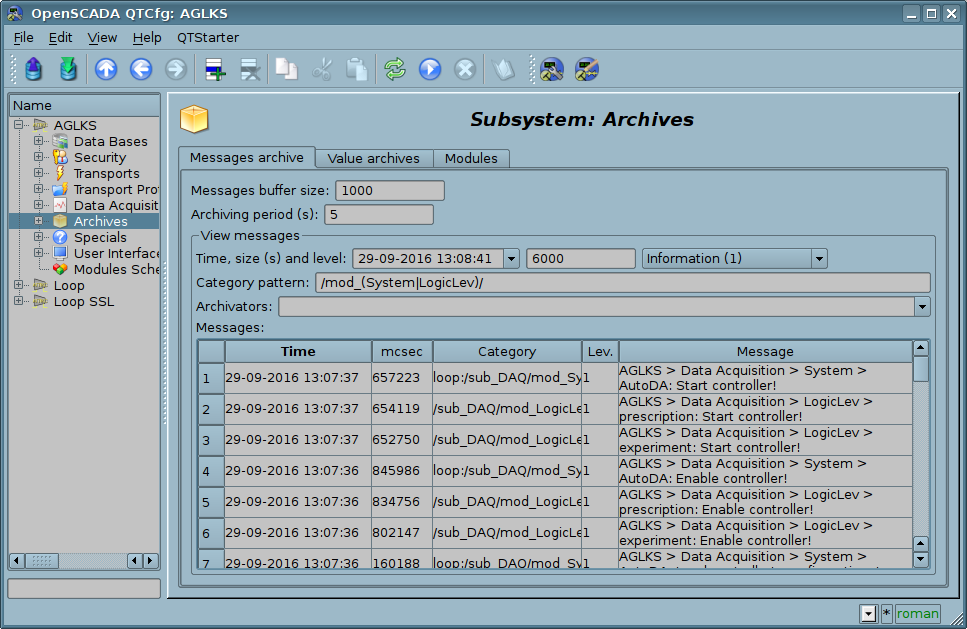
Fig. 4.6c. The "Messages archive" tab of the subsystem "Archives".
Tab "Value archives" (Fig.4.6d) contains the general configuration of value's archiving and the list of archives of values. In the context menu of the list of values the user has the opportunity to add, delete and move to the desired archive. The general configuration of archiving is represented by the fields:
- Get data period (ms) — indicates the periodicity of the active archiving task. In fact, the highest level of detail or the minimum period of active archives is determined by this value.
- Get data task priority level — sets the priority of task of active archiving. It is used when scheduling the operating system tasks. In the case of proper access availability this field includes the planning of the archiving task in real time and with the specified priority otherwise it modifies parameter "nice" of the task.
- Variable timestamp force to current time — time-stamp of values, received on the active archivation, forces to current time, replaces the data source time.
The "Modules" tab (Fig. 4.1b) contains a list of modules in subsystem "Archives" and it is identical for all modular subsystems.
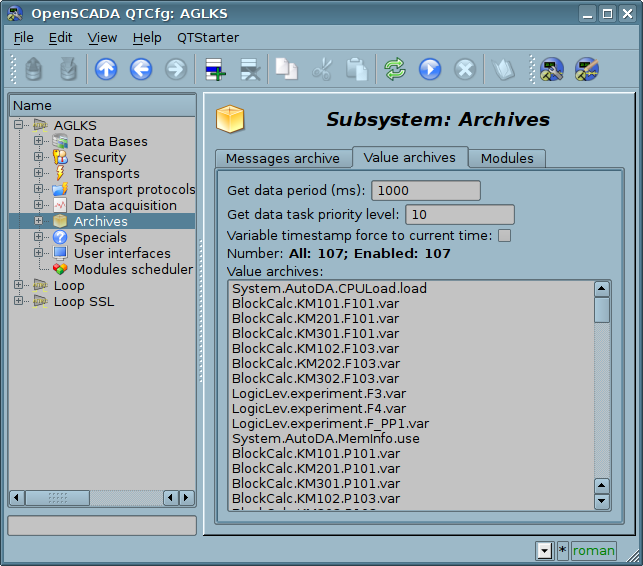
Fig. 4.6d. The "Value archives" tab of the subsystem "Archives".
Archive of values of subsystem "Archives" provides the configuration page with the tabs "Archive", "Archivators" and "Values".
Tab "Archive" (Fig.4.6e) contains the basic settings of the archive:
- Section "State" — Contains the properties, which characterize the state of the archive:
- Running — The state of the parameter "Running". Running archive collects data in the buffer and is served by the archivators.
- Buffer start and end — Time of values begin and end into the buffer.
- Archive DB — Database address for storing the archive's data.
- Section "Config" — Directly contains the configuration fields:
- ID — Information on the archive's identifier.
- Name — Specifies the archive's name.
- Description — Brief description of the archive and its purpose.
- To start — Indicates the state "Running" in which to transfer the archive at startup.
- Source — Indicates the type and address of the source. Type of source is indicated from the list: "Passive", "Passive param. attribute" or "Active param. attribute". Passive archive does not have an associated source of values, the data to the such archive the source transfers by itself, for example from users' calculate procedures on internal programming language. Types with the attribute of the parameter in the address field indicate the parameter of the subsystem "Data acquisition" as the source. Passive attribute of the parameter sends data to the archive by itself with its own period of data acquisition. Active attribute of the parameter is queried by the archiving task of this subsystem. Virtually all sources of real data process into passive mode of archiving as the data at once placed in the attribute parameter, sometimes by time stamp. But calculators (DAQ.JavaLikeCalc, DAQ.LogicLev, DAQ.BlockCalc) can only operate in active mode, archiving, because the data in the attribute parameter is updated only with their direct request, and are taken from the execution context. In the case of real data sources, the difference between active and passive mode of archiving by the fact that in the passive mode the source can put data into the archive by timestamp, and in active mode, the timestamp is always set to the current system time.
- Data combining mode — Sets combining mode for data writing from highresolution buffer (for example, 1s) to lowresolution archivator (for example, 1min.), when into single point of the archivator placed several values from buffer (for example, 60). The modes implemented: "Moving average", "Single", "Minimum" and "Maximum".
- Value type — Indicates the type of values which are stored in the archive from the list: "Boolean", "Integer", "Real", "String", "Int16", "Int32", "Int64", "Real(Float)" and "Real(Double)".
- Buffer period (s) — Indicates the periodicity of values in the archive's buffer.
- Buffer size (items) — Indicates the dimension and depth of the archive's buffer. The dimension is usually set in terms of 60 sec of the periodicity of the archiving task with the reserve.
- Buffer hard time grid — Indicates the mode of the buffer. The hard grid mode involves the memory reservation for each value, but without the timestamp. This mode eliminates the possibility of packaging the adjacently-identical values, but also saves on storage of the timestamp. Otherwise, the buffer operates in the mode of storage the value and timestamp and supports the packaging of adjacently-identical values.
- Buffer high time resolution — indicates the possibility of storing values at intervals up to 1 microsecond, differently the values can be stored at intervals up to 1 second.
- Fill pass points to a last value — mostly the pass values fill by EVAL but sometime the source's data periodicity greater to the archive's one and it is normal.
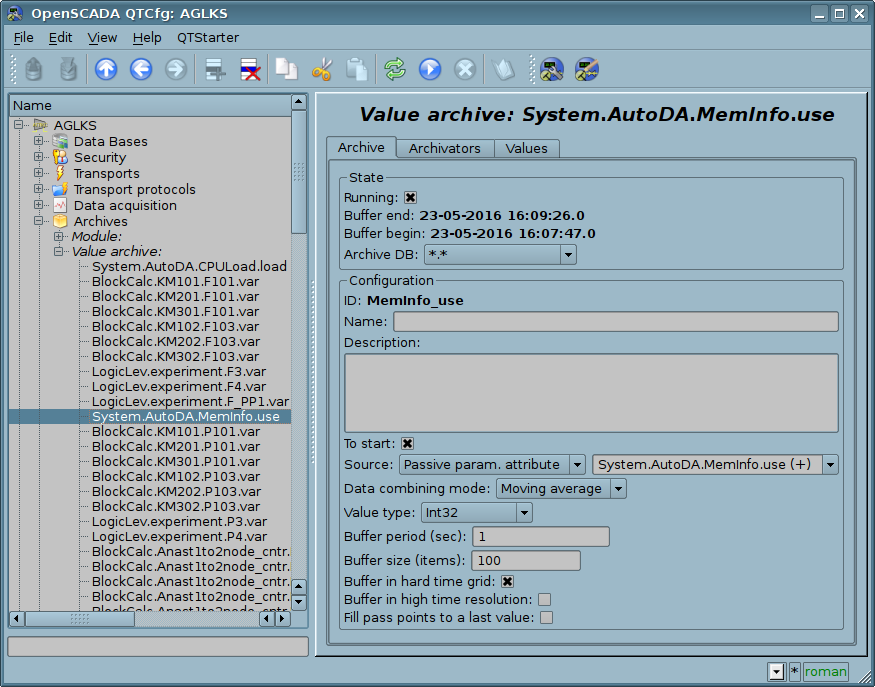
Fig. 4.6e. The main configuration tab of the values' archive of subsystem "Archives".
Tab Archivators' (Fig.4.6f) contains the table with the configuration of the processing of the archive by the available archivers. Lines are available archivers, and the columns are the following parameters:
- Archivator — information on the archiver's address.
- Start — information on the archiver's state "Started".
- Process — sign of the processing this archive be the archiver. The field is available for modification by the user.
- Period (s) — information on the periodicity of the archiver.
- Begin — date and time of the archive beginning in the archiver.
- End — date and time of the archive ending in the archiver.
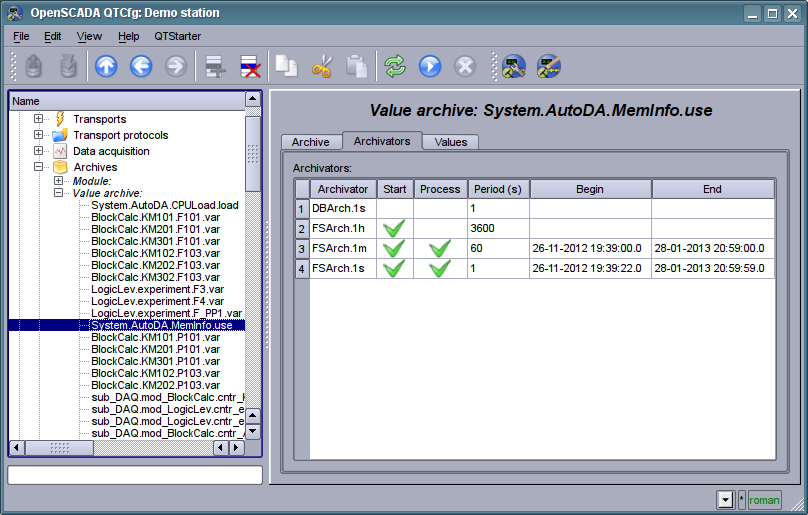
Fig. 4.6f. The "Archivators" tab of the values archive of subsystem "Archives".
Tab "Values" (Fig.4.6g) contains the values request in the archive and the result as a table of values or image of the trend. Values request contains the fields:
- Time — indicates the time of request. It contains two fields: the field of date + time and microseconds.
- Size (s) — specifies the size or depth of the request in seconds.
- Archivator — indicates values archiver for which the request is to be processed. If the value is missing, the request will be processed for the buffer and for all archivers. If the <buffer> is specified, then the request will be processed only for the archive's buffer.
- Show trend — indicates the necessity for presentation of the archive's data in the form of a graph (trend), otherwise the result is presented in a table that contains only time and value. In the case of installation of this field the schedule is formed and displayed, in addition additional configuration fields of the image settings are appeared:
- Picture size — indicates the width and height of the generated image in pixels.
- Value scale — indicates the lower and upper limit of the scale of value. If both values are set to 0 or equal, then the scale will be determined automatically depending on the values.
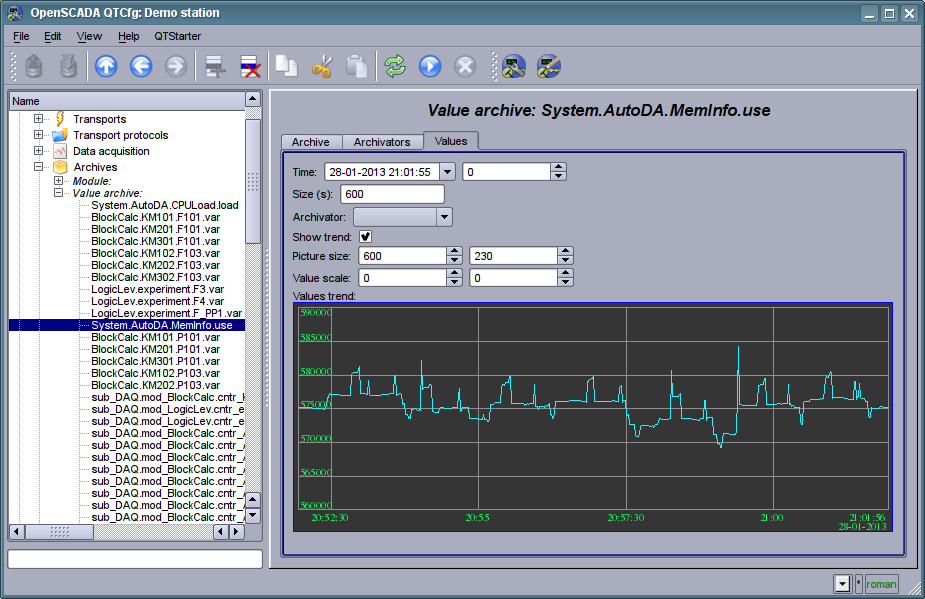
Fig. 4.6g. The "Values" tab of the values archive of subsystem "Archives".
Each module of the "Archives" subsystem provides configuration page with the tabs "Archivators" and "Module". The "Archivators" tab (Fig.4.6h) contains a list of messages and values archivers registered in the module. The context menu of the list provides user with possibility to add, delete and move to the desired controller. The "Module" tab contains information about the module of subsystem "Archives" (Fig. 4.1d), whose structure is identical for all modules.
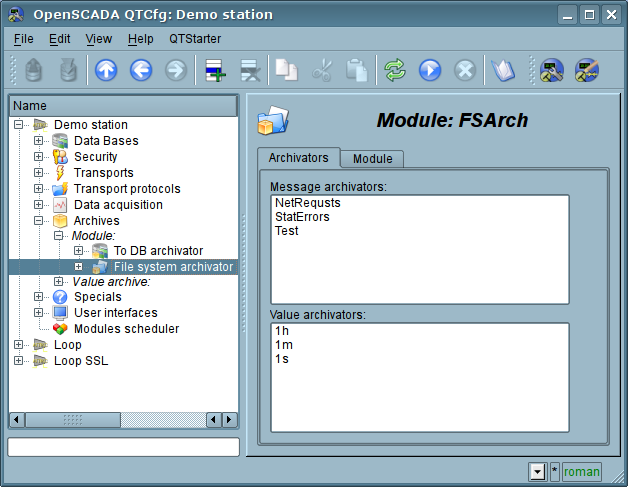
Fig. 4.6h. The "Archivators" tab of the module of subsystem "Archives".
Messages archivators contains their own configuration page with tabs "Archivator" and "Messages".
The "Archivator" tab (Fig.4.6i) contains the basic settings. The structure of these settings may differ slightly from one module of this subsystem to another as you can find in the own documentation of modules. As an example we shall examine the settings of the messages archiver from the module of the archive on the file system Arch.FSArch Settings:
- Section "State" — contains the properties, hich characterize the archivers' state:
- Running — archivers' state "Running". The running archiver processes the messages archive buffer and puts his data in its repository, but also it processes requests for access to data in the repository.
- Archivator DB — database address for storing the archiver's data.
- End — date + time of the last data in the archiver's repository.
- Begin — date + time of the first data in the archiver's repository.
- Archivator files size (kB) — information about the total size of the archiver's files with the data.
- Archiving time (ms) — time spent on the archiving of messages archive data.
- Section "Config" — directly contains the configuration fields:
- ID — information on the archiver's identifier.
- Name — indicates the archiver's name.
- Description — brief description of the archiver and its purpose.
- To start — indicates the status "Running", in which to transfer archiver at startup.
- Message categories — list of categories of messages, separated by ';'. Messages matched with the templates or regular expressions of categories will be processed by the archiver. In the category you can specify the elements of a sample of the template, namely, the characters '*' — for any string and '?' — for any character, as well as a regular expression enclosed between '/' (/mod_ (System|LogicLev)/).
- Message level — indicates the level of archiver's messages. Messages with a level greater than or equal to the specified one are processed by the archiver.
- Address — address of the storage in the specific for the type of archiver (module) format. Format description usually available in the tooltip for this field. In the example it is the relative path to the storage directory.
- Section "Additional options" — specialized section for module about the contents of which you can read in the documentation on the module.
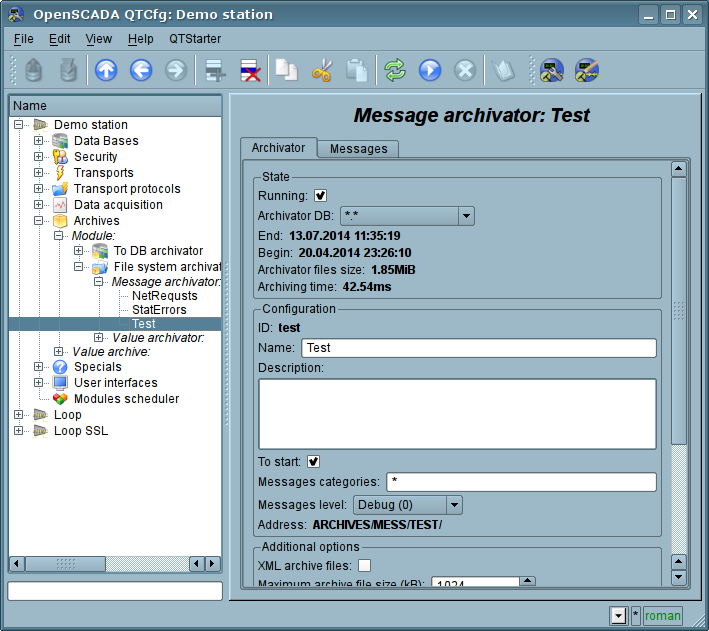
Fig. 4.6i. The main tab of the messages archiver configuration of subsystem "Archives".
The "Messages" tab (Fig.4.6j) contains the form of the messages request from the archive of the archiver:
- Time, size (s) and level — specifies the request time, the size or the depth (in seconds) and the minimum level of messages (more than or equal).
- Category pattern — indicates the category of the requested messages. In the category you can specify the elements of a sample of the template, namely, the characters '*' — for any string and '?' — for any character, as well as a regular expression enclosed between '/' (/mod_ (System|LogicLev)/).
The result table contains messages rows with the following columns:
- Time — message time.
- Category — message category.
- Level — message level.
- Message — message text.
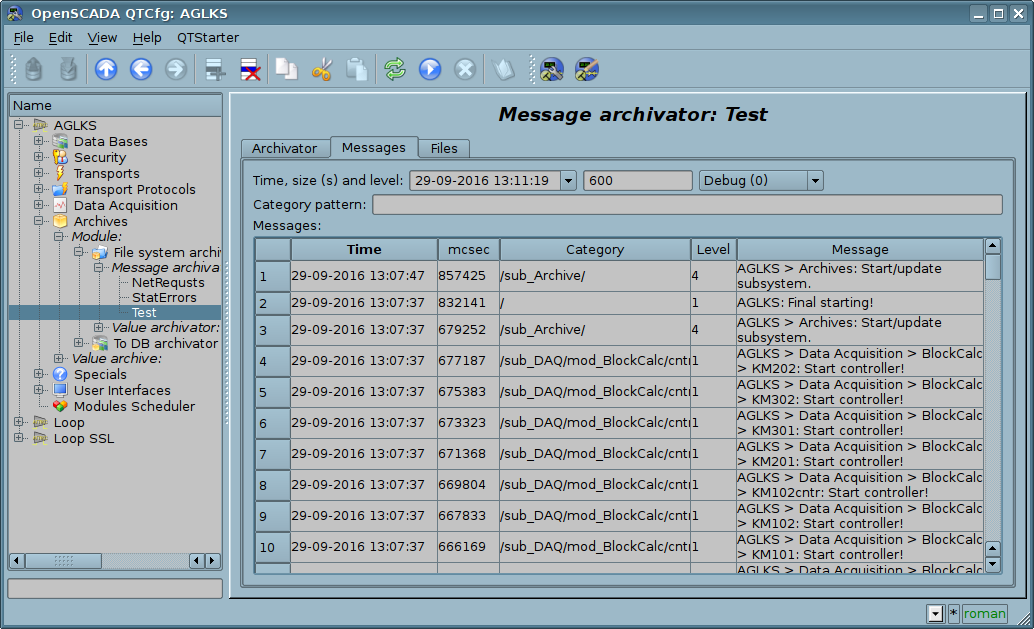
Fig. 4.6j. Tab of the messages request "Messages" of the messages archiver of subsystem "Archives".
Values archivers contains their own configuration page with tabs "Archivator" and "Archives".
The "Archivator" tab (Fig.4.6k) contains the basic settings. The structure of these settings may differ slightly from one module of this subsystem to another as you can find in the own documentation of modules. As an example we shall examine the settings of the messages archiver from the module of the archive on the file system Arch.FSArch Settings:
- Section "State" — contains the properties, hich characterize the archivers' state:
- Running — archivers' state "Running". The running archiver processes the messages archive buffer and puts his data in its repository, but also it processes requests for access to data in the repository.çàïðîñû íà äîñòóï ê äàííûì â õðàíèëèùå.
- Archiving time (ms) — information about the time spent on archiving data of the archives buffers. Periodicity of archiving is set in the field "Period archiving" in the section "Config" of the tab.
- Archivator DB — database address for storing the archiver's data.
- Section "Config" — directly contains the configuration fields:
- ID — information on the archiver's identifier.
- Name — indicates the archiver's name.
- Description — brief description of the archiver and its purpose.
- To start — indicates the status "Running", in which to transfer archiver at startup.
- Address — address of the storage in the specific for the type of archiver (module) format. Format description usually available in the tooltip for this field. In the example it is the relative path to the storage directory.
- Value period (s) — indicates the periodicity of values that are contained in the archiver's repository.
- Period archiving (s) — indicates the periodicity of the archives buffers data archiving task. The dimension of the archives buffers in the time expression must not be less, and preferably somewhat greater then the periodicity of the of archiving task. Set zero period for disable using the archiver for buffer processing, only for direct write.
- Selection priority — selection the archiver priority for "All" sources using mode. Set to zero for full the selection disable.
- Section "Additional options" — specialized section for module about the contents of which you can read in the documentation on the module.
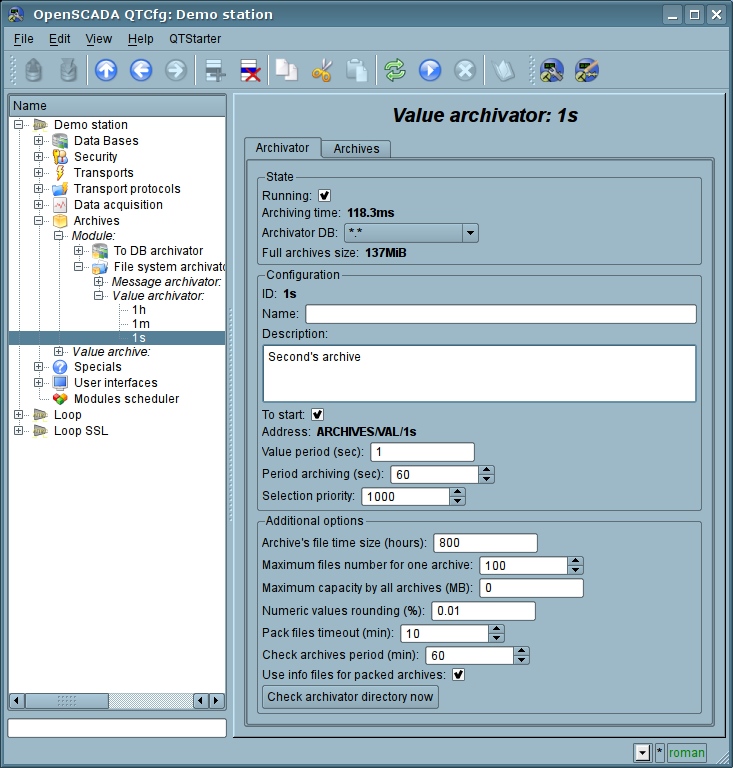
Fig. 4.6k. The main tab of the values archiver configuration of subsystem "Archives".
The "Archives" tab (Fig.4.6l) contains a table with information about the archives being processed by the archiver. In the rows the table contains archives, and in the columns — the following information:
- Archive — archive's name.
- Period (s) — archive's periodicity in seconds.
- Buffer size — buffer's dimension in units.
- Files size (Mb) — specific to the module Arch.FSArch field with information about the total size of the files of the archiver's storage for the archive.
In the case of the module Arch.FSArch in this tab you can find the form of export the archiver's data.
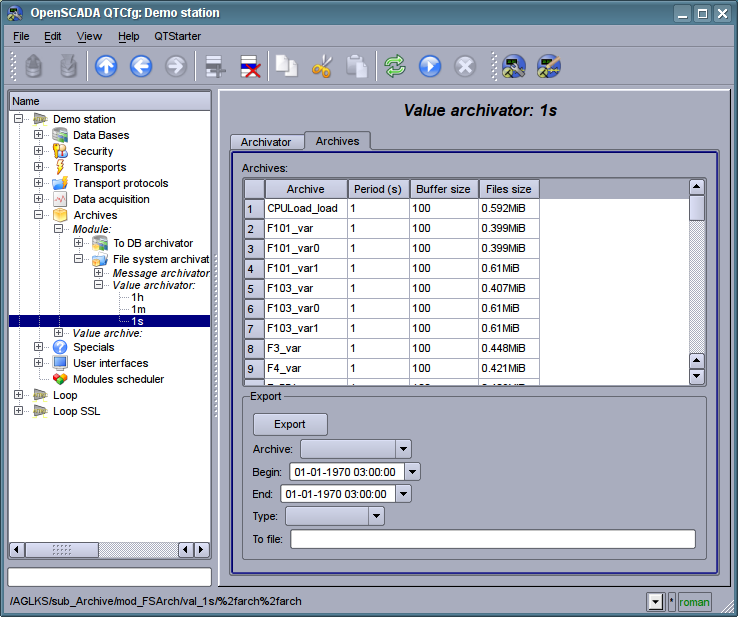
Fig. 4.6l. The "Archives" tab of the values archiver of subsystem "Archives".
4.7. Subsystem "User interfaces"
The subsystem is modular. To configure the subsystem the root page of the subsystem "User Interfaces" is provided, it contains the tab "Modules". The "Modules" tab (Fig. 4.1b) contains a list of modules of subsystem and it is identical for all modular subsystems.
Each module of the subsystem "User Interfaces" provides configuration page with the tabs "User Interface" and "Module". The "User Interface" tab (Fig.4.7a) provides the parameter for monitoring the "Running" status of the module, as well as the configuration sections specialized for the modules of this subsystem. On the "Module" tab there is an information about the module of the subsystem "User Interfaces" (Fig. 4.1d), which structure is identical for all modules.
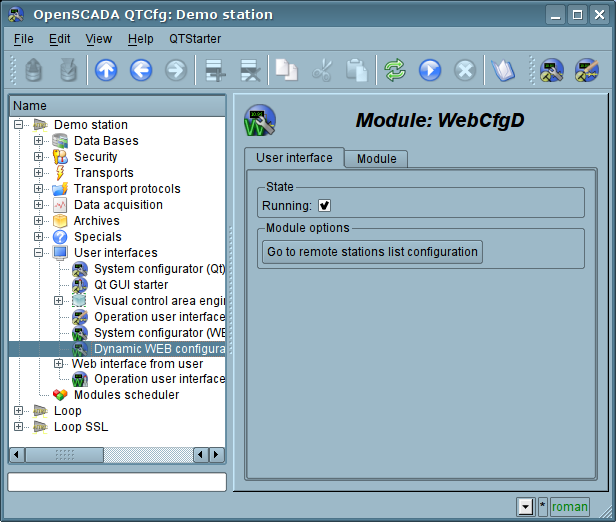
Fig. 4.7a. The "User Interface" tab of the module of subsystem "User Interfaces".
4.8. Subsystem "Specials"
The subsystem is modular. To configure the subsystem the root page of the subsystem "User Interfaces" is provided, it contains the tab "Modules". The "Modules" tab (Fig. 4.1b) contains a list of modules of subsystem and it is identical for all modular subsystems.
Each module of the subsystem "Specials" provides configuration page with the tabs "Special" and "Module". The "Special" tab (Fig.4.8a) provides the parameter for monitoring the "Running" status of the module, as well as the configuration sections specialized for the modules of this subsystem. On the "Module" tab there is an information about the module of the subsystem "Specials" (Fig. 4.1d), which structure is identical for all modules.
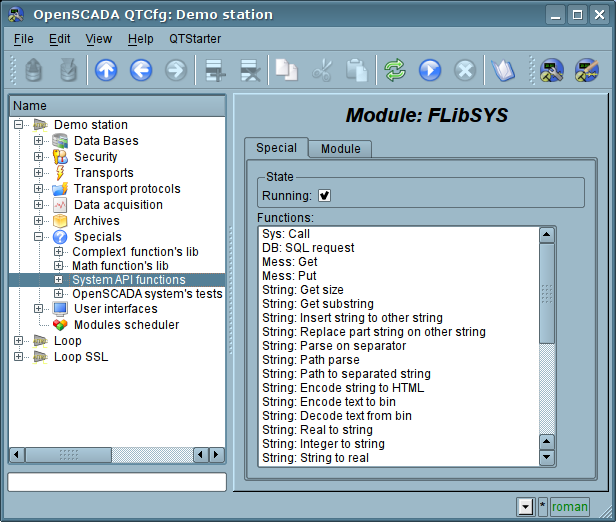
Fig. 4.8a. The "Special" tab of the module of subsystems "Specials".
4.9. Subsystem "Modules scheduler"
The subsystem is not modular. To configure the subsystem the subsystem's page "Modules scheduler" is provided, it contains tab "Subsystem". The "Subsystem" tab (Fig.4.9a) contains the basic settings of the subsystem. The structure of the tab "Subsystem":
- Path to shared libs (modules) — information about the location of the directory with the modules of the OpenSCADA system. It is set by the parameter <ModDir> of the station, of the configuration file.
- Denied modules — the list, separated by ';' of modules that are denied for automatically connection and updating. It is set by the parameter <ModDeny> of the section of subsystem "sub_ModSched" of station of configuration file. List of denied modules has higher priority than allowed.
- Allowed modules — the list, separated by ',', of modules that are authorized for automatic connection and renewal. The value of '*' is used to resolve all the modules. It is set by the parameter <ModAllow> of the section of subsystem, sub_ModSched, of the station of the configuration file.
- Check modules period (sec) — indicates the periodicity of testing modules on the fact of their updating. Modules that are allowed for automatically connection and updating will be automatically updated.
- Check modules now — command to check the modules on the fact of their updating. Modules that are allowed for automatically connection and updating will be automatically updated.
- Shared libs (modules) — table with the list of shared libraries with the modules detected by OpenSCADA. Rows are modules, and in the columns there is an information about them:
- Path — information on the full path to the shared library.
- Time — information about the time the of last modification of a shared library.
- Modules — information about the list of modules in a shared library.
- Enable — state "Enable" of the shared library. Privileged users are provided with an opportunity to manually enable/disable the shared libraries by changing this field.
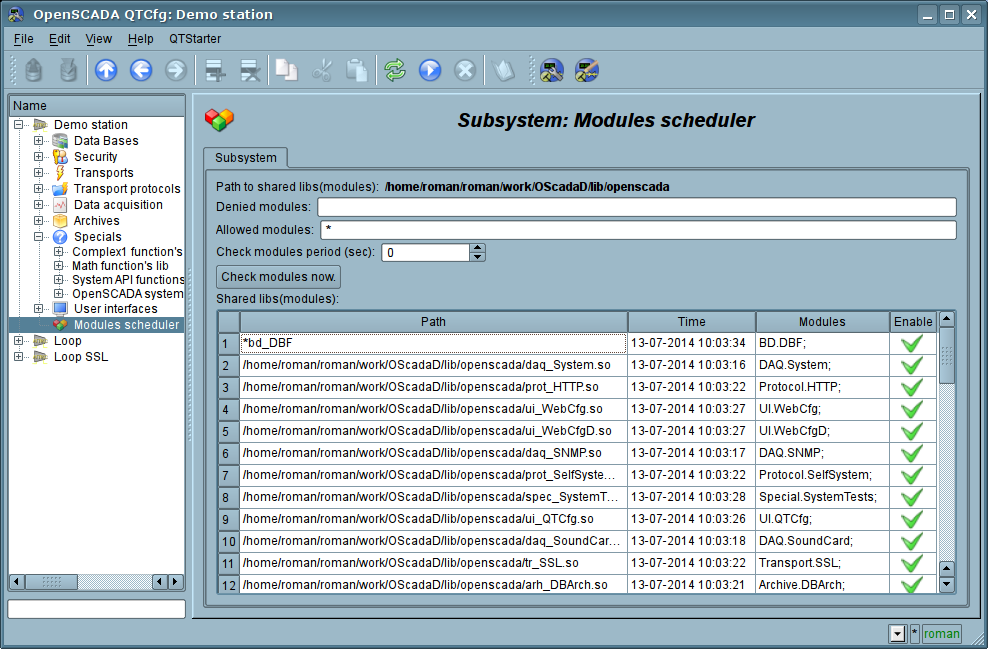
Fig. 4.9a. The main configuration tab of subsystem "Modules scheduler".
4.10. Configuration file of the OpenSCADA and parameters of command-line OpenSCADA execution.
Configuration file of the OpenSCADA system is provided to store the system and general configuration of OpenSCADA-station. Only in the configuration file and through the command-line options you can specify the part of the key system parameters of the station, so familiarity with the structure of the configuration file is necessary for professionals who make solutions based on OpenSCADA.
The configuration file of the OpenSCADA system can be called somehow, but the oscada.xml name and derived from it are accepted. The configuration file is usually indicated when you start the station by the command-line option "--config=/home/roman/roman/work/OScadaD/etc/oscada_demo.xml". For the convenience of the calling the startup scripts of the station are created with the correct configuration file or used the project manager at start script openscada_start. For example script (openscada_demo) uses for the demo station execution:
#!/bin/sh
openscada --config=/etc/oscada_demo.xml $@
If the configuration file is not specified then the standard configuration file: /etc/oscada.xml is used.
Structure of the configuration file based on the extensible markup language XML. Therefore the strict adherence to the rules of XML syntax is required. An example of the configuration file of the OpenSCADA, with configuration nodes of most of the OpenASCADA components, is given below:
<?xml version="1.0" encoding="UTF-8" ?> <OpenSCADA> <!-- This is the OpenSCADA configuration file. --> <station id="AGLKS"> <!-- Describe internal parameters for station. The station is OpenSCADA program. --> <prm id="StName">AGLKS</prm> <prm id="StName_ru">ÀÃËÊÑ</prm> <prm id="StName_uk">ÀÃËÊÑ</prm> <prm id="WorkDB">SQLite.GenDB</prm> <prm id="LogTarget">10</prm> <prm id="Lang2CodeBase">en</prm> <prm id="SaveAtExit">0</prm> <prm id="SavePeriod">0</prm> <node id="sub_BD"> <prm id="SYSStPref">0</prm> <tbl id="DB"> <fld ID="GenDB" TYPE="SQLite" NAME="Generic DB" NAME_ru="Îñíîâíàÿ ÁÄ" NAME_uk="Îñíîâíà ÁÄ" ADDR="St.db" CODEPAGE="UTF-8"/> </tbl> </node> <node id="sub_Security"> <!-- <tbl id="Security_user"> <fld NAME="root" DESCR="Super user" DESCR_ru="Ñóïåð ïîëüçîâàòåëü" DESCR_uk="Ñóïåð êîðèñòóâà÷" PASS="openscada"/> <fld NAME="user" DESCR="System user" DESCR_ru="Ñèñòåìíûé ïîëüçîâàòåëü" DESCR_uk="Ñèñòåìíèé êîðèñòóâà÷" PASS=""/> </tbl> <tbl id="Security_grp"> <fld NAME="root" DESCR="Super users groups" DESCR_ru="Ãðóïïà ñóïåðïîëüçîâàòåëåé" DESCR_uk="Ãðóïà ñóïåðêîðèñòóâà÷³â" USERS="root;user"/> </tbl>--> </node> <node id="sub_ModSched"> <prm id="ModAllow">*</prm> <prm id="ModDeny"></prm> <prm id="ChkPer">0</prm> </node> <node id="sub_Transport"> <!-- <tbl id="Transport_in"> <fld ID="WEB_1" MODULE="Sockets" NAME="Generic WEB interface" NAME_ru="Îñíîâíîé WEB èíòåðôåéñ" NAME_uk="Îñíîâíèé WEB ³íòåðôåéñ" DESCRIPT="Generic transport for WEB interface." DESCRIPT_ru="Îñíîâíîé òðàíñïîðò äëÿ WEB èíòåðôåéñà." DESCRIPT_uk="Îñíîâíèé òðàíñïîðò äëÿ WEB ³íòåðôåéñó." ADDR="TCP::10002:0" PROT="HTTP" START="1"/> <fld ID="WEB_2" MODULE="Sockets" NAME="Reserve WEB interface" NAME_ru="Ðåçåðâíûé WEB èíòåðôåéñ" NAME_uk="Ðåçåðâíèé WEB ³íòåðôåéñ" DESCRIPT="Reserve transport for WEB interface." DESCRIPT_ru="Ðåçåðâíûé òðàíñïîðò äëÿ WEB èíòåðôåéñà." DESCRIPT_uk="Ðåçåðâíèé òðàíñïîðò äëÿ WEB ³íòåðôåéñó." ADDR="TCP::10004:0" PROT="HTTP" START="1"/> </tbl> <tbl id="Transport_out"> <fld ID="testModBus" MODULE="Sockets" NAME="Test ModBus" NAME_ru="Òåñò ModBus" NAME_uk="Òåñò ModBus" DESCRIPT="Data exchange by protocol ModBus test." DESCRIPT_ru="Òåñò îáìåíà ïî ïðîòîêîëó ModBus." DESCRIPT_uk="Òåñò îáì³íó çà ïðîòîêîëîì ModBus." ADDR="TCP:localhost:10502" START="1"/> </tbl>--> </node> <node id="sub_DAQ"> <!-- <tbl id="tmplib"> <fld ID="test2" NAME="Test 2" NAME_ru="Òåñò 2" NAME_uk="Òåñò 2" DESCR="" DESCR_ru="" DESCR_uk="" DB="tmplib_test2"/> </tbl> <tbl id="tmplib_test2"> <fld ID="test2" NAME="Test 2" NAME_ru="Òåñò 2" NAME_uk="Òåñò 2" DESCR="" DESCR_ru="" DESCR_uk="" PROGRAM="JavaLikeCalc.JavaScript
cnt=5*i;"/> </tbl> <tbl id="tmplib_test2_io"> <fld TMPL_ID="test2" ID="i" NAME="I" NAME_ru="I" NAME_uk="I" TYPE="4" FLAGS="160" VALUE="" POS="0"/> <fld TMPL_ID="test2" ID="cnt" NAME="Cnt" NAME_ru="Cnt" NAME_uk="Cnt" TYPE="4" FLAGS="32" VALUE="" POS="0"/> </tbl>--> <node id="mod_LogicLev"> <!-- <tbl id="DAQ"> <fld ID="test2" NAME="Test 2" NAME_ru="Òåñò 2" NAME_uk="Òåñò 2" DESCR="" DESCR_ru="" DESCR_uk="" ENABLE="1" START="1" PRM_BD="test2prm" PERIOD="1000" PRIOR="0"/> </tbl> <tbl id="test2prm"> <fld SHIFR="test2" NAME="Test 2" NAME_ru="Òåñò 2" NAME_uk="Òåñò 2" DESCR="" DESCR_ru="" DESCR_uk="" EN="1" MODE="2" PRM="test2.test2"/> </tbl>--> </node> <node id="mod_System"> <!-- <tbl id="DAQ"> <fld ID="DataOS" NAME="Data OS" NAME_ru="Äàíûå ÎÑ" NAME_uk="Äàí³ ÎÑ" DESCR="Data of services and subsystems OS." DESCR_ru="Äàííûå ñåðâèñîâ è ïîäñèñòåì ÎÑ." DESCR_uk="Äàí³ ñåðâ³ñ³â òà ï³äñèñòåì ÎÑ." ENABLE="1" START="1" AUTO_FILL="0" PRM_BD="DataOSprm" PERIOD="1000" PRIOR="0"/> </tbl> <tbl id="DataOSprm"> <fld SHIFR="CPU" NAME="CPU load" NAME_ru="Íàãðóçêà CPU" NAME_uk="Íàâàíòàæåííÿ CPU" DESCR="" DESCR_ru="" DESCR_uk="" EN="1" TYPE="CPU" SUBT="gen"/> <fld SHIFR="MEM" NAME="Memory" NAME_ru="Ïàìÿòü" NAME_uk="Ïàì\'ÿòü" DESCR="" DESCR_ru="" DESCR_uk="" EN="1" TYPE="MEM"/> </tbl> --> </node> <node id="mod_DiamondBoards"> <!-- <tbl id="DAQ"> <fld ID="Athena" NAME="Athena board" NAME_ru="Ïëàòà Athena" NAME_uk="Ïëàòà Athena" DESCR="" DESCR_ru="" DESCR_uk="" ENABLE="1" START="0" BOARD="25" PRM_BD_A="AthenaAnPrm" PRM_BD_D="AthenaDigPrm" ADDR="640" INT="5" DIO_CFG="0" ADMODE="0" ADRANGE="0" ADPOLAR="0" ADGAIN="0" ADCONVRATE="1000"/> </tbl> <tbl id="AthenaAnPrm"> <fld SHIFR="ai0" NAME="AI 0" NAME_ru="AI 0" NAME_uk="AI 0" DESCR="" DESCR_ru="" DESCR_uk="" EN="0" TYPE="0" CNL="0" GAIN="0"/> </tbl> <tbl id="AthenaDigPrm"> <fld SHIFR="di0" NAME="DI 0" NAME_ru="DI 0" NAME_uk="DI 0" DESCR="" DESCR_ru="" DESCR_uk="" EN="0" TYPE="0" PORT="0" CNL="0"/> </tbl> --> </node> <node id="mod_BlockCalc"> <!-- <tbl id="DAQ"> <fld ID="Model" NAME="Model" NAME_ru="Ìîäåëü" NAME_uk="Ìîäåëü" DESCR="" DESCR_ru="" DESCR_uk="" ENABLE="1" START="1" PRM_BD="Model_prm" BLOCK_SH="Model_blcks" PERIOD="1000" PRIOR="0" PER_DB="0" ITER="1"/> </tbl> <tbl id="Model_blcks"> <fld ID="Klap" NAME="Klapan" NAME_ru="Êëàïàí" NAME_uk="Êëàïàí" DESCR="" DESCR_ru="" DESCR_uk="" FUNC="DAQ.JavaLikeCalc.lib_techApp.klap" EN="1" PROC="1"/> </tbl> <tbl id="Model_blcks_io"> <fld BLK_ID="Klap" ID="l_kl1" TLNK="0" LNK="" VAL="50"/> <fld BLK_ID="Klap" ID="l_kl2" TLNK="0" LNK="" VAL="20"/> </tbl> <tbl id="Model_prm"> <fld SHIFR="l_kl" NAME="Klap lev" NAME_ru="Ïîëîæ. êëàïàíà" NAME_uk="Ïîëîæ. êëàïàíà" DESCR="" DESCR_ru="" DESCR_uk="" EN="1" IO="Klap.l_kl1"/> </tbl> --> </node> <node id="mod_JavaLikeCalc"> <!-- <tbl id="DAQ"> <fld ID="CalcTest" NAME="Calc Test" NAME_ru="Òåñò âû÷èñë." NAME_uk="Òåñò îá÷èñë." DESCR="" DESCR_ru="" DESCR_uk="" ENABLE="1" START="1" PRM_BD="CalcTest_prm" FUNC="TemplFunc.d_alarm" SCHEDULE="1" PRIOR="0" ITER="1"/> </tbl> <tbl id="CalcTest_val"> <fld ID="in" VAL="0"/> <fld ID="alrm" VAL=""/> <fld ID="alrm_md" VAL="1"/> <fld ID="alrm_mess" VAL="Error present."/> </tbl> <tbl id="CalcTest_prm"> <fld SHIFR="alrm" NAME="Alarm" NAME_ru="Àâàðèÿ" NAME_uk="Àâàð³ÿ" DESCR="" DESCR_ru="" DESCR_uk="" EN="1" FLD="alrm"/> </tbl> <tbl id="lib"> <fld ID="TemplFunc" NAME="" NAME_ru="" NAME_uk="" DESCR="" ESCR_ru="" DESCR_uk="" DB="lib_TemplFunc"/> </tbl> <tbl id="lib_TemplFunc"> <fld ID="d_alarm" NAME="Digit alarm" NAME_ru="Àâàðèÿ ïî äèñêð." NAME_uk="Àâàð³ÿ çà äèñêð" DESCR="" FORMULA="alrm=(in==alrm_md)?"1:"+alrm_mess:"0";"/> </tbl> <tbl id="lib_TemplFunc_io"> <fld F_ID="d_alarm" ID="in" NAME="Input" NAME_ru="Âõîä" NAME_uk="Âõ³ä" TYPE="3" MODE="0" DEF="" HIDE="0" POS="0"/> <fld F_ID="d_alarm" ID="alrm" NAME="Alarm" NAME_ru="Àâàðèÿ" NAME_uk="Àâàð³ÿ" TYPE="0" MODE="1" DEF="" HIDE="0" POS="1"/> <fld F_ID="d_alarm" ID="alrm_md" NAME="Alarm mode" NAME_ru="Ðåæèì àâàðèè" NAME_uk="Ðåæèì àâàð³¿" TYPE="3" MODE="0" DEF="" HIDE="0" POS="2"/> <fld F_ID="d_alarm" ID="alrm_mess" NAME="Alarm message" NAME_ru="Ñîîáù. àâàðèè" NAME_uk="Ïîâ³ä. àâàð³¿" TYPE="0" MODE="0" DEF="" HIDE="0" POS="3"/> </tbl>--> </node> <node id="mod_Siemens"> <!-- <tbl id="DAQ"> <fld ID="test2" NAME="Test 2" NAME_ru="Òåñò 2" NAME_uk="Òåñò 2" DESCR="" DESCR_ru="" DESCR_uk="" ENABLE="1" START="1" PRM_BD="test2prm" PERIOD="1000" PRIOR="0" CIF_DEV="0" ADDR="5" ASINC_WR="0"/> </tbl> <tbl id="test2prm"> <fld SHIFR="test2" NAME="Test 2" NAME_ru="Òåñò 2" NAME_uk="Òåñò 2" DESCR="" DESCR_ru="" DESCR_uk="" EN="1" TMPL="S7.ai_man"/> </tbl>--> </node> <node id="mod_SNMP"> <!-- <tbl id="DAQ"> <fld ID="test2" NAME="Test 2" NAME_ru="Òåñò 2" NAME_uk="Òåñò 2" DESCR="" DESCR_ru="" DESCR_uk="" ENABLE="1" START="1" PRM_BD="test2prm" PERIOD="1000" PRIOR="0" ADDR="localhost" COMM="public" PATTR_LIM="20"/> </tbl> <tbl id="test2prm"> <fld SHIFR="test2" NAME="Test 2" NAME_ru="Òåñò 2" NAME_uk="Òåñò 2" DESCR="" DESCR_ru="" DESCR_uk="" EN="1" OID_LS="system"/> </tbl>--> </node> <node id="mod_ModBus"> <!-- <tbl id="DAQ"> <fld ID="test2" NAME="Test 2" NAME_ru="Òåñò 2" NAME_uk="Òåñò 2" DESCR="" DESCR_ru="" DESCR_uk="" ENABLE="1" START="1" PRM_BD="test2prm" PERIOD="1000" PRIOR="0" TRANSP="Sockets" ADDR="exlar.diya.org" NODE="1"/> </tbl> <tbl id="test2prm"> <fld SHIFR="test2" NAME="Test 2" NAME_ru="Òåñò 2" NAME_uk="Òåñò 2" DESCR="" DESCR_ru="" DESCR_uk="" EN="1" ATTR_LS="321:0:tst:Test"/> </tbl>--> </node> <node id="mod_DAQGate"> <!-- <tbl id="DAQ"> <fld ID="test2" NAME="Test 2" NAME_ru="Òåñò 2" NAME_uk="Òåñò 2" DESCR="" DESCR_ru="" DESCR_uk="" ENABLE="1" START="1" PRM_BD="test2prm" PERIOD="1000" PRIOR="0" SYNCPER="60" STATIONS="loop" CNTRPRM="System.AutoDA"/> </tbl>--> </node> <node id="mod_DCON"> <!--<tbl id="DAQ"> <fld ID="test2" NAME="Test 2" NAME_ru="Òåñò 2" NAME_uk="Òåñò 2" DESCR="" DESCR_ru="" DESCR_uk="" ENABLE="1" START="1" PRM_BD="test2prm" PERIOD="1" PRIOR="0" ADDR="" REQ_TRY="1"/> </tbl> <tbl id="test2prm"> <fld SHIFR="test2" NAME="Test 2" NAME_ru="Òåñò 2" NAME_uk="Òåñò 2" DESCR="" DESCR_ru="" DESCR_uk="" EN="1" MOD_TP="0" MOD_ADDR="1" CRC_CTRL="1"/> </tbl>--> </node> <node id="mod_ICP_DAS"> <!--<tbl id="DAQ"> <fld ID="test2" NAME="Test 2" NAME_ru="Òåñò 2" NAME_uk="Òåñò 2" DESCR="" DESCR_ru="" DESCR_uk="" ENABLE="1" START="1" PRM_BD="test2prm" PERIOD="1" PRIOR="0" BUS="1" BAUD="115200" LP_PRMS="" REQ_TRY="3"/> </tbl> <tbl id="test2prm"> <fld SHIFR="test2" NAME="Test 2" NAME_ru="Òåñò 2" NAME_uk="Òåñò 2" DESCR="" DESCR_ru="" DESCR_uk="" EN="1" MOD_TP="552985" MOD_ADDR="0" MOD_SLOT="1" MOD_PRMS="0"/> </tbl>--> </node> <node id="mod_OPC_UA"> <!--<tbl id="DAQ"> <fld ID="test2" NAME="Test 2" NAME_ru="Òåñò 2" NAME_uk="Òåñò 2" DESCR="" DESCR_ru="" DESCR_uk="" ENABLE="1" START="1" PRM_BD="test2prm" SCHEDULE="1" PRIOR="0" SYNCPER="60" ADDR="" EndPoint="opc.tcp://localhost:4841" SecPolicy="None" SecMessMode="1" Cert="" PvKey="" AttrsLimit="100"/> </tbl> <tbl id="test2prm"> <fld SHIFR="test2" NAME="Test 2" NAME_ru="Òåñò 2" NAME_uk="Òåñò 2" DESCR="" DESCR_ru="" DESCR_uk="" EN="1" ND_LS=""/> </tbl>--> </node> <node id="mod_SoundCard"> <!--<tbl id="DAQ"> <fld ID="test2" NAME="Test 2" NAME_ru="Òåñò 2" NAME_uk="Òåñò 2" DESCR="" DESCR_ru="" DESCR_uk="" ENABLE="1" START="1" PRM_BD="test2prm" CARD="" SMPL_RATE="8000" SMPL_TYPE="1"/> </tbl> <tbl id="test2prm"> <fld SHIFR="test2" NAME="Test 2" NAME_ru="Òåñò 2" NAME_uk="Òåñò 2" DESCR="" DESCR_ru="" DESCR_uk="" EN="1" CHANNEL="0"/> </tbl>--> </node> </node> <node id="sub_Archive"> <prm id="MessBufSize">1000</prm> <prm id="MessPeriod">5</prm> <prm id="ValPeriod">1000</prm> <prm id="ValPriority">10</prm> <!-- <tbl id="Archive_mess_proc"> <fld ID="StatErrors" MODUL="FSArch" NAME="Errors" NAME_ru="Îøèáêè" NAME_uk="Ïîìèëêè" DESCR="Local errors\' archive" DESCR_ru="Àðõèâ ëîêàëüíûõ îùèáîê" DESCR_uk="Àðõ³â ëîêàëüíèõ ïîìèëîê" START="1" CATEG="/DemoStation*" LEVEL="4" ADDR="ARCHIVES/MESS/stError/"/> <fld ID="NetRequsts" MODUL="FSArch" NAME="Net requests" NAME_ru="Ñåòåâûå çàïðîñû" NAME_uk="Ìåðåæåâ³ çàïèòè" DESCR="Requests to server through transport Sockets." DESCR_ru="Çàïðîñû ê ñåðâåðó ÷åðåç òðàíñïîðò Sockets." DESCR_uk="Çàïèòè äî ñåðâåðà ÷åðåç òðàíñïîðò Sockets." START="1" CATEG="/DemoStation/Transport/Sockets*" LEVEL="1" ADDR="ARCHIVES/MESS/Net/"/> </tbl> <tbl id="Archive_val_proc"> <fld ID="1h" MODUL="FSArch" NAME="1hour" NAME_ru="1÷àñ" NAME_uk="1ãîä" DESCR="Averaging for hour" DESCR_ru="Óñðåäíåíèå çà ÷àñ" DESCR_uk="Óñåðåäíåííÿ çà ãîäèíó" START="1" ADDR="ARCHIVES/VAL/1h/" V_PER="360" A_PER="60"/> </tbl> <tbl id="Archive_val"> <fld ID="test1" NAME="Test 1" NAME_ru="Òåñò 1" NAME_uk="Òåñò 1" DESCR="Test 1" DESCR_ru="Òåñò 1" DESCR_uk="Òåñò 1" START="1" VTYPE="1" BPER="1" BSIZE="200" BHGRD="1" BHRES="0" SrcMode="0" Source="" ArchS=""/> </tbl>--> </node> <node id="sub_Protocol"> </node> <node id="sub_UI"> <node id="mod_QTStarter"> <prm id="StartMod">QTCfg</prm> </node> <node id="mod_WebCfg"> <prm id="SessTimeLife">20</prm> </node> <node id="mod_VCAEngine"> <!-- <tbl id="LIB"> <fld ID="test2" NAME="Test 2" NAME_ru="Òåñò 2" NAME_uk="Òåñò 2" DESCR="" DESCR_ru="" DESCR_uk="" DB_TBL="wlib_test2" ICO="" USER="root" GRP="UI" PERMIT="436"/> </tbl> <tbl id="wlib_test2"> <fld ID="test2" ICO="" PARENT="/wlb_originals/wdg_Box" PROC="" PROC_ru="" PROC_uk="" PROC_PER="-1" USER="root" GRP="UI" PERMIT="436"/> </tbl> <tbl id="wlib_test2_io"> <fld IDW="test2" ID="name" IO_VAL="Test 2" IO_VAL_ru="Òåñò 2" IO_VAL_uk="Òåñò 2" SELF_FLG="" CFG_TMPL="" CFG_TMPL_ru="" CFG_TMPL_uk="" CFG_VAL=""/> <fld IDW="test2" ID="dscr" IO_VAL="Test module 2" IO_VAL_ru="Òåñò ìîäóëÿ 2" IO_VAL_uk="Òåñò ìîäóëÿ 2" SELF_FLG="" CFG_TMPL="" CFG_TMPL_ru="" CFG_TMPL_uk="" CFG_VAL=""/> </tbl> <tbl id="PRJ"> <fld ID="test2" NAME="Test 2" NAME_ru="Òåñò 2" NAME_uk="Òåñò 2" DESCR="" DESCR_ru="" DESCR_uk="" DB_TBL="prj_test2" ICO="" USER="root" GRP="UI" PERMIT="436"/> </tbl> <tbl id="prj_test2"> <fld OWNER="/test2" ID="pg1" ICO="" PARENT="/wlb_originals/wdg_Box" PROC="" PROC_ru="" PROC_uk="" PROC_PER="-1" USER="root" GRP="UI" PERMIT="436" FLGS="1"/> <fld OWNER="/test2/pg1" ID="pg2" ICO="" PARENT="/wlb_originals/wdg_Box" PROC="" PROC_ru="" PROC_uk="" PROC_PER="-1" USER="root" GRP="UI" PERMIT="436" FLGS="0"/> </tbl> <tbl id="prj_test2_incl"> <fld IDW="/prj_test2/pg_pg1" ID="wdg1" PARENT="/wlb_originals/wdg_Box"/> </tbl>--> </node> </node> <node id="sub_Special"> <node id="mod_SystemTests"> <prm id="Param" on="0" per="5" name="LogicLev.experiment.F3"/> <prm id="XML" on="0" per="10" file="/etc/oscada.xml"/> <prm id="Mess" on="0" per="10" categ="" arhtor="DBArch.test3" depth="10"/> <prm id="SOAttach" on="0" per="20" name="../../lib/openscada/daq_LogicLev.so" mode="0" full="1"/> <prm id="Val" on="0" per="1" name="LogicLev.experiment.F3.var" arch_len="5" arch_per="1000000"/> <prm id="Val" on="0" per="1" name="System.AutoDA.CPULoad.load" arch_len="10" arch_per="1000000"/> <prm id="DB" on="0" per="10" type="MySQL" addr="server.diya.org;roman;123456;oscadaTest" table="test" size="1000"/> <prm id="DB" on="0" per="10" type="DBF" addr="./DATA/DBF" table="test.dbf" size="1000"/> <prm id="DB" on="0" per="10" type="SQLite" addr="./DATA/test.db" table="test" size="1000"/> <prm id="DB" on="0" per="10" type="FireBird" addr="server.diya.org:/var/tmp/test.fdb;roman;123456" table="test" size="1000"/> <prm id="TrOut" on="0" per="1" addr="TCP:127.0.0.1:10001" type="Sockets" req="time"/> <prm id="TrOut" on="0" per="1" addr="UDP:127.0.0.1:10001" type="Sockets" req="time"/> <prm id="TrOut" on="0" per="1" addr="UNIX:./oscada" type="Sockets" req="time"/> <prm id="TrOut" on="0" per="1" addr="UDP:127.0.0.1:daytime" type="Sockets" req="time"/> <prm id="SysContrLang" on="0" per="10" path="/Archive/FSArch/mess_StatErrors/%2fprm%2fst"/> <prm id="ValBuf" on="0" per="5"/> <prm id="Archive" on="0" per="30" arch="test1" period="1000000"/> <prm id="Base64Code" on="0" per="10"/> </node> </node> </station> </OpenSCADA>
Lets examine in details the structure of the configuration file. A configuration file can contain a configuration of several stations in the sections <station id="AGLKS"/>. To attribute set the identifier of the station. Using one or another section of the station at startup is specified by the command-line option --station=AGLKS. Section of the station directly contains parameters of the station and subsystems' sections. Configuration options of the section are written in the form <prm id="StName">AGLKS</prm>. Where in the attribute <id> the ID of the attribute is specified, and in the tag's body the value of parameter "AGLKS" is specified. The list of available options and their description for the station and all other sections can be obtained from the console by calling OpenSCADA with parameter --help.
Sections of subsystem (<node id="sub_DAQ" />) contains parameters of subsystem, sections of modules and sections of tables of reflections of the data of databases in the configuration file. Sections of modules (<node id="mod_DiamondBoards" />) contain the individual parameters of modules and sections of tables of reflection of the data of databases in the configuration file.
Sections of the tables of reflection of the data of databases are provided for placement in the configuration file records of DB tables for the OpenSCADA components. Lets examine the table of incoming transports "Transport_in" of subsystem transports (<node id="sub_Transport">) from the example of configuration file above. The table contains two records with fields: ID, MODULE, NAME, DESCRIPT, ADDR, PROT, START. After booting with this section and in general without the DB in the subsystem "Transports" of the "Sockets" module you'll see two input transports. Formats of the table's structures of the main components are included in the demo configuration files. For the details of the database's structure you should read the relevant documentation of modules or simple save the object into the configuration file.
The result of the command: # ./openscada_AGLKS --help
5. System-wide API of user programming
User programming API is the tree of OpenSCADA objects, every object of which can provide own list of properties and functions. Properties and functions of objects can be used by the user in procedures on the languages of user programming of OpenSCADA. The entry point for access to the objects of system OpenSCADA from user programming language JavaLikeCalc is the reserved word "SYS" of the root OpenSCADA object. For example, to access the function of outgoing transport you should write: SYS.Transport.Serial.out_ModBus.messIO(mess);.
API of the objects provided by the modules is described in the own documentation of the module.
5.1. System-wide user objects
Abstract object is an associative container of properties and functions. Properties can contain the data of four basic types and other objects. Access to the properties of an object is usually made by recording the names of properties through a point to the object "obj.prop", as well as by entering the property name in brackets "obj["prop"]". It is obvious that the first mechanism is static, while the second lets you to specify the name of the property through a variable. The basic definition of the object does not contain functions. Copying of an object actually makes reference to the original object. When you delete an object the reduce of the reference counter is made, and when the reference counter is equal to the zero object is removed physically.
Different components can redefine the basic object with special properties and functions. The standard extension of the object is an array "Array".
Array object
Peculiarity of the array is that it works with the properties like with the indexes, and complete their naming if senseless, and hence the mechanism of addressing is available only by the conclusion of the index in square brackets "arr[1]". Array stores the properties in its own container of one-dimensional array. Digital properties of the array are used to access directly to the array, and the characters work as object properties.
Array provides the special property "length" to get the array size "var = arr.length;". Also array provides the following functions:
- string join( string sep = "," ), string toString( string sep = "," ), string valueOf( string sep = "," ) — Returns the string with the array elements separated by sep or the character ','.
- Array concat( Array arr ); — Adds to the initial array the elements of the arr array. Returns the initial array with changes.
- int push( ElTp var, ... ); — Places the element(s) var to the end of the array, as to the stack. Returns the new array size.
- ElTp pop( ); — Deleting of the last element of the array and return of its value, as from the stack.
- Array reverse( ); — Changing the order of the elements of the array. Returns the initial array with changes.
- ElTp shift( ); — The shift of the array to the top. The first element is removed and its value is returned.
- int unshift( ElTp var, ... ); — Shift element(s) var to the array. The first element to the 0, second to the 1 and so on.
- Array slice( int beg, int end ); — Returns an array fragment from beg to end (exclude). If the value of beginning or end is negative, then the count is made from the end of the array. If the end is not specified, then the end is the end of the array.
- Array splice( int beg, int remN, ElTp val1, ElTp val2, ... ); — Inserts, deletes or replaces the elements of the array. Returns the removed elements array. Firstly it is made the removing of elements from the position beg and in the quantity of remN, and then the values val1 are inserted and so on, beginning from the position beg.
- Array sort( ); — Sort array elements in lexicographical order.
RegExp object
Object for work with regular expressions, based on the library PCRE. In the global search set object attribute "lastIndex", which allows you to continue searching for the next function call. In the case of an unsuccessful search for the attribute "lastIndex" reset to zero.
As arguments passed to create the object put string with the text of regular expression and flags as a string of characters:
- 'g' — global match mode;
- 'i' — case insensitive match mode;
- 'm' — multi-line match mode;
- 'u' — UTF-8 symbols force for other locales;
- 'p' — expressions test by typical template with key symbols: '?', '*' and '\'.
Object's properties:
- source — Original regular expression pattern, read-only.
- global — Global match flag, read-only.
- ignoreCase — Ignore case flag, read-only.
- multiline — Multiline search, read-only.
- UTF8 — UTF-8 symbols allowed.
- lastIndex — Index of a character of the substring from the last search. Used in global mode for match continue, at next call.
Object's functions:
- Array exec( string val ); — Call match for string val. Return found substring (0) and subexpressions (>0) in array. Set attribute "index" of the array to matched substring position. Set attribute "input" of array to source string.
- bool test( string val ); — Return "true" for match substring in val.
XMLNodeObj object
Functions:
- string name( ) — The name of the node, XML-tag.
- string text( bool full = false ) — The text of the node, contents of the XML-tag. Set full for get combined text all included nodes.
- string attr( string id ) — The value of the node's attribute id.
- XMLNodeObj setName( string vl ) — Setting of the node's name to vl. Returns the current node.
- XMLNodeObj setText( string vl ) — Setting of the node's text to vl. Returns the current node.
- XMLNodeObj setAttr( string id, string vl ) — Setting the attribute id to the value vl. Returns the current node.
- XMLNodeObj clear( bool full = false ) — Clear the node for the childs remove, text and attributes for full.
- int childSize( ) — Quantity of the embedded nodes.
- XMLNodeObj childAdd( ElTp no = XMLNodeObj ); XMLNodeObj childAdd( string no ) — Addition of the object no as the embedded one. no may be the direct object-result of the function "SYS.XMLNode()", and the string with the name of the new tag. Returns the embedded node.
- XMLNodeObj childIns( int id, ElTp no = XMLNodeObj ); XMLNodeObj childIns( int id, string no ) — Insert of the object no as the embedded one to the position id. no may be the direct object-result of the function "SYS.XMLNode()", and the string with the name of the new tag. Returns the embedded node.
- XMLNodeObj childDel( int id ) — Deleting the included node from the position id. Returns the current node.
- XMLNodeObj childGet( int id ) — Getting the included node in the position id.
- XMLNodeObj childGet( string name, int num = 0 ) — Getting the included node with tag name and position number num.
- XMLNodeObj parent( ) — Get parent node.
- string load( string str, bool file = false, int flg = 0, string cp = "UTF-8" ) — Loading the XML from the string str or from the file with the path in str if the file "true", with source encoding cp. flg — loading flags:
0x01 — full loading, with texts and comments blocks into special nodes;
0x02 — no remove spaces for begin and end tag's text.
- string save( int flg = 0, string path = "", string cp = "UTF-8" ) — Saving the XML tree to the string or to the file path with the formatting flags flg and target encoding cp. Returns the XML text or the error code. The following formatting options flg are provided:
0x01 — interrupt the string before the opening tag;
0x02 — interrupt the string after the opening tag;
0x04 — interrupt the string after a closing tag;
0x08 — interrupt the string after the text;
0x10 — interrupt the string after the instruction;
0x1E — interrupt the string after all;
0x20 — insert standard XML-header;
0x40 — insert standard XHTML-header.
- XMLNodeObj getElementBy( string val, string attr = "id" ) — get element from the tree by attribute attr value val.
5.2. System (SYS)
Object functions:
- {string|int} system( string cmd, bool noPipe = false ); — calls the console commands cmd of OS returning the result by the channel. If noPipe is set the return code is returned the the execution of the programs in the background ("sleep 5 &") is possible. The function offers great opportunities to the OpenSCADA user by calling any system software, utilities and scripts, as well as by way of access to the huge volume of system data. For example the command "ls-l" returns the detailed contents of the working directory.
- string fileRead( string file ); — Return file content by string.
- int fileWrite( string file, string str, bool append = false ); — Write str to file, remove presented or append. Return wrote bytes count.
- int fileRemove( string file ); — Remove file. Return the removing result.
- int message( string cat, int level, string mess ); — formation of the system message mess with the category cat, level level (-7...7). The negative value of the level forms the alarms (Alarm).
- int messDebug( string cat, string mess ); int messInfo( string cat, string mess ); int messNote( string cat, string mess ); int messWarning( string cat, string mess ); int messErr( string cat, string mess ); int messCrit( string cat, string mess ); int messAlert( string cat, string mess ); int messEmerg( string cat, string mess ); — formation of the system message mess with the category cat and the appropriate level.
- XMLNodeObj XMLNode( string name = "" ); — creation of the XML node object with the name name.
- string cntrReq( XMLNodeObj req, string stat = "" ); — request of the control interface to the system via XML. The usual request is written as "<get path="/OPath/%2felem"/>". If the station stat is indicated to the request then to the external station will send one. The address into attribute "path" you can obtain into OpenSCADA configurator, namely into status line where the address appear at the mouse cursor point to configuring or information field. Examples for wide requests:
- Reading value from the element (user "test" name):
- Writing value to the element (user "test" name):
- Adding new node (user "test"):
- Deleting node (user "test"):
- Saving the node changes to DB (user "test"):
- Loading the node from DB (user "test"):
- int sleep( real tm, int ntm = 0 ); — put to sleep the execution thread on the tm seconds (precised up to nanoseconds) and ntm ns. The sleeping time you can set up to STD_INTERF_TM (5 seconds).
- int time( int usec ); — returns the absolute time in seconds from the epoch of 1/1/1970 and in microseconds, if usec is specified.
- int utime( ); int mtime( ); — return absolute time in microseconds and milliseconds from the epoch of 1/1/1970.
- int {localtime|gmtime}( int fullsec, int sec, int min, int hour, int mday, int month, int year, int wday, int yday, int isdst ); — returns the full date in seconds (sec), minutes (min), hours (hour), days of the month (mday), month (month), year (year), days in the week (wday), days in the year (yday) and sign of summer time (isdst), based on the absolute time in seconds fullsec from the epoch 1.1.1970. gmtime return time into GMT(UTC).
- int {mktime|timegm}( int sec, int min, int hour, int mday, int month, int year, int wday, int yday, int isdst ); — the time forming since Epoch 1.1.1970 from separated seconds, minutes, hours, days, month etc. The values for separated time items can be set out from this typical range, that allow the function using for seek will correct and return the items values into typical range. timegm work into GMT(UTC) time.
- string {strftime|strftimegm}( int sec, string form = "%Y-%m-%d %H:%M:%S" ); — Converts an absolute time sec to the string of the desired format form. Record of the format corresponds to the POSIX-function strftime. strftimegm return time into GMT(UTC).
- int {strptime|strptimegm}( string str, string form = "%Y-%m-%d %H:%M:%S" ); — Returns the time in seconds from the epoch of 1/1/1970, based on the string record of time str, in accordance with the specified template form. For example the template "%Y-%m-%d %H:%M:%S" corresponds with the time "2006-08-08 11:21:55". Description of the template's format can be obtained from the documentation on POSIX-function "strptime". strptimegm work into GMT(UTC) time.
- int cron( string cronreq, int base = 0 ); — returns the time, planned in the format of the standard Cron cronreq, beginning from basic time base or from the current, if the basic is not specified.
- string strFromCharCode( int char1, int char2, int char3, ... ); — String creation from symbol's codes char1, char2 ... charN.
- string strCodeConv( string src, string fromCP, string toCP ); — Encoding the text src from the encoding fromCP to toCP. If encoding is omitted (empty string), it is used inside.
- string strEncode( string src, string tp = "Bin", string opt1 = "" ); — String src encoding by rules tp and option opt1 (symbols for "Custom"). Allowed rules:
"PathEl" — symbols '/' and '%' to "%2f" and "%25", respectively;
"HttpURL" — symbols ' ', '\t', '%' and "> 0x80" to "%20", "%09", "%25" and etc.;
"HTML" — symbols of the HTML-entities '>', '<', '"', '&', '\'' to ">", "<", """ and etc.;
"JavaScript" — symbol '\n' shielding "\\n";
"SQL" — symbols shielding '\'', '\"', '`', '\\' or doubling of the listed symbols into opt1;
"Custom" — set symbols into opt1 to "%NN";
"Base64" — same Base 64 binary encoding, into opt1 sets line termination symbol(s) after 57 symbols;
"FormatPrint" — symbol '%' to "%%";
"OscdID" — almost all symbols like ' ', '/', '\\', '&', '(' to '_';
"Bin" — ASCII bytes list ("XX XX XX XX ...") to binary represent;
"Reverse" — reversion the sequence;
"ShieldSimb" — shielding symbols like '\a', '\b', ..., '\0NNN', '\xNN' to binary represent.
- string strDecode( string src, string tp = "Bin", string opt1 = "" ); — String src decoding by rules tp and option opt1 (separator for "Bin"). Allowed rules:
"PathEl", "HttpURL", "Custom" — decoding symbols like "%NN" to binary represent;
"Base64" — same from Base 64;
"Bin" — the binary string to ASCII bytes ("XX XX XX XX ...").
5.3. Any object (TCntrNode) of OpenSCADA objects tree (SYS.*)
Object functions:
- TArrayObj nodeList( string grp = "", string path = "" ); — Get child nodes identifiers list for group grp and node from path path. If grp empty then return nodes for all groups.
- TCntrNodeObj nodeAt( string path, string sep="" ); — Attach to node path into OpenSCADA objects tree. If a separator set into sep then path process as separated string.
- TCntrNodeObj nodePrev( ); — Get previous, parent, node.
- string nodePath( string sep = "", bool from_root = true ); — Getting the path of the current node in the object tree OpenSCADA. One separator character is specified in sep to get the path through the separator, for example, "DAQ.ModBus.PLC1.P1.var", otherwise "/DAQ/ModBus/PLC1/P1/var". from_root indicates a need to form a path from the root, and without the Station ID.
- int messSys( int level, string mess ) — Formation of the system message mess with the level with the node path as a category and with the human readable path before the message.
5.4. "Security" subsystem (SYS.Security)
The subsystem object's functions (SYS.Security):
- int access( string user, int mode, string owner, string group, int access ) — Check for user access to resource what owned by owner and group and access for mode:
user — user for access check;
mode — access mode (4-R, 2-W, 1-X);
owner — resource owner;
group — resource group;
access — resource access mode (RWXRWXRWX — 0777).
The user (SYS.Security["usr_User"]) object's functions:
- ElTp cfg( string nm ) — get value of configuration field nm of the object.
- bool cfgSet( string nm, ElTp val ) — set configuration field nm of the object to value val.
- Array groups( ) — groups list of the user
The group (SYS.Security["grp_Group"]) object's functions:
- ElTp cfg( string nm ) — get value of configuration field nm of the object.
- bool cfgSet( string nm, ElTp val ) — set configuration field nm of the object to value val.
- bool user( string nm ) — checking for user nm presence into the group.
5.5. "DB" subsystem (SYS.BD)
DB object functions (SYS.BD["TypeDB"]["DB"]):
- ElTp cfg( string nm ) — get value of configuration field nm of the object.
- bool cfgSet( string nm, ElTp val ) — set configuration field nm of the object to value val.
- Array SQLReq( string req, bool tr = EVAL ); — Formation of the SQL-request to the DB, inside (tr=true), outside (tr=false) or no matter (tr=EVAL) to transaction. At an error the result's property "err" sets to the error value.
Table object functions (SYS.BD["TypeDB"]["DB"]["Table"]):
- XMLNodeObj fieldStruct( ); — The table structure get in XML-node "field" with child node-columns "<RowId type="real" len="10.2" key="1" def="Default value">{Value}</RowId>", wher:
- {RowId} — column identifier;
- {Value} — column value;
- type — value's type for column: str — string, int — integer, real — real and bool — boolean;
- len — value's length for column, in chars;
- key — the flag for key-column, and used for search by it value;
- def — default value for column.
- string fieldSeek( int row, XMLNodeObj fld ); — Seek field row of table. For success returned "1" else "0". On error case returned "0:Error".
- string fieldGet( XMLNodeObj fld ); — Field value request. On error case returned "0:Error".
- string fieldSet( XMLNodeObj fld ); — Field set. On error case returned "0:Error".
- string fieldDel( XMLNodeObj fld ); — Field remove. On error case returned "0:Error".
5.6. Subsystem "DAQ" (SYS.DAQ)
Functions of subsystem's object (SYS.DAQ):
- bool funcCall(string progLang, TVarObj args, string prog, string fixId = ""); — call function text prog with arguments args for program language progLang and with the function fixing identifier fixId (automatic if it is empty). Return "true" on well call. The fixed function differ from the automatic by it does not remove after execution and uses repeatedly by an address into fixId, which replaces that original identifier in first call. For the fixed function recreate you need change the program or clean up fixId by the function original id.
Functions of object of controller (SYS.DAQ["Modul"]["Controller"]):
- ElTp cfg( string nm ) — get value of configuration field nm of the object.
- bool cfgSet( string nm, ElTp val ) — set configuration field nm of the object to value val.
- string name( ) — controller name.
- string descr( ) — controller description.
- string status( ) — controller status.
- bool alarmSet( string mess, int lev = -5, string prm = "" ) — set/remove of violations mess with the level lev (negative for remove otherwise for set), for the parameter prm. The function forming alarm with category: al{ModId}:{CntrId}[.{PrmId}], where:
- ModId — the module identifier;
- CntrId — the controller identifier;
- PrmId — parameter identifier, from argument prm.
- bool enable( bool newSt = EVAL ) — get enable status or change it by argument newSt assign.
- bool start( bool newSt = EVAL ) — get start status or change it by argument newSt assign.
Functions of object of controller's parameter (SYS.DAQ["Modul"]["Controller"]["Parameter"]):
- ElTp cfg( string nm ) — get value of configuration field nm of the object.
- bool cfgSet( string nm, ElTp val ) — set configuration field nm of the object to value val.
- TCntrNodeObj cntr() — return the object of controller for the parameter nesting independent.
Functions of object of atribute of controller's parameter (SYS.DAQ["Modul"]["Controller"]["Parameter"]["Attribute"]):
- ElTp get( int tm = 0, int utm = 0, bool sys = false ); — get attribute value at time tm.utm and system access flag sys.
- bool set( ElTp val, int tm = 0, int utm = 0, bool sys = false ); — write value val to attribute with time label tm.utm and system access flag sys.
- TCntrNodeObj arch( ); — gets the archive associated with this attribute. In case of absence the associated archive returns "false".
- string descr( ); — get attribute description.
- int time( int utm ); — last attribute's value time in seconds and microseconds in utm.
- int len( ); — field length.
- int dec( ); — float resolution.
- int flg( ); — field's flags.
- string def( ); — default value.
- string values( ); — allowed values list or range.
- string selNames( ); — names of allowed values list.
- string reserve( ); — reserve string property value.
Functions of object of templates library (SYS.DAQ[tmplb_Lib"]) and template (SYS.DAQ[tmplb_Lib"]["Tmpl"]) of controller's parameter:
- ElTp cfg( string nm ) — get value of configuration field nm of the object.
- bool cfgSet( string nm, ElTp val ) — set configuration field nm of the object to value val.
5.6.1. The module DAQ.JavaLikeCalc
The object "Functions library" (SYS.DAQ.JavaLikeCalc["lib_Lfunc"])
- ElTp {funcID}(ElTp prm1, ...) — call the library function "funcID" of library "Lfunc". Return result of the called function. The prefix "lib_" before the library identifier is required!
The object "User function" ( SYS.DAQ.JavaLikeCalc["lib_Lfunc"]["func"] )
- ElTp call(ElTp prm1, ...) — call the function "func" of library "Lfunc" with parameters "prm{N}". Return result of the called function. The prefix "lib_" before the library identifier is required!
5.6.2. The module DAQ.LogicLev
The object "Parameter" [this]
- bool attrAdd( string id, string name, string tp = "real", string selValsNms = "" ) [for enabled parameter of the standard type] — attribute id and name for type tp add. If the attribute already present then will apply properties allowed to hot changing: name, selection mode and the selection mode parameters.
- id, name — new attribute id and name;
- tp — attribute type [boolean | integer | real | string | text | object] + selection mode [sel | seled] + read-only [ro];
- selValsNms — two lines with values in first and it's names in first (separated by ";").
- bool attrDel( string id ) [for enabled parameter of the standard type] — attribute id remove.
5.6.3. The module DAQ.BlockCalc
Object "Block" (SYS.DAQ.BlockCalc["cntr"]["blk_block"])
- ElTp cfg( string nm ) — get value of configuration field nm of the object.
- bool cfgSet( string nm, ElTp val ) — set configuration field nm of the object to value val.
- TCntrNodeObj cntr( ) — return the object of controller for the parameter nesting independent.
5.6.4. The module DAQ.ModBus
The object "Controller" [this.cntr()]
- string messIO(string pdu) — sending pdu through the transport of controller object by means of ModBus protocol. PDU query result is placed instead of the query pdu, and the error returned by the function.
The object "Parameter" [this]
- bool attrAdd( string id, string name, string tp = "real", string selValsNms = "" ) [for enabled parameter of the logical type] — attribute id and name for type tp add. If the attribute already present then will apply properties allowed to hot changing: name, selection mode and the selection mode parameters.
- id, name — new attribute id and name;
- tp — attribute type [boolean | integer | real | string | text | object] + selection mode [sel | seled] + read-only [ro];
- selValsNms — two lines with values in first and it's names in first (separated by ";").
- bool attrDel( string id ) [for enabled parameter of the logical type] — attribute id remove.
5.7. "Archives" subsystem (SYS.Archive)
Functions of the subsystem's object:
- Array messGet( int btm, int etm, string cat = "", int lev = 0, string arch = "", int upTm = 0 ); — request of the system messages or alarms for the time from btm to etm for the category cat, level lev (-7...7) and archivators arch (separated by symbol ';'; "" — buffer and archivators; "<buffer>" — buffer; "{ArhMod}.{Arh}" — concrete archivator of the module). upTm sets the operation continuance limit to time; a negative value used as relative time; less to STD_INTERF_TM (5). Return time of stopping of the reading (attribute "tm" of the array) and array of the message's objects with preset attributes:
- tm — time of the message, seconds;
- utm — time of the message, microseconds;
- categ — category of the message;
- level — level of the message;
- mess — text of the message.
- bool messPut( int tm, int utm, string cat, int lev, string mess, string arch = "" ); — write message mess with category cat, level lev (-7...7) and time tm.utm to archivators arch (separated by symbol ';') or/and alarms list.
Functions of object's archiver of messages (SYS.Archive["mod_Modul"]["mess_Archivator"]):
- ElTp cfg( string nm ) — get value of configuration field nm of the object.
- bool cfgSet( string nm, ElTp val ) — set configuration field nm of the object to value val.
- bool status( ) — get the archiver start status.
- int end( ) — get the archiver data end time.
- int begin( ) — get the archiver data begin time.
Functions of object's archiver of values (SYS.Archive["val_Modul"]["val_Archivator"]):
- ElTp cfg( string nm ) — get value of configuration field nm of the object.
- bool cfgSet( string nm, ElTp val ) — set configuration field nm of the object to value val.
- bool status( ) — get the archiver start status.
Functions of object's archive (SYS.Archive["va_Archive"]):
- ElTp cfg( string nm ) — get value of configuration field nm of the object.
- bool cfgSet( string nm, ElTp val ) — set configuration field nm of the object to value val.
- bool status( ) — get the archive start status.
- int end(string arch = "") — get the archive data end time for the archiver arch, in microseconds.
- int begin(string arch = "") — get the archive data begin time for the archiver arch, in microseconds.
- int period(string arch = "") — get the archive data period for the archiver arch, in microseconds.
- TArrayObj archivatorList() — get the archivers list which using the archive as source.
- VarType getVal(int tm, bool up_ord = false, string arch = "") — get one value from the archive for the time tm, up order up_ord and the archiver arch:
- tm — the time for requested value, in microseconds. Set to 0 for end().
- up_ord — fit the requested value time to up for the grid.
- arch — the archiver for the request. Set to empty for buffer and all archivers try. Set to "<buffer>" for the buffer only process.
- bool setVal(int tm, VarType vl, string arch = "") — set one value vl to the archive for the time tm and the archiver arch:
- tm — the time for set value, in microseconds.
- vl — the value.
- arch — the archiver for the query. Set to empty for buffer and all archivers. Set to "<buffer>" for the buffer only process.
5.8. "Transports" subsystem (SYS.Transport)
Functions of the ingoing transport object (SYS.Transport["Modul"]["in_Transp"]):
- ElTp cfg( string nm ) — get value of configuration field nm of the object.
- bool cfgSet( string nm, ElTp val ) — set configuration field nm of the object to value val.
- string status() — the transport status.
- string addr( string vl = "" ) — the transport address return, set the to no empty vl.
- string writeTo(string sender, string mess) — Send the message mess to sender sender.
- TArrayObj assTrsList() — assigned output transports list to the input.
Functions of the outgoing transport object (SYS.Transport["Modul"]["out_Transp"]):
- ElTp cfg( string nm ) — get value of configuration field nm of the object.
- bool cfgSet( string nm, ElTp val ) — set configuration field nm of the object to value val.
- string status() — the transport status.
- bool start( bool vl = <EVAL>, int tm = 0 ) — the transport start status return, start/stop it by vl (if it is not <EVAL>). For starting you can set the specific timeout tm.
- string addr( string vl = "" ) — the transport address return, set the to no empty vl.
- string timings( string vl = "" ) — the transport timings return, set the to no empty vl.
- string messIO( string mess, real timeOut = 0, int inBufLen = -1 ); — sending the message mess through the transport with the waiting reply timeout timeOut (in seconds) and the reply reading (buffer) size inBufLen bytes. In the case of a zero timeout is the time taken from the settings of outgoing transport. The timeOut in negative (< -1e-3) disables the transport's request/respond mode and allow independent reading/writing to a buffer IO, with the reading timeout timeOut in absolute. For negative inBufLen the buffer size sets to STR_BUF_LEN(10000) and "0" disables the reading at all.
- string messIO( XMLNodeObj req, string prt ); — sending the request req to the protocol prt for the implementation of a connection session through the transport by means of protocol.
5.9. "User interfaces" subsystem (SYS.UI)
5.9.1. The module UI.VCAEngine
Object "Session" ( this.ownerSess() )
- string user( ) — current session user.
- int alrmQuittance( int quit_tmpl, string wpath = "", bool ret = false ) — violations quittance wpath with the template quit_tmpl. If wpath is empty string then make global quittance. Into the string wpath, by symbol ';', can be enumerated addresses of several widgets. The ret sets will cause the quittance return.
- int reqTm( ) — last request time.
- string reqUser( ) — last request user.
- string reqLang( ) — last request language.
- int userActTm( ) — last user action time.
Object "Widget" (this)
- TCntrNodeObj ownerSess( ) — the session's object is getting for current widget.
- TCntrNodeObj ownerPage( ) — the parent object's page is getting for current widget.
- TCntrNodeObj ownerWdg( bool base = false ) — the parent widget is getting for current widget. If set base then will return the parent pages' objects also.
- TCntrNodeObj wdgAdd( string wid, string wname, string parent ) — add new widget wid with the name wname and based on the library widget parent.
- bool wdgDel( string wid ) — delete the widget wid.
- TCntrNodeObj wdgAt( string wid, bool byPath = false ) — attach to child or global, by byPath, widget. In the case of global connection, you can use absolute or relative path to the widget. For starting point of the absolute address acts the root object of the module "VCAEngine", which means the first element of the absolute address is session identifier, which is omitted. The relative address takes the countdown from the current widget. Special element of the relative address is an element of parent node "..".
- bool attrPresent( string attr ) — the attribute attr of the widget checking to presence fact.
- ElTp attr( string attr, bool fromSess = false ) — value of the attribute attr of the widget getting or from the session fromSess. For missing attributes will return empty string.
- TCntrNodeObj attrSet( string attr, ElTp vl, bool toSess = false ) — value of the attribute attr of the widget setting to vl, or to the session toSess. The object is returned for the function concatenation.
- string link( string attr, bool prm = false ) — the link return for the widget's attribute attr. At set prm requests the link for the attributes block (parameter), represented by the attribute.
- string linkSet( string attr, string vl, bool prm = false ) — the link set for the widget's attribute attr. At set prm makes the link set for the attributes block (parameter), represented by the attribute.
- string mime( string addr, string type = "" ) — the "mime" object by the address addr (the direct link to the resource or the widget's attribute contained the link) getting with the type to type, from the session table or the source. It is designed for the "mime" objects edition and that substitution to this session's context, for example, images SVG.
- int mimeSet( string addr, string data, string type = "" ) — the "mime" object data with type type by address addr setting.
- int messDebug( string mess ); int messInfo( string mess ); int messNote( string mess ); int messWarning( string mess ); int messErr( string mess ); int messCrit( string mess ); int messAlert( string mess ); int messEmerg( string mess ); — formation of the system message mess with the category as the widget path.
Object "Widget" of the primitive "Document" (this)
- string getArhDoc( int nDoc) — getting the archive document's text to "nDoc" (0-{aSize-1}) depth.
5.10. "Special" subsystem (SYS.Special)
5.10.1. Module Special.FLibSYS
The object "Functions library" (SYS.Special.FLibMath)
- ElTp {funcID}(ElTp prm1, ...) — call the library function {funcID}. Return result of the called function.
The object "User function" (SYS.Special.FLibMath["funcID"])
- ElTp call(ElTp prm1, ...) — call the function with parameters prm{N}. Return result of the called function.
5.10.2. Module Special.FLibMath
The object "Functions library" (SYS.Special.FLibMath)
- ElTp {funcID}(ElTp prm1, ...) — call the library function {funcID}. Return result of the called function.
The object "User function" (SYS.Special.FLibMath["funcID"])
- ElTp call(ElTp prm1, ...) — call the function with parameters <prm{N}>. Return result of the called function.
5.10.3. Module Special.FLibComplex1
The object "Functions library" (SYS.Special.FLibComplex1)
- ElTp {funcID}(ElTp prm1, ...) — call the library function {funcID}. Return result of the called function.
The object "User function" (SYS.Special.FLibComplex1["funcID"])
- ElTp call(ElTp prm1, ...) — call the function with parameters <prm{N}>. Return result of the called function.
Links